FUN IDEAS for all the family


SUMMER
THE ultimate MAGAZINE L i v in g www.living magazine .fr UPDATED FOR 2023 of
to Poitou - Charentes
GUIDE
Hundreds
EVERY ISSUE IS FILLED WITH SUNSHINE READ ONLINE, PICK UP A COPY OR SUBSCRIBE TODAY
YOU WON'T WANT TO MISS AN ISSUE! www.livingmagazine.


PLAN YOUR FUN FILLED SUMMER WITH OUR FREE ONLINE EVENTS GUIDE

fr
WELCOME!
We’re delighted to bring you the Living Magazine Summer Guide 2023, brimming with inspiration. As we live here, we know where to go, what to see and what you really won’t want to miss. We share the best with you to make your stay here unforgettable...
No material can be reproduced without the express written permission of Anglo Media & Marketing. Articles do not necessarily reflect the views of the publishers. Toute reproduction même partielle du contenu est interdite sans l’accord écrit du magazine. Living Magazine Summer Guide is free / Living Magazine Summer Guide est disponible gratuitement. While all care has been taken in the collation of information for this guide, we recommend that you check the details before leaving home. Maps are for illustrative purposes only. EXPLORE
05 Explore the Atlantic Coast 10 Island Escapes and Top Beaches 36 Tour Les Charentes 47 Discover Historic Poitou 54 It’s Time for Two Wheels 56 Meander along the Waterways INSPIRATIONAL OUTINGS 16 Stately Days Out: Abbeys, Châteaux & Gardens 28 Fun Days Out for the Family TASTES OF THE REGION 22 Incomparably Cognac 26 Pineau des Charentes Vendée DeuxSévres (79) Vienne (86) HauteVienne Charente (16) Charente Maritime (17) Dordogne PUBLISHER: K athryn Dobson for Anglo Media & Marketing
THE REGION

Follow the celebrated coast road past oyster beds, nature reserves, historic seaports and a string of sun-soaked golden, sandy beaches
ALONG THE FABULOUS
ATLANTIC COASTLINE
From the Vieux Port to the Port des Minimes marina takes just 30 minutes on foot and will give you a great feel for the historic seaport – or see it all from the water by taking the bus de mer ferry running between the two.
IN & AROUND LA ROCHELLE

Begin your exploration on the peaceful coastline north of La Rochelle, where L’Houmeau’s oyster beds give way to the golf course of La Prée, overlooking carrelets (traditional fishing cabins on stilts). Continue and you’ll reach the protected nature reserve of the Baie de l’Aiguillon.
La Rochelle, ‘The Saint-Tropez of the Atlantic Coast’, retains all the atmospheric charm of its historic past. The entrance to the Vieux Port is still dominated by three naval landmarks from the 14th and 15th centuries: the Tour de la Chaine, the Tour St Nicolas and the Tour de la Lanterne. The former contains a permanent La Rochelle - Quebec exhibition, while there are panoramic views from the Tour de la Lanterne’s lofty observation deck.
But don’t miss the town itself, tucked away behind the Vieux Port – just walk through the huge fortified gateway of Porte de la Grosse Horloge and into a maze of 17th and 18th century streets. Now pedestrianised, they’re abuzz with boutiques, while on nearby rue Réaumur, rue Admyrault and rue Saint-Jean you’ll discover imposing mansions. Other architectural highlights include the Hôtel de Ville, begun around 1600 and the 18th century Hôtel de la Bourse. The daily markets in Place du Marché (which include fresh seafood) spill out onto the surrounding streets on Wednesday and Saturday mornings.
Return to the harbour and between quai du Gabut and quai Georges Simenon you’ll find Le Gabut, an area whose many brightly coloured wooden houses will make you wonder whether you’re actually in Scandinavia. The former fishing port is also home to the fascinating Maritime Museum, the celebrated Aquarium and the Tourist Office, in front of which are rows of bright yellow bicycles for hire. You can explore over 160km of cycle routes in the city and the surrounding area. End the day in style by relaxing at the harbourside, while the port lights up and restaurants, cafés and bars really come to life. It’s unforgettably magical.
| Page 5
SOUTH TO ROCHEFORT & FORT BOYARD COUNTRY
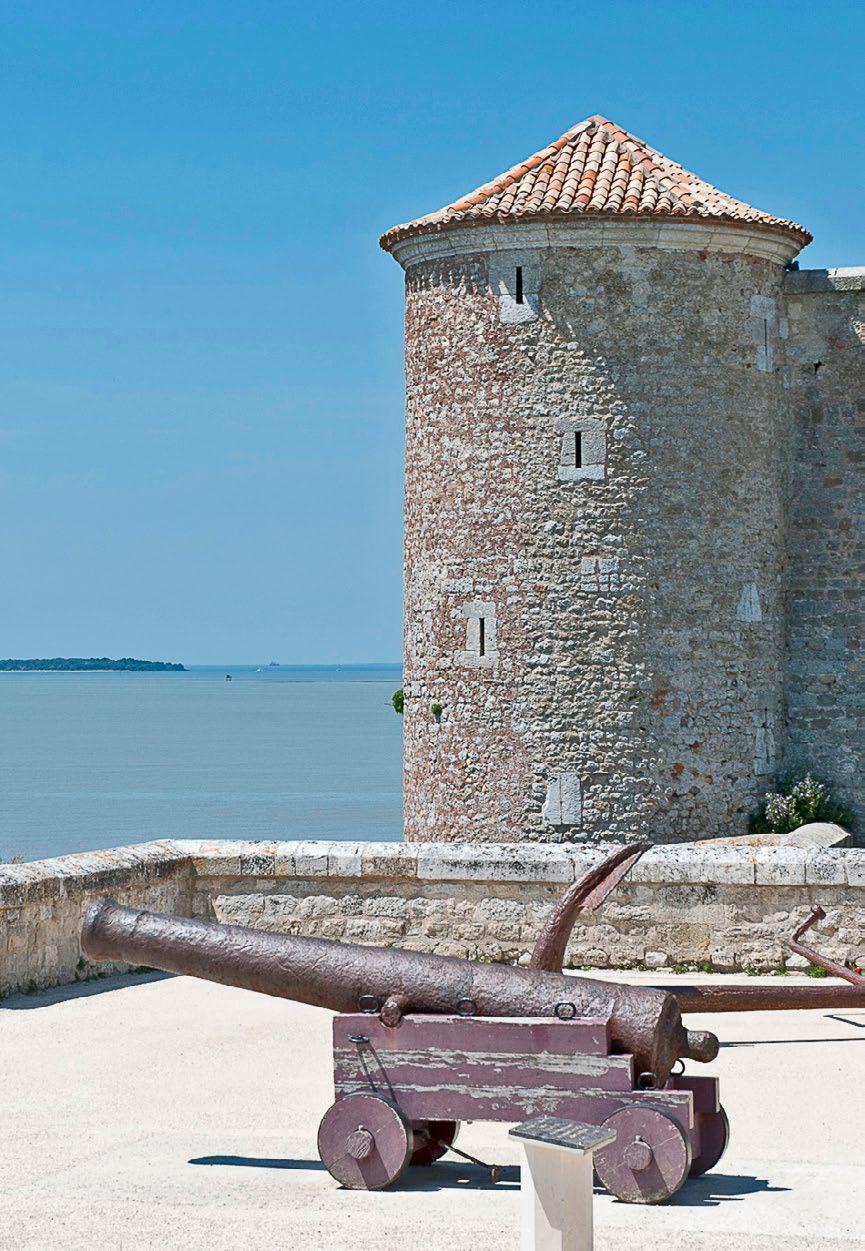



Below La Rochelle the coast road passes Angoulins and Châtelaillon Plage, a family resort created during the 19th century by the SNCF railway company. It has a fine sandy beach, boutiques, bars and restaurants plus paddle-board and sailing boat hire. In the nearby marais d’Yves wetland nature reserve countless bird species including African White Storks and Egrets share some 192ha with Scottish blackface sheep. Inland from Angoulins at La Jarne is the perfectly preserved 17th century Château de Buzay, a testament to the great prosperity generated by the port of La Rochelle.
A few km down the coast, poised on a slender peninsula on the northern extremity of the Charente estuary, lies Fouras-les-Bains. Fouras has been a fortified stronghold for almost 1,000 years, deterring Barbarian, Norman, Dutch and English sea-borne invaders (not to mention occasional pirates) and the sandy shoreline is still dominated by the impressive Fort Vauban (right). The monolithic 15th century donjon witnessed the Siège of La Rochelle in 1627/8 before acquiring a sophisticated network of outer defences designed by two of France’s greatest military engineers –
Fouras has sandy beaches and an impressive fortress
the Marquis de Vauban and François Ferry. It later served as a semaphore station and now houses a museum of local history. During the 1880s the fortified fishing village became a fashionable seaside resort, with a mild, sunny climate, sandy beaches and evergreen oak forest. Soon villas and even a casino appeared, and today Fouras-les-Bains continues to charm summer visitors.
Out on the rocks just off the tip of the peninsula is the Fort d’Enet, built between 1810 and 1812 by order of Napoléon and only accessible at low tide, via a 1.8km causeway. Visible beyond it, the Île d’Aix is served by passenger boats from Fouras or Port des Barques, on the southern tip of the Charente river.
Châtelaillon Plage has sailing and paddle-boarding

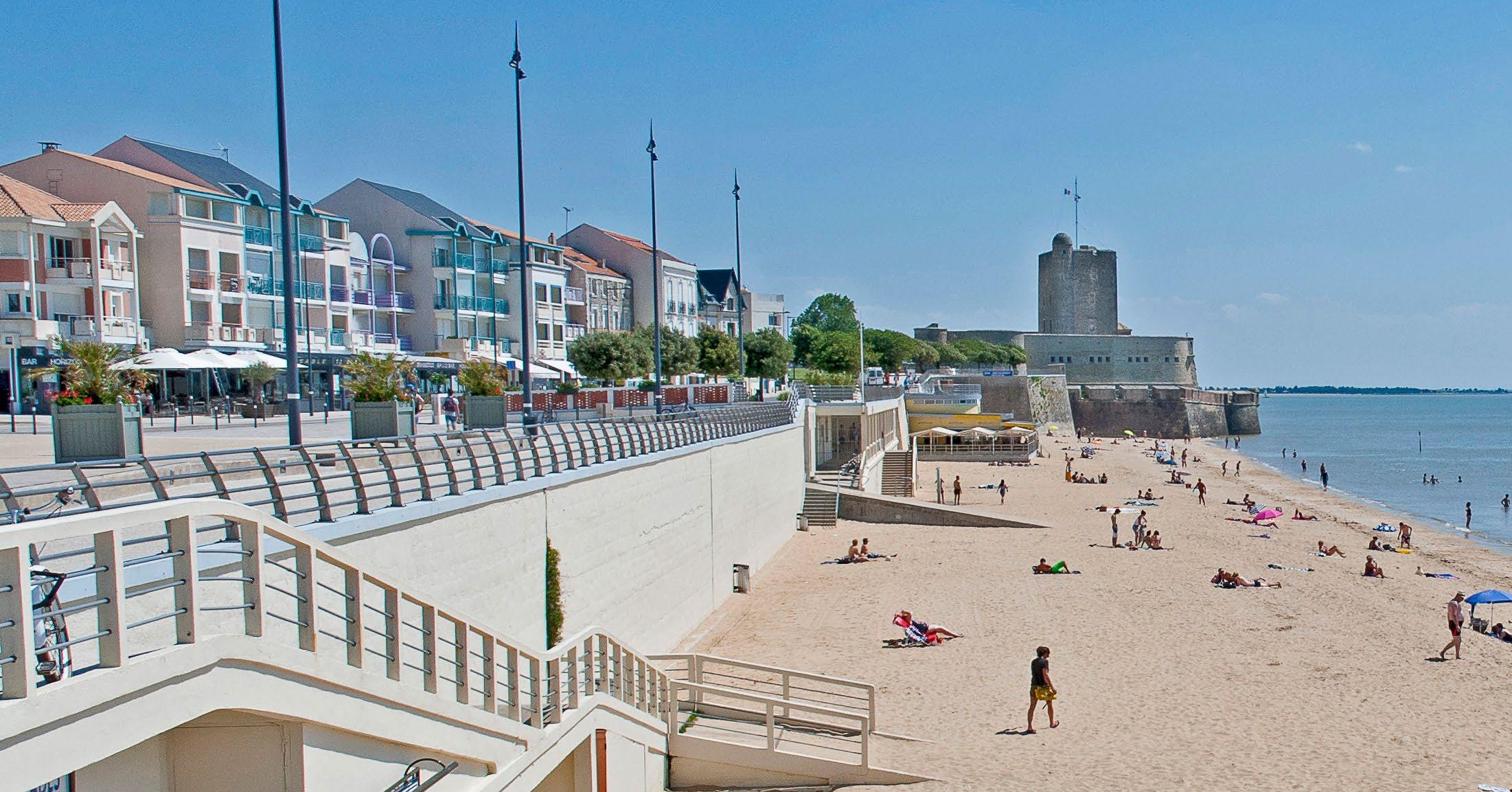
www.livingmagazine.fr
TYING-UP IN ROCHEFORT
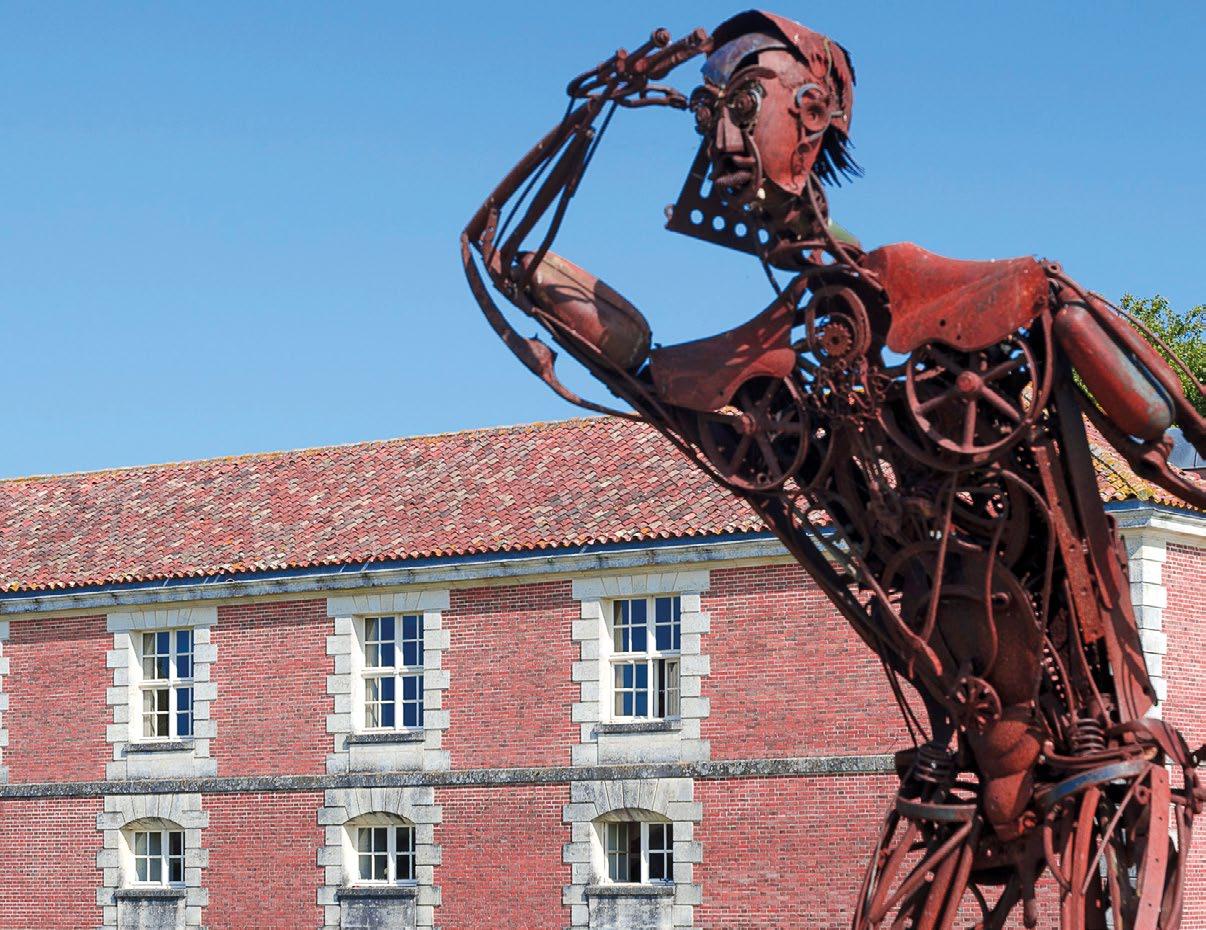
In the 17th century Louis XIV decreed that Rochefort should become France’s most important maritime arsenal and dockyard, to be constructed with military precision and innovation. Its elegant boulevards, for example, followed an octagonal plan, allowing sea breezes to cleanse the town of dust and smoke from dockyard activities. Much of the original street layout and elegant architecture remain, making this a truly fascinating place to explore.

The celebrated Corderie Royale (Royal Ropeworks) completed in 1666 has been dubbed ‘the Versailles of the Seas’ and is long enough for entire lengths of rope needed to rig tall ships. It now hosts maritime exhibitions, hands-on rope-making demonstrations, a bookshop and restaurant. The nearby former dockyard constructed the replica frigate Hermione, which crossed the Atlantic in 2015, commemorating her predecessor’s historic voyage in 1780 to aid the American War of Independence. She is currently undergoing extensive (amd expensive) repairs in Bayonne and a return date has not been confirmed. When she does return, Hermione will pass under the Pont Transbordeur de Rochefort, France’s very last transporter bridge. It’s recently undergone major renovation work and you can discover the fascinating history of this vast mechanical wonder at the Maison du Transbordeur.

Below Rochefort is Brouage, in medieval times Europe’s most important salt-trading port. During the siege of La Rochelle in 1628 it became the Royal Arsenal, before being transformed into a sophisticated citadel with a garrison of 6,000 troops. However, as the port silted up and the sea retreated it found itself surrounded by marshland. Today the birthplace of Samuel Champlain (founder of Québec) preserves many of its original defensive features, and is home to artists and craft workers.
Southwest of Brouage lies La Tremblade, which in the 1730s was building sturdy 500-ton vessels for fishing off Newfoundland. The cottages of mariners, fishermen and salt merchants survive (along with the boats and colourful cabins of local oystermen), contrasting with neighbouring Ronce-les-Bains’ chic coastal villas. You’ll find perfect peace on the Côte Sauvage, a protected stretch of coastline just to the north of the town. It’s simply beautiful, with endless white sand beaches, crashing waves, dunes, maritime pine forests –and not a village or town in sight.
| Page 7
Samuel Champlain keeps watch at Brouage
Rochefort’s Corderie Royale
IN & AROUND STYLISH ROYAN






Strolling among Royan’s stylish architecture, you might wonder whether you’ve stumbled onto a classic French film set. The 1950s market hall is shaped like a vast scallop shell, and daily markets here are among Charente-Maritime’s finest (particularly before 10am). Harder to ignore is Royan’s main church, L’Eglise NotreDame, a defiantly modernist creation built between 1952 and 1956 using prestressed concrete. Inside the nave soars as high as that of Notre-Dame de Paris.
Royan’s main beach is a glorious expanse of pale sand known as La Grande Conche. Stroll or cycle beside it on the Boulevard Frédérick Garnier, past a dazzling succession of showpiece coastal villas, from elegant Belle Époque to sharp contemporary. Royan’s surrounding coastal scenery is also worth exploring. The Chemin Douanier (customs walk) reveals sandy beaches, secluded bays and Belle Époque mansions. Follow this shoreline path from the port up to Grande-Côte, via Vaux-sur-Mer and Saint-Palais-sur-Mer, or cycle through shady pine forests among coastal parkland.
Just below Royan lies a modest headland, beyond which you’ll come to Saint-Georges-de-Didonne, whose tiny sheltered port is overlooked by a 29m-high lighthouse and a memorial to the Royal Navy’s WWII Cockleshell Heroes. Beyond the port are more sheltered sandy beaches en-route to Meschers-sur-Gironde Fringed by oak and pine forests, this typical fishing village possesses ancient caves (caves troglodytiques) formed by the sea eroding the pale cliffs. For centuries they provided hiding places, first for pirates and shipwreckers and then Protestants during the Wars of Religion.
Nearby is another essential visit. The beautiful Romanesque Eglise Sainte-Radegonde sits defiantly beside a sheer cliff face at Talmont-sur-Gironde (below). Built by Edward I of England with echoes of the bastide towns of Aquitaine, the 13th century fortified town is a delight to explore. Round off your visit to the Royan area with a boat ride out to one of France’s oldest working lighthouses, the magnificent 16/18th century Phare de Cordouan, recently awarded UNESCO heritage status (right). Climb 300 or so steps for breathtaking views from the 67m-high summit.

www.livingmagazine.fr Living Magazine Summer Guide 2023
You’ll be whisked away by a mind-blowing storm in Chasseurs de Tornades, the only attraction of its kind in the world. 2022 Park World Excellence Awards & THEA award.

You’ll awaken the adventurer within, and become an astronaut in the Destination Mars space training centre. Thrills guaranteed!
With The Extraordinary Journey, you will fly around the world with your legs dangling free. As evening falls, you’ll dream with the new evening show, included in the price of admission!
Your curiosity will take you into a spectacular world!

-7€(1) per pers.
(1) The voucher is valid for Adults (aged 13 and over) and children (aged 5 to 12), exclusively for a 1-day dated-entry ticket purchased on the day of visit (i.e. 45€/adult down from 52€ - 36€/child down from 43€) and must be handed in at the Futuroscope ticket booths between 1 st June 2023 and 7 th January 2024* (single-use voucher - 1 to 5 visitors only per voucher, for a visit on the same day).

Discount does not apply to other ticket types, dated-entry tickets booked in advance, undated tickets, or Group tickets. Offer cannot be applied retroactively or combined with other offers.
*Check the opening dates calendar on futuroscope.com futuroscope.com

Glory ParisD LAMING, Architecte Futuroscope NEW ATTRACTION
*R0021723LGFP*
Longing to get away from it all..? Just off our sunny Atlantic coast lie four islands, each with its own personality. The Île de Ré, Île d’Oléron, Île d’Aix and the tiny Île Madame are havens for walkers, cyclists and beachlovers...

Île d’Oléron’s distinctive oyster fishermen’s cabins




ISLAND ESCAPES

ÎLE D'OLÉRON
France’s largest island (after Corsica) is blessed with hugely varied landscapes, from pine forests, marshland, sand dunes and salt beds to rugged cliffs and long, pale sandy beaches. In summer the sea breezes are heady with the scent of mimosa and oleander. The many beaches are of fine, pale sand, so it’s easy to find a perfect spot to relax. Two beaches with natural settings plus useful amenities (cafés, etc.) are la Plage de Gatseau (near SaintTrojan, in the east) and la Plage de Planginot (near la Brée-les-Bains, to the north).
Stretches of Grande Plage, another popular beach on the west coast, are reserved for naturists, while areas facing the Atlantic are great for surfers.
With such varied landscapes, the Île d’Oléron just begs to be explored, and if you follow the coast you’ll enjoy a succession of constantly changing sea views. To see things very differently climb the 224 steps to the top of an impressive lighthouse at Pointe du Chassiron (on the north of the island) and you’ll be rewarded with a truly breathtaking panorama of the coastline.
Inland, the landscape becomes marshy and is drained by waterways, where oyster nets hang above muddy banks. There are forests, too, with oaks and maritime pines, not to mention mimosa and feathery pink tamarisk.
Cycling is a popular way to see the island – it‘s easy to rent bikes and go your own way or join an organised tour. The tourist office has details.
The Marais aux Oiseaux bird sanctuary was founded as a hospital for injured wild birds but now has a mix of both wild, domesticated and caged birds. More than 300 species have been cared for, including egrets, spoonbills and the rarely glimpsed kingfisher of the marshes. You’re also likely to see deer.
To see a typical Oléron village with colourful cabins and bobbing boats take a trip to Port des Salines. You’ll find oyster farmers, as well as the salt pans being worked for sea salt, another thriving island industry. If you feel like seeing the marshes from the water you can hire a rowing boat. Alternatively, keep your feet firmly on dry land and explore the network of signed footpaths.
www.livingmagazine.fr Living Magazine Summer Guide 2023
ÎLE DE RÉ
The Île de Ré combines island appeal with a touch of French chic. Local people – ‘les Rétois’ – are proud of island life, their whitewashed villages, profusion of hollyhocks and near-endless beaches caressed by a turquoise sea.
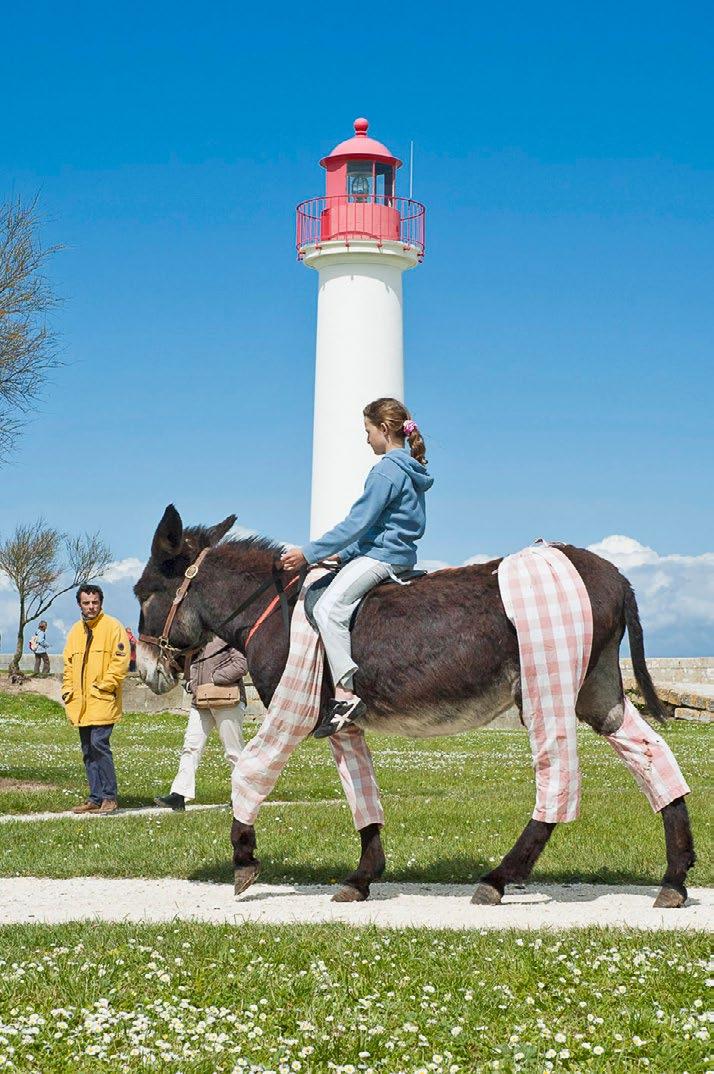
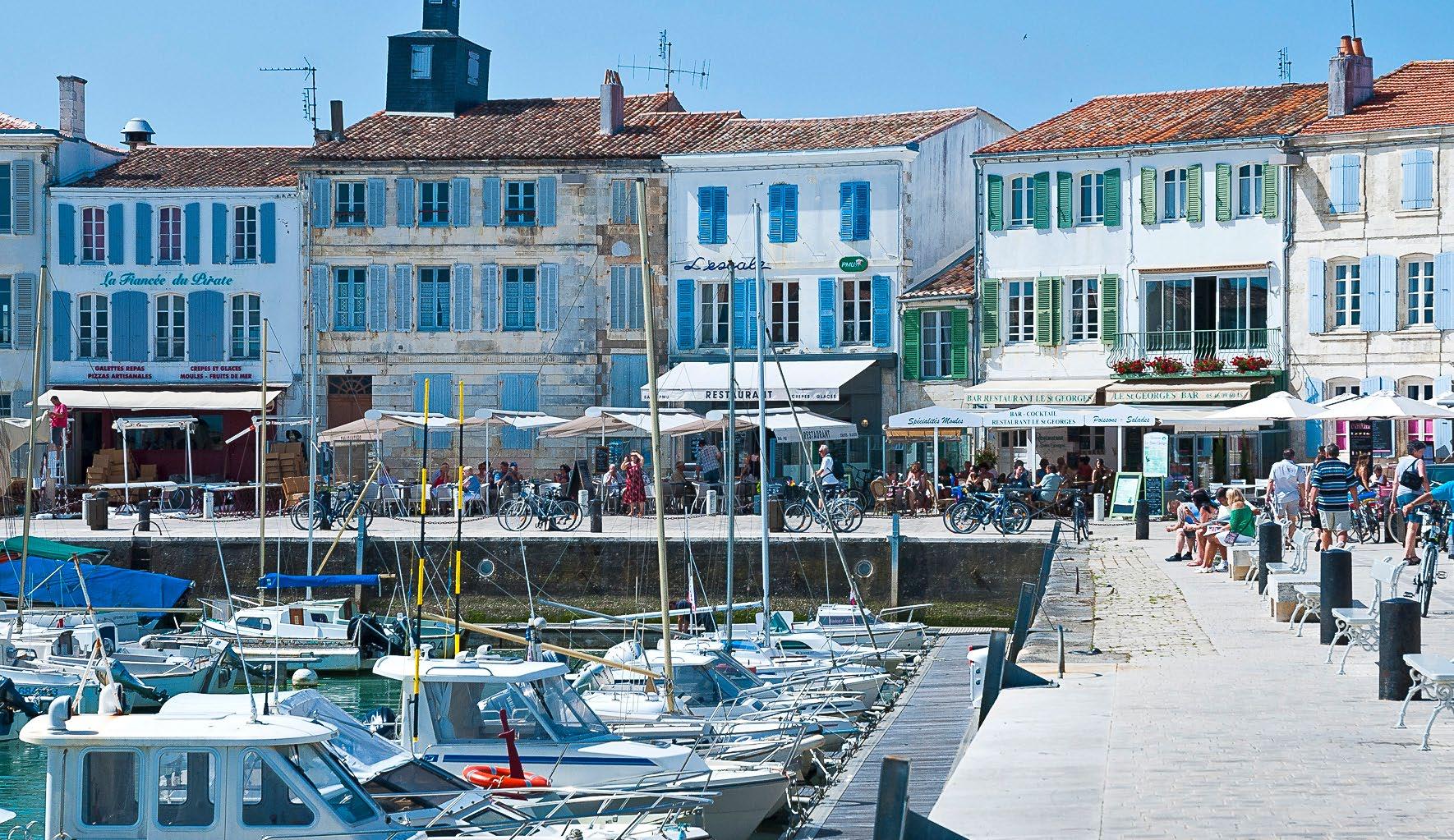
The best beaches (many with children’s clubs) are in the south, Le Bois-Plage being deservedly popular. For more seclusion head SW, near the Phare des Baleines lighthouse, or to the craggier northern beaches (great for rock-pooling). You can also enjoy sailing, surfing, windsurfing and more – the local tourist offices know all the best spots.
Exploring the many picture postcard villages is great fun. You can drive, but island roads weren’t made for heavy traffic. A greener, more relaxing way to get around is by bike – there are well-signed cycle routes, plus cycle hire points all over the island.
Saint-Martin-de-Ré, for over 400 years the island’s main town, is an essential visit, with boutiques, cafés, restaurants and brightly-coloured boats in the harbour. Historically a target for coastal conflicts, the town was fortified, and the ramparts are great for scenic walks, while children love riding the famous ‘donkeys in pants’. Traditionally the animals’ legs were
covered while working in the salt marshes.
Ars-en-Ré, a pretty port set beside traditional white cottages with green shutters, is officially one of the Most Beautiful Villages in France. Its tall church spire is painted black and white to provide a day-mark for mariners – in summer you can climb to the base of the spire to see the bell chamber and enjoy panoramic views of nearby forests and oyster beds.
On the north coast, La Flotte en Ré (another of France’s Most Beautiful Villages) has a port filled with small sailing and fishing vessels. It too has a colourful history – the Fort de la Prée, built in 1626, is the island’s oldest defensive site and played a major role in battles with English forces.
L’Abbaye des Châteliers, built in the 12th century by Cistercian monks, was pillaged and burnt, but is now lovingly restored. Children’s treasure hunts explore the village and the seashore – enrol at La Maison du Platin.
On the western tip of the island is the 55m-high Phare des Baleines, France’s second oldest lighthouse, built in 1855. Climb 257 stone steps to the top for fantastic views of the Vendée coast, the Breton straits and surrounding marshland. The oldest lighthouse title goes to the nearby Saint-Clement-des Baleines, built in 1682.
| Page 11
Quai de Sénac, La Flotte en Ré
ÎLE MADAME


The smallest of the islands is Île Madame, accessible only during low tide from Port des Barques, via a slender causeway (‘La Passe aux Bœufs’), adding a real sense of adventure to the visit. Although just 1km long and 600m wide, its strategic location opposite Fouras, at the mouth of the Charente estuary, meant that in 1704 Île Madame acquired its own military fort, built to reinforce nearby Rochefort’s defences. The tiny island’s history also recalls a sad event in 1794 (the Revolution, saw it briefly renamed l’Île Citoyenne) when 275 exiled priests starved to death and were simply buried where they fell. A white cross of pebbles (la Croix de Galets) marks their mass grave. Today, in happier times, you can visit the island’s Ferme Aquacole to see oyster and sea-salt production, along with small scale organic farming. There’s also a restaurant, a well-stocked gift shop plus B&B accommodation, in the privileged setting of this peaceful spot.
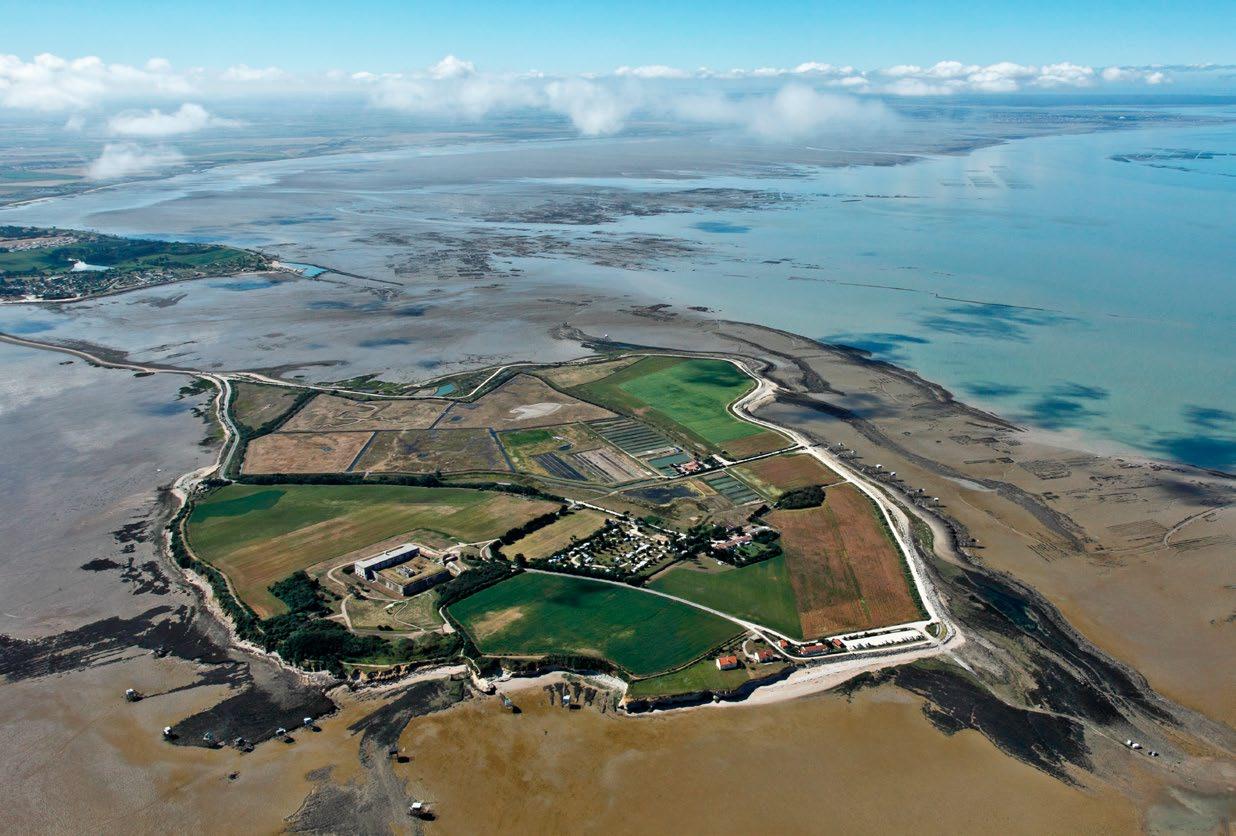
ÎLE D'AIX
Stepping ashore on the peaceful Île d’Aix today (above and right), it’s hard to imagine that the island hasn’t always been so relaxed. Its strategic position attracted the attention of France’s greatest military engineer Vauban, who planned the village in 1669. Napoléon Bonaparte visited in 1808 and ordered the construction of an indestructible fortress, the star-shaped Fort Liédot, built between 1810 and 1834. Take a guided tour and you’ll learn about the fort’s role in coastal defences, and see poignant inscriptions made by Russian soldiers imprisoned here during the Crimean War. On the south of the island, in the village known as ‘le bourg’, you’ll find the imposing house (now a museum) where the Emperor spent his final days on French soil before going into exile. The Musée Napoléon preserves his room just as he left it, providing food for thought when you gaze from the nearby sandy beaches to the offshore wonder that is Fort Boyard. Begun by Napoléon in 1804, the fort was completed over 50 years later in 1859 (under Napoléon III) and is now world famous as a TV show location.
You can’t visit the fort, but passenger boats to the Île d’Aix often make a point of circling it en-route – if the idea appeals, check this when you book.
Despite being just 2km long, Aix packs in rocky coastline, sandy beaches plus forests of pine and evergreen oak. There are many coves, and the best-known beach is Grande Plage, on the western side. Children can hunt for shellfish at Plage aux Coquillages, while windsurfers favour Plage de l’Espérance. Cars aren’t permitted, so it’s easy to explore it all on foot or by locally hired bikes. You can get to the island via passenger boats from Fouras or Port des Barques.

Living Magazine Summer Guide 2023
Île Madame is accessible by causeway at low tide
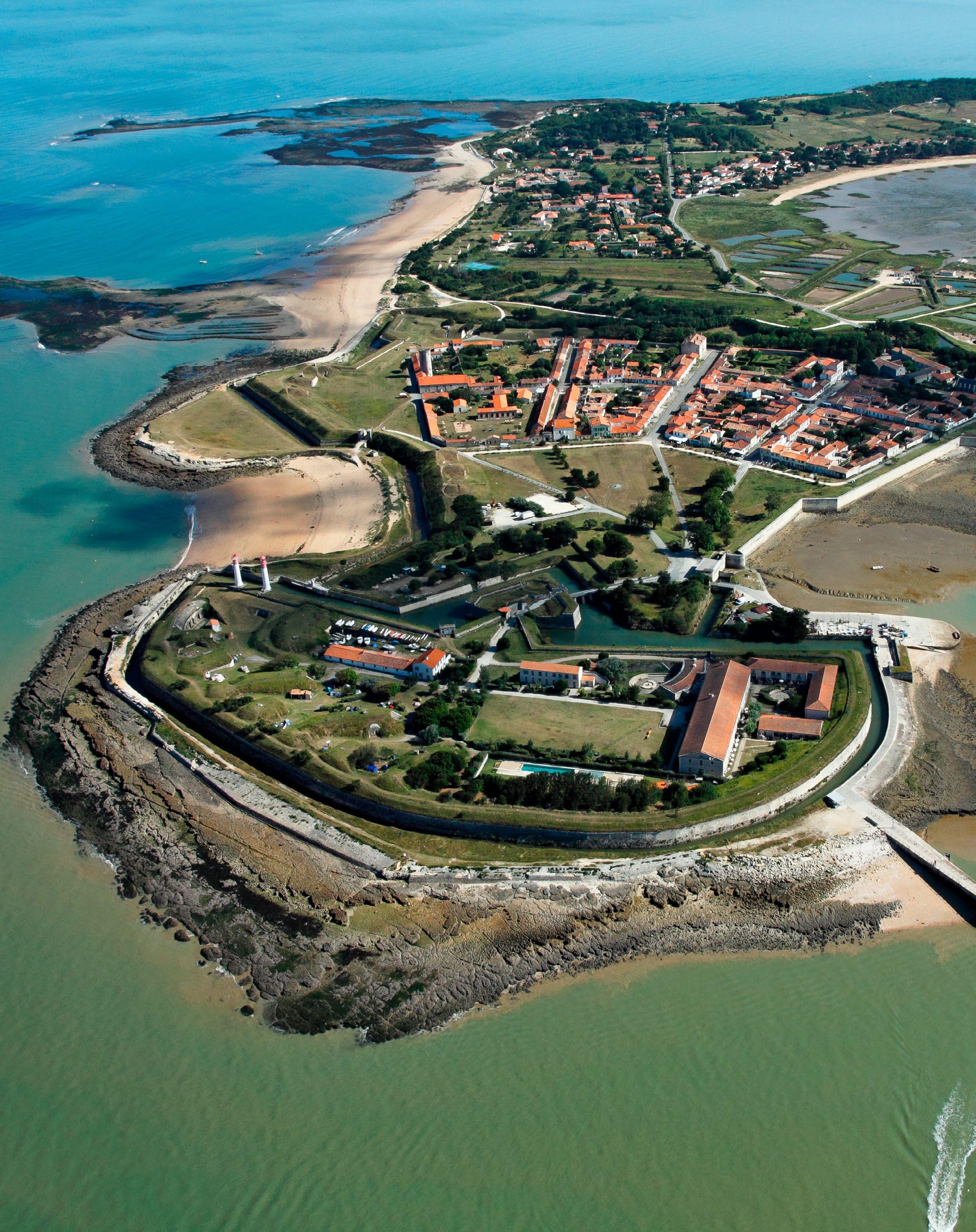
TOP BEACHES
BEST FOR KIDS
SAINT PALAIS-SUR-MER & GRANDE CONCHE, ROYAN
Five km of safe sandy beaches linked by a coast path. In summer there are kids’ clubs, swimming and sailing clubs, and you’ll find cafés and restaurants nearby. Largest is the Plage de La Grande Côte, with 2.5km of golden sand stretching from Saint Palais-sur-Mer to La Palmyre. Also worth discovering is the 2km-long sandy beach of Grande Conche, Royan, with plenty of space, chic stripy tents and free parking (in August finding a space can be difficult, but there are facilities for cyclists). The beach has lots of services and is ideal for families.
GREAT FOR SURFING
LA PALMYRE
The delightfully unspoilt 5km-long beach north of Royan is part of the Côte Sauvage, and is a big-wave magnet. It’s therefore a popular choice for surfers, as is la Plage de Vert Bois, near Dolus d’Oléron.
NB: These fine surfing beaches do not have lifeguard patrols.
PEOPLE-WATCHING
PLAGE DES MINIMES
Close to La Rochelle, and for the beaumonde, it’s the place to be on warm evenings and at weekends. There are views of the nearby lighthouse, and the relatively narrow sands get a daily wash, keeping them pristine.
AWAY-FROM-IT-ALL
PLAGE DES SAUMONARDS, ÎLE D’OLÉRON
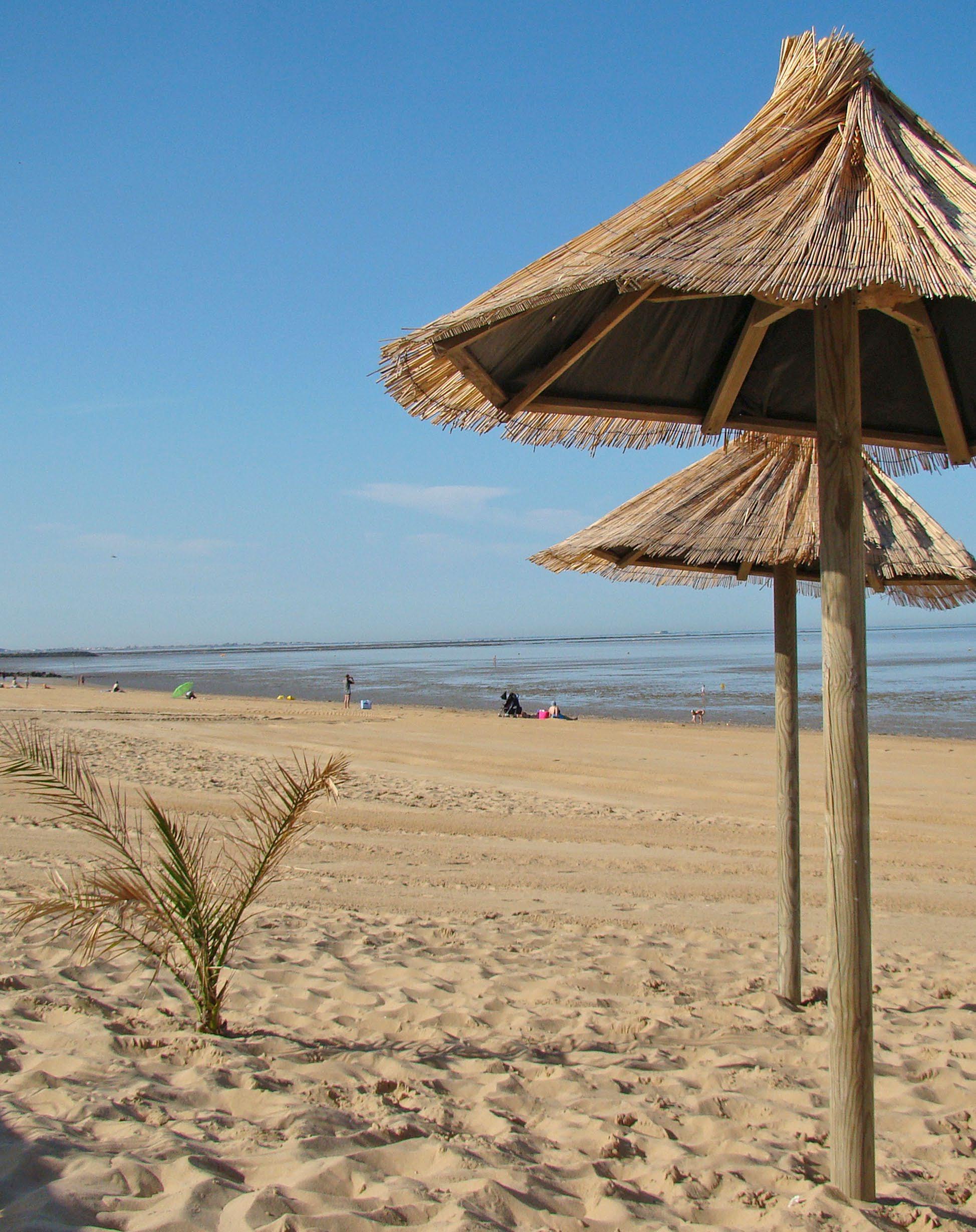
This 8km-long sandy beach is tucked away beyond dunes and pines, and is best reached by bike from Boyardville. Part is naturist designated, so if your style is more modest, just stick to the more family-friendly eastern section.
ISLAND BEACH
LE BOIS PLAGE-EN-RÉ, ÎLE D’RÉ
A glorious stretch of the Île de Ré’s best sandy beaches, extending for 6km on the western coastline. It has the Pavillon Bleu label, awarded for water quality, beach cleanliness, lifeguard patrols, disabled access and nature conservation. Fringed by sand-dunes and woodland, the beach also hosts a range of summer activities and is a good choice if you’re cycling, as you won’t have to arrive early to find a convenient parking space. Finally, the island’s most important daily market is close by.
EASY ACCESS
CHÂTELAILLON PLAGE & SAINT-GEORGES-DE-DIDONNE
South of La Rochelle, with a Handiplage award for welcoming those with disabilities (an amphibious wheelchair is available), there are also lots of children’s activities. The 3km of beach has a backdrop of stylish Belle-Époque architecture. Another easily accessible beach is the sheltered Grande Plage, at SaintGeorges-de-Didonne, below Royan.
© CMT17 E.
Ideas to help you find the perfect spot...
COEFFE
PLAN YOUR FUN-FILLED SUMMER WITH OUR FREE ONLINE EVENTS GUIDE


Château de Crazannes is known locally
by its nickname ‘Château du Chat Botté’
REMARKABLE ABBEYS CHATEAUX&GARDENS

Ancient abbeys, noble châteaux and beautiful gardens are fascinating to visit and your entry fee contributes to the upkeep of those which remain in private hands.....
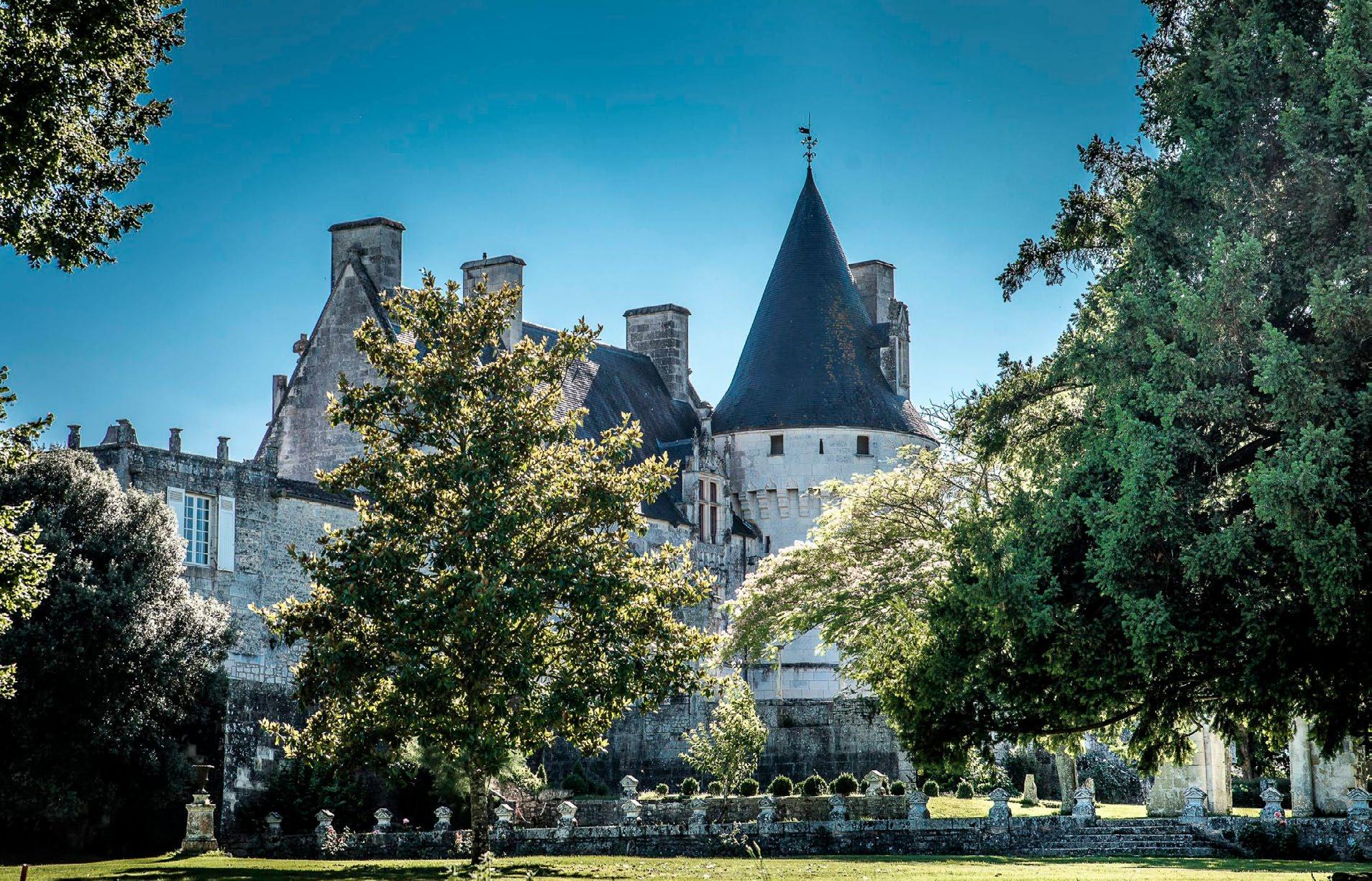
CHARENTE-MARITIME (17)
ABBAYE ROYALE

17400 SAINT-JEAN D’ANGÉLY
The skyline of Saint-Jean d’Angély is still dominated by the two monumental towers and western façade of an ambitious Baroque abbey begun in 1741 and never completed. Nevertheless, it’s listed by UNESCO as a World Heritage Site, and there’s lots more to see in the medieval heart of the town.
angely.net


ABBAYE DE FONTDOUCE
17770 SAINT BRIS DES BOIS
This restored 900 year-old abbey has stunning Roman cellars and chapels concealed underneath and behind a 19th century manor house. Set in a beautiful parkland setting in a valley with formal gardens and a family adventure area, there are hiking trails and activities planned throughout the summer.
fontdouce.com

www.livingmagazine.fr
Gothic elegance at the
© PHILIPPE SÉBERT
Abbaye de Fontdouce
CHÂTEAU DE CRAZANNES
17350 CRAZANNES
This 14th century château was built on the site of an earlier fortress whose chapel and donjon still survive. Among its illustrious guests were the Black Prince and King François I of France. There are fairytale turrets and an elaborately carved entrance, but inside it’s lavishly decorated and furnished. There are regular guided visits and medieval costume re-enactments.
chateaucrazannes.fr
CHÂTEAU DE DAMPIERRE
17470 DAMPIERRE SUR BOUTONNE
This 16th century château’s romantic setting on an island is quite magnificent. The elegant Renaissance architectural features include arched loggia galleries and an elaborately sculpted ceiling. The award-winning gardens include a classically inspired labyrinth maze.


chateaudampierre.fr
ABBAYE AUX DAMES
17104 SAINTES
This huge former Benedictine abbey, consecrated in 1047, now serves as a musical complex (right) which hosts
the renowned annual Festival de Saintes. Explore the abbey and enjoy Musicaventure, a sensorial experience based around music.
abbayeauxdames.org
ABBAYE DE TRIZAY & LES JARDINS DE COMPOSTELLE
17250 TRIZAY
Saved from ruin by a recent restoration, the 11th century Benedictine abbey features a Romanesque chancel, medieval garden and contemporary art exhibition. The nearby Hispano-Moorish inspired gardens are set over 2 hectares leading down to the lac de Bois Fleuri. They hold regular events throughout the summer season.
abbayedetrizay17.fr
CHÂTEAU DE LA ROCHE COURBON
17250 SAINT PORCHAIRE
Having chanced upon this 15th/17th century château lying abandoned and overgrown, French writer Pierre Loti launched a public appeal, prompting a local man (whose descendants still live there to this day) to purchase and restore it.
Marvel at the ornately decorated interiors and award-winning formal French-style gardens. The listed gardens retain elegant statuary – don’t miss the views from above the Italianate water cascades across the lake towards the château.
Learn how the whole estate was created amid unstable coastal marshland. There’s also a children’s area with traditional games. Stone Age cave dwellings and prehistoric finds can be explored in the grounds, adding a unique historical dimension to the visit.
larochecourbon.fr
| Page 17
Exquisite Renaissance gardens ©
SEBASTIEN LAVAL
at the Château de La Roche Courbon
JARDINS DU PHARE DE CHASSIRON
17650 SAINT-DENIS D’OLÉRON
A lofty bird’s-eye view of the garden is just one of the factors which make the Chassiron lighthouse garden remarkable. Styled around the lighthouse like a compass rose are a contemporary ornamental garden and a traditional garden with vines, roses and a potager. The Lighthouse Museum creates the impression of being in mid-ocean. Gardens are accessible to those with reduced mobility.

st-denis-oleron.com
JARDINS DE LA BOIRIE
17310 SAINT-PIERRE D’OLÉRON
A huge selection of ornamental plants, trees and shrubs flourish in the Île d’Oléron’s mild climate. Gardeners will find lots of inspiration in tranquil settings which burst with colour.
lesjardinsdelaboirie.com
CHÂTEAU D’OLÉRON
17480 LE CHÂTEAU D’OLÉRON
A strategic naval post since the 12th century, the citadel was built on the site of a medieval fortress by order of Richelieu after the siege of La

13th century fortifications surround
the Château de Villebois-Lavalette
Rochelle. Despite wartime damage, the fortifications are well preserved and five rooms are open to visitors.
ot-chateau-oleron.fr
LA BAMBOUSERAIE BRISSON
17160 MATHA


Exotic bamboo garden offering guided tours (by reservation) with over 60 varieties on show. Visit this year as the garden will close at the end of the season.
bambouseraie-brisson.com
CHARENTE (16) CHÂTEAU DE LA ROCHEFOUCAULD
16110 LA ROCHEFOUCAULD

The striking outline of this substantial chateau still dominates the skyline. Dating from 980, much was rebuilt in the 11th and 18th centuries, creating an unusual mix of a sternly robust feudal keep married to fairytale style turrets, elegant cloisters and a graceful spiral staircase. Children will love the dressing-up room.
chateau-la-rochefoucauld.com
www.livingmagazine.fr Living Magazine Summer Guide 2023
Jardins du Phare de Chassiron
CHÂTEAU DE VILLEBOIS- LAVALETTE
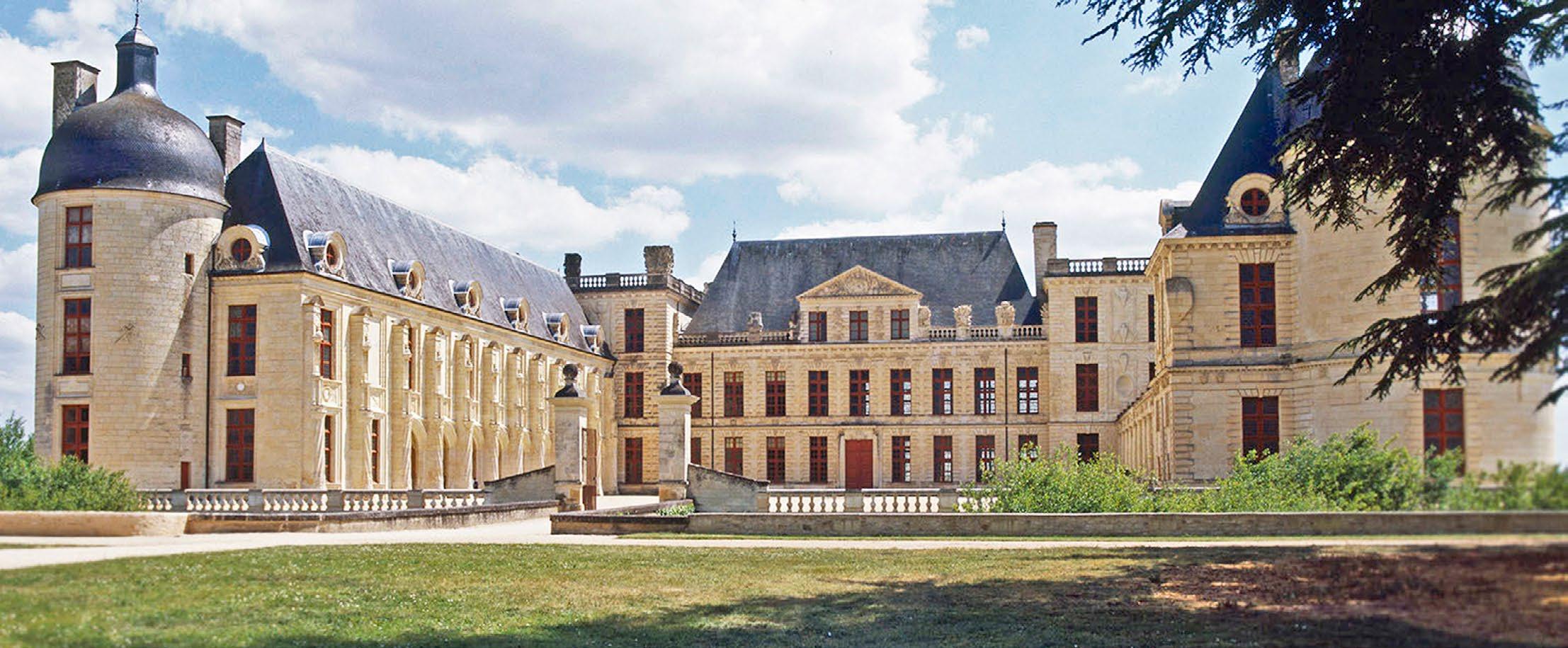
16320 VILLEBOIS-LAVALETTE
Seven towers enclose a 13th century fortified courtyard. Visit the 12th century chapel and contemplate panoramic views. Excavations are uncovering historical artifacts dating back to the Middle Ages. chateaudevilleboislavalette
JARDINS DU CHAIGNE
16120 TOUZAC
Bordered by the Grande Champagne region’s productive vineyards, these formal gardens display French elegance and refinement.
jardinsduchaigne.com
CHÂTEAU DE LA MERCERIE
16320 MAGNAC-LAVALETTE-VILLARS
Dedicated volunteers are patiently restoring for future generations an amazing, long abandoned Versaillesstyle showpiece right (complete with rose garden).
chateaudelamercerie.fr
JARDINS DU LOGIS DE FORGE
16440 MOUTHIERS-SUR-BOËME
The 14th-18th century logis and paper mill sit beside a lake in a charming setting
among wooded hills. The garden was inspired by the owners’ visits to Japan. Green and full of wild flowers, there are water features and varied perspectives.
jardinsdulogisdeforge.com
CHÂTEAU DE ROCHEBRUNE
16150 TAGNAC
Seat of the Lords of Chabanais during the 11th and 13th centuries, this classic château has four round towers and a moat. In the 19th century owner General Count Dupont fought for Napoléon Bonaparte, and his souvenirs are displayed.
infiniment-charentes.com
DEUX-SEVRES (79)
CHÂTEAU D’OIRON
79100 OIRON
Most of this magnificent Renaissance château was built during the 16th century by François 1’s Advisor Artus Gouffier. He was an art connoisseur, and established a tradition which continues to this day. The Italianate interiors include one of the most impressive galleries in France. Their exquisite decoration features large mid16th century Classically-themed paintings, and there’s also a renowned museum of modern art.
chateau-oiron.fr
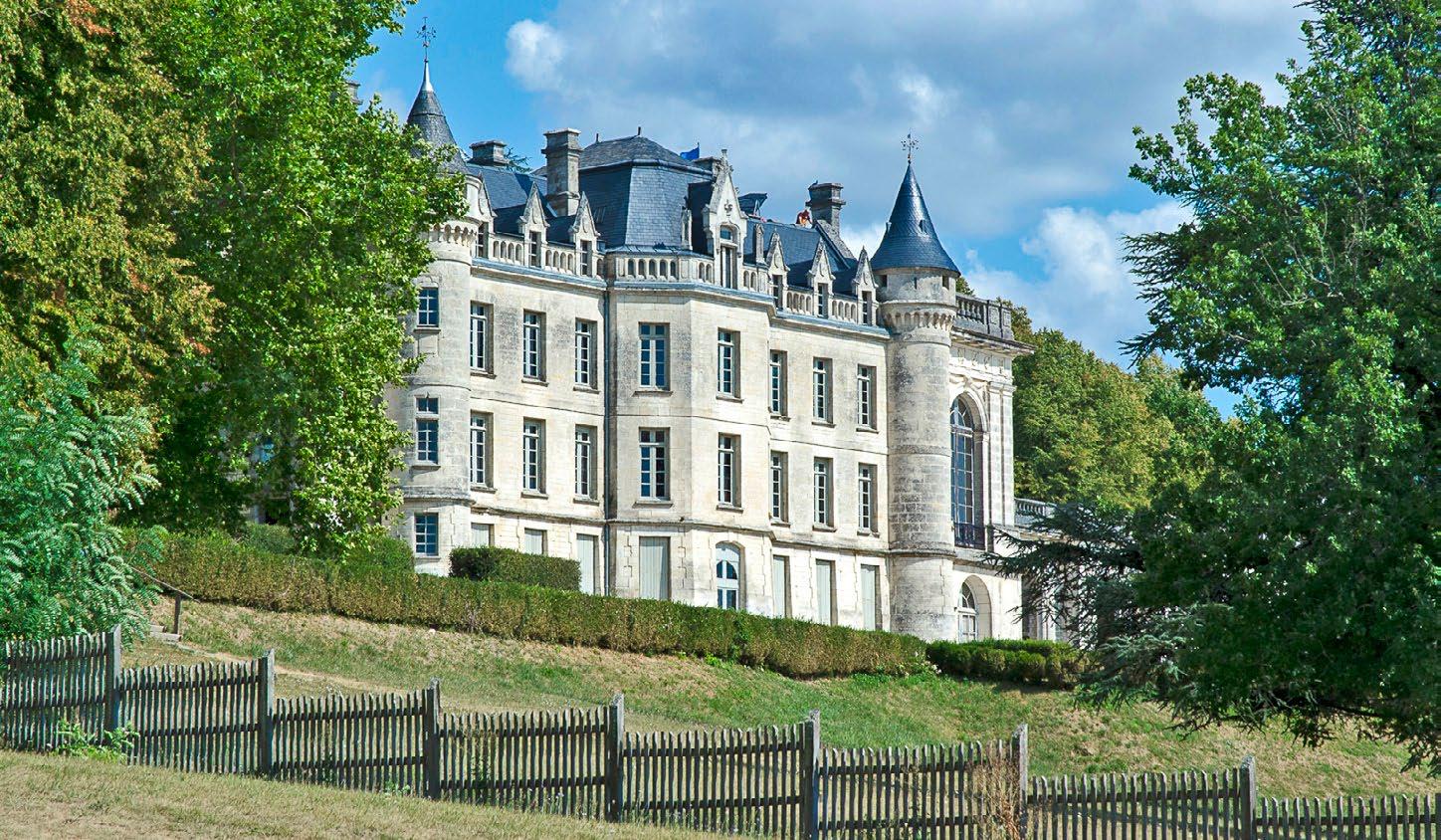
Château de’Oiron contains
fabulous art collections
| Page 19
CHÂTEAU DE SAINT-MESMIN
79380 SAINT-ANDRÉ-SUR-SÈVRE
Begun in the 14th century, with a magnificent 28m-high keep plus a courtyard surrounded on three sides by farm buildings added 300 years later. Summer events include colourful costume re-enactments from medieval life in the château plus music, dancing, etc. chateau-saintmesmin.com
CHÂTEAU DE JAVARZAY
79110 CHEF-BOUTONNE
This pale stone beauty in the market town of Chef-Boutonne was one of the very first Renaissance châteaux in Poitou (below). Completed around 1515, it was owned by several noble families before suffering virtual abandonment after the French Revolution. Now it has been beautifully restored to its former glory.

chateau-javarzay.fr
ABBAYE ROYALE DE CELLES-SUR-BELLE
79370 CELLES-SUR-BELLE
This magnificent 17th century abbey opens its gardens, cloisters, refectory,
kitchens and courtyard to visitors, who can also visit the Romanesque crypte of the 12th century of the Eglise SaintHilaire. Its cathedral-like replacement, the adjoining abbey church, is well worth seeing, as is the museum of the bygone age of motorcycling in the Espace Collections Motos Anciennes.
abbaye-royale-celles.com
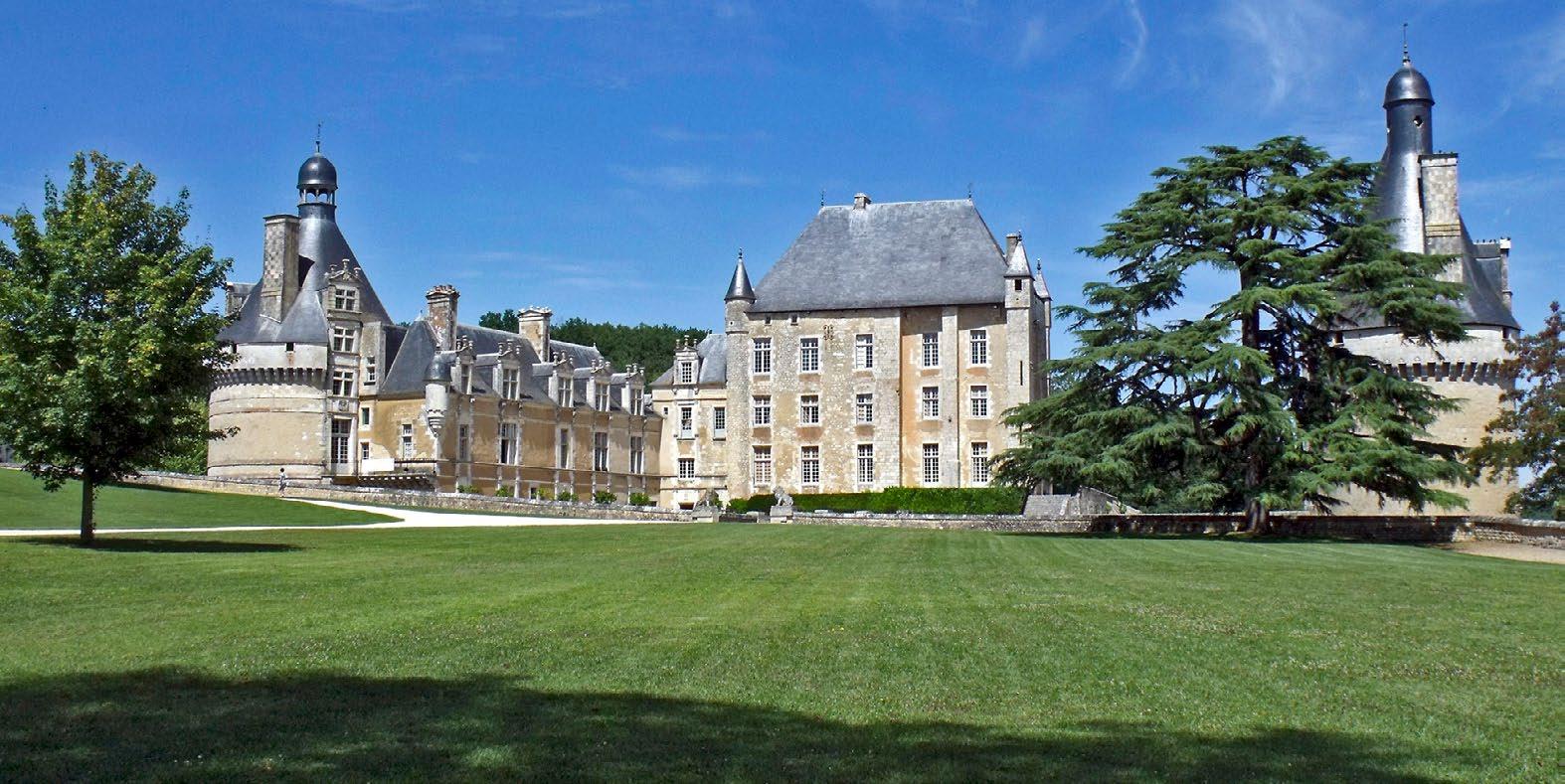
ARBORETUM DU CHEMIN DE LA DÉCOUVERTE
79500 MELLE
A circular discovery trail passes celebrated ancient silver mines (Mines d’Argent des Rois Francs) plus some of Melle’s many historic buildings. The full 6.5km chemin has 1,800 trees and 250 rose varieties.
bit.ly/MelleArb


JARDINS DU GUÉ
79390 LHOUMOIS
This ‘Jardin Remarquable’- listed park on the banks of the Thouet river covers 4 Ha and has 7 beautiful themed gardens. Riverside picnics allowed.
jardinsdugue.eu
CHÂTEAU DE SAINT-LOUPSUR-THOUET
79600 SAINT-LOUP-LAMAIRÉ
Primarily now used as an event venue, the gardens can be visited - check website for opening times.
chateaudesaint-loup.com
VIENNE (86)
CHÂTEAU DE TOUFFOU
86300 BONNES
Set romantically beside the Vienne river, this beautifully maintained 1215th century château is surrounded by landscaped gardens listed as ‘Jardins Remarquables’. Château visits include the François I tower decorated with frescoes, the bakery, kitchens, chapel and two 12th century donjons. The planting plan of three formal gardens laid out by Italian designer Paolo Pejroné changes each year.
touffou.com
CHÂTEAU DES ORMES
86220 LES ORMES

Dominating the Vienne valley since 1642, this exquisite château welcomed many famous individuals, including Voltaire. Visit highlights include a marble gallery, sumptuous reception rooms, kitchens and a 17th century ice room.
chateaudesormes.fr
ABBAYE DE LA RÉAU
86350 SAINT MARTIN L’ARS
This 12th century abbey was fortified during the Hundred Years’ War and witnessed turbulent times. While being lovingly restored recently, it’s now a family-friendly visitor attraction.
abbayedelareau.com
www.livingmagazine.fr Living Magazine Summer Guide 2023
on the banks of the River Vienne
Château de Touffou
JARDIN DU PRIEURÉ DE LAVERRÉ
86340 ASLONNES
Allow time to visit this magical place and meet its creator, who encourages exuberant plants to grow where they will in small enclosures between waterways and arbours. The colour theme changes annually.
parcsetjardins.fr
PARC DE LA BELLE
86160 MAGNÉ
Behind an elegant country mansion lie 12ha of gardens with over 20,000 plants and trees, a willow maze, rose garden and more. Children will love water jets, La Petite Ferme, with goats and Poitou donkeys, plus a large play area.
parcdelabelle.com
CHÂTEAU DE CIBIOUX
86250 SURIN
On a tranquil site occupied since the 8th century, this enchanting privately owned château preserves both Gothic and Renaissance elements, including a graceful Italianate loggia.
chateau-de-cibioux.com
CHÂTEAU DE LA MOTHECHANDENIERS
86120 LES TROIS-MOUTIERS
Built in the 13th century and abandoned in the 18th, this fairy-tale chateau was rebuilt in the 19th century before being ravaged by fire in 1932. It has now been rescued once more, this time by nearly 28,000 individuals from around the globe who participated in a recent crowdfunder to purchase it and begin the restoration works. Visit the park and learn about the chateau’s past and the plans for its future.

mothe-chandeniers.com
ABBAYE DE SAINT-SAVIN
86310 SAINT-SAVIN
This vast Romanesque abbey sits beside the Gartempe river is listed by UNESCO as a World Heritage Site. Its beautifullypreserved 12th century frescoes have been described as the ‘Romanesque Sistine Chapel’.
abbaye-saint-savin.fr
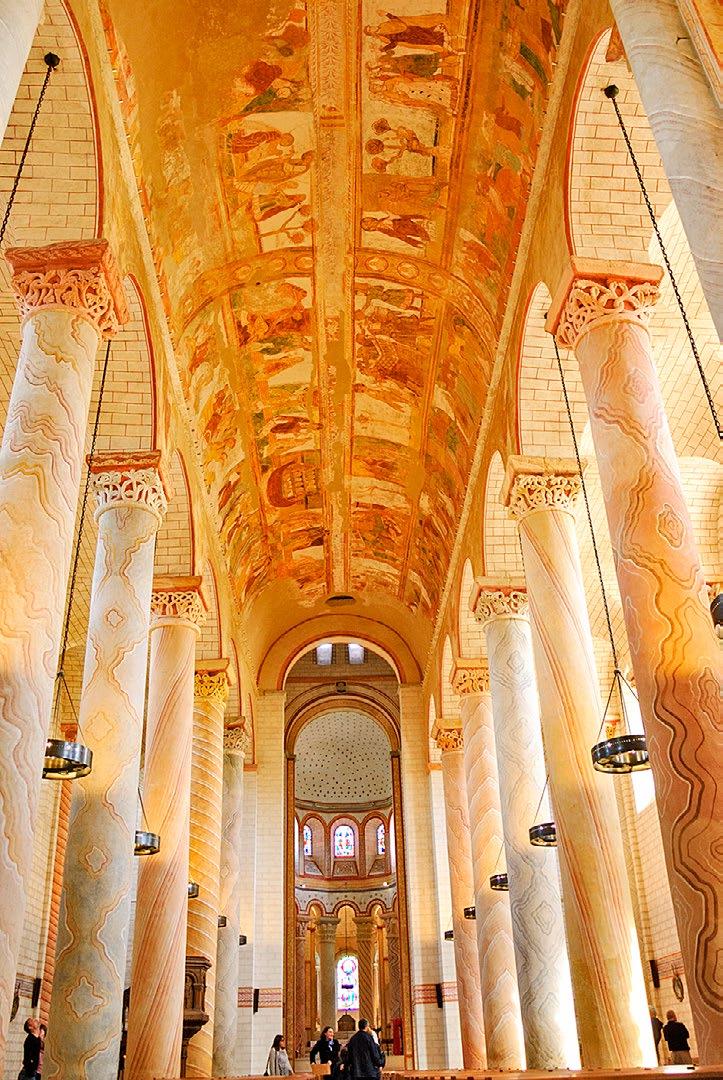
| Page 21
TAKE A TASTE OF POITOUCHARENTES HOME WITH YOU! Subscribe to Living Magazine and receive 6 issues to your door, the perfect way to plan for your next visit.... www.livingmagazine.fr
INCOMPARABLE COGNAC
SPIRITUAL ENLIGHTENMENT


Despite the passage of time, creating fine cognacs retains a certain mystique, not least the complex blending and other processes which define the essential character of vintage cognacs. It’s no surprise that they’re closely guarded secrets.
The fascinating story of cognac began when 17th century Dutch merchants discovered, quite by chance, that distilled wines improved dramatically after storage in oak barrels. Armed with this knowledge, local producers developed the classic ‘double distillation’ process and before long the brandy they produced came to acquire the name of the town of its origin.


Like Champagne, cognac production is strictly controlled in order to preserve its reputation, heritage and quality, and can only be produced in one of the region’s six terroir areas defined formally in 1909 to prevent ‘lesser’ grapes and brandy producers compromising the rigorous standards required. In 1936 cognac
received Appellation d’Origine Controlée or AOC status. In 1860 geologist Henri Coquand, working with a taster, defined precise boundaries for both ‘Grande Champagne’ and ‘Petite Champagne’ (the ‘Premier Cru’ growth areas), thereby establishing formal geographical boundaries for cognac production.
Only three specific grape varieties can be used to produce cognac: Colombard, Folle Blanche and Ugni Blanc (sometimes referred to as ‘Saint-Emilion’ in France). The most celebrated cognacs have high percentages of Ugni Blanc grapes, which are lovingly cultivated and tended in the Premier Cru area. The vines are nourished by the chalky soils and sunny climate, and grapes are harvested in early October, gently pressed then allowed to ferment for several weeks before being distilled twice. Many producers still use traditional pot-bellied stills or ‘alembics’. The second distillation - ‘la bonne chauffe’ - enhances both complexity and aromas.

www.livingmagazine.fr
The historic riverside towns of Cognac and Jarnac are home to grand cognac houses which have long pursued a shared passion for one of our region’s most celebrated exports...
© LAVAL SÉBASTIEN/CHARENTE TOURISME
Historic quaysides at Cognac
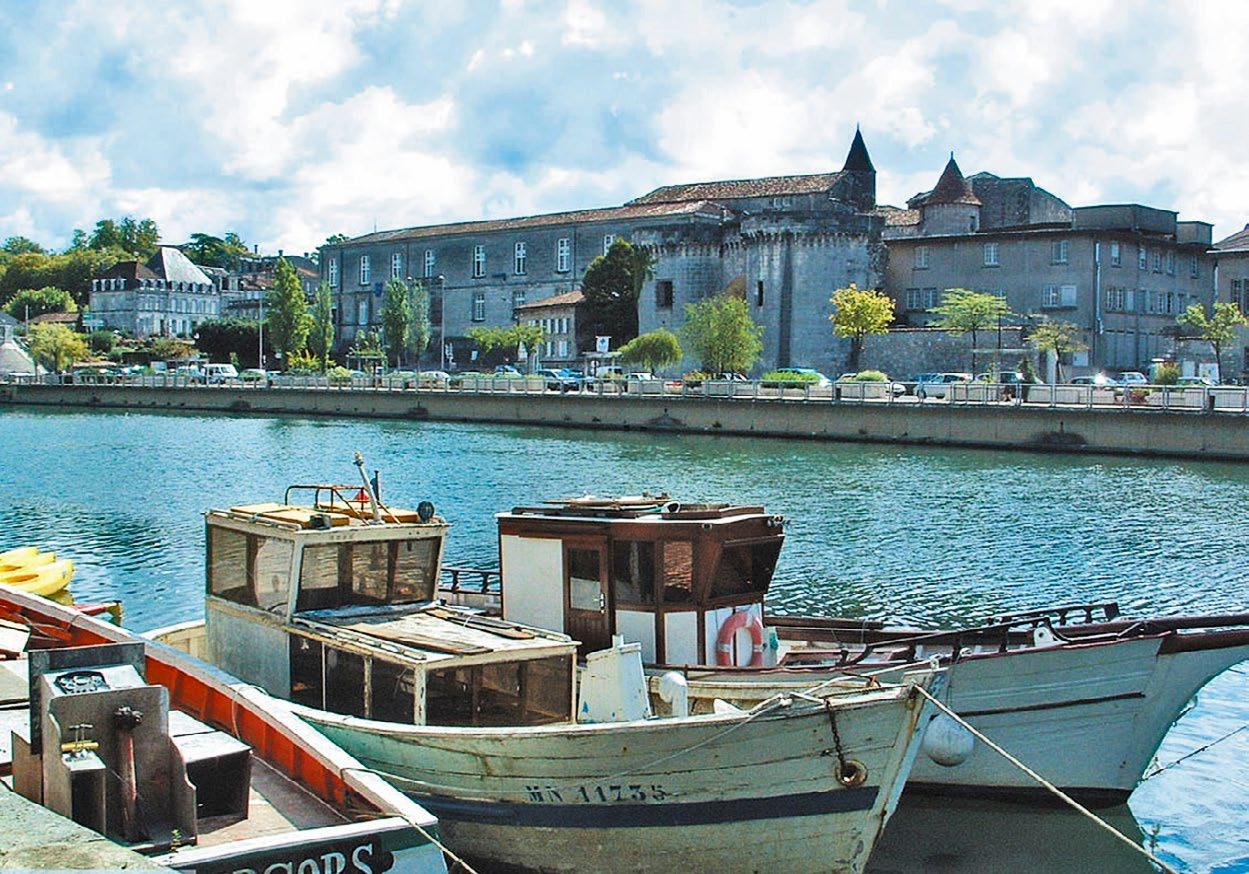

The resulting eaux-de-vie spirits are then aged in large barrels of oak from the Forêt de Tronçais in central France or from the neighbouring Limousin region.
Inevitably, during ageing a proportion of the spirit will be lost through evaporation, and is known as ‘la part des anges’ or ‘the angels’ share’. The evaporating fumes nourish a fungus which blackens the pale limestone around the doorways and windows of the warehouses or ‘chais’ – an unmistakable sign of cognac production.
After a minimum two-year ageing period at a more or less constant temperature, the barrels’ precious contents will have acquired their
Tasting tip
When tasting cognac, first inhale while holding the glass by its stem. Now swirl the cognac to blend the aromas before inhaling again. Finally, taste with the tip of your tongue before drinking.
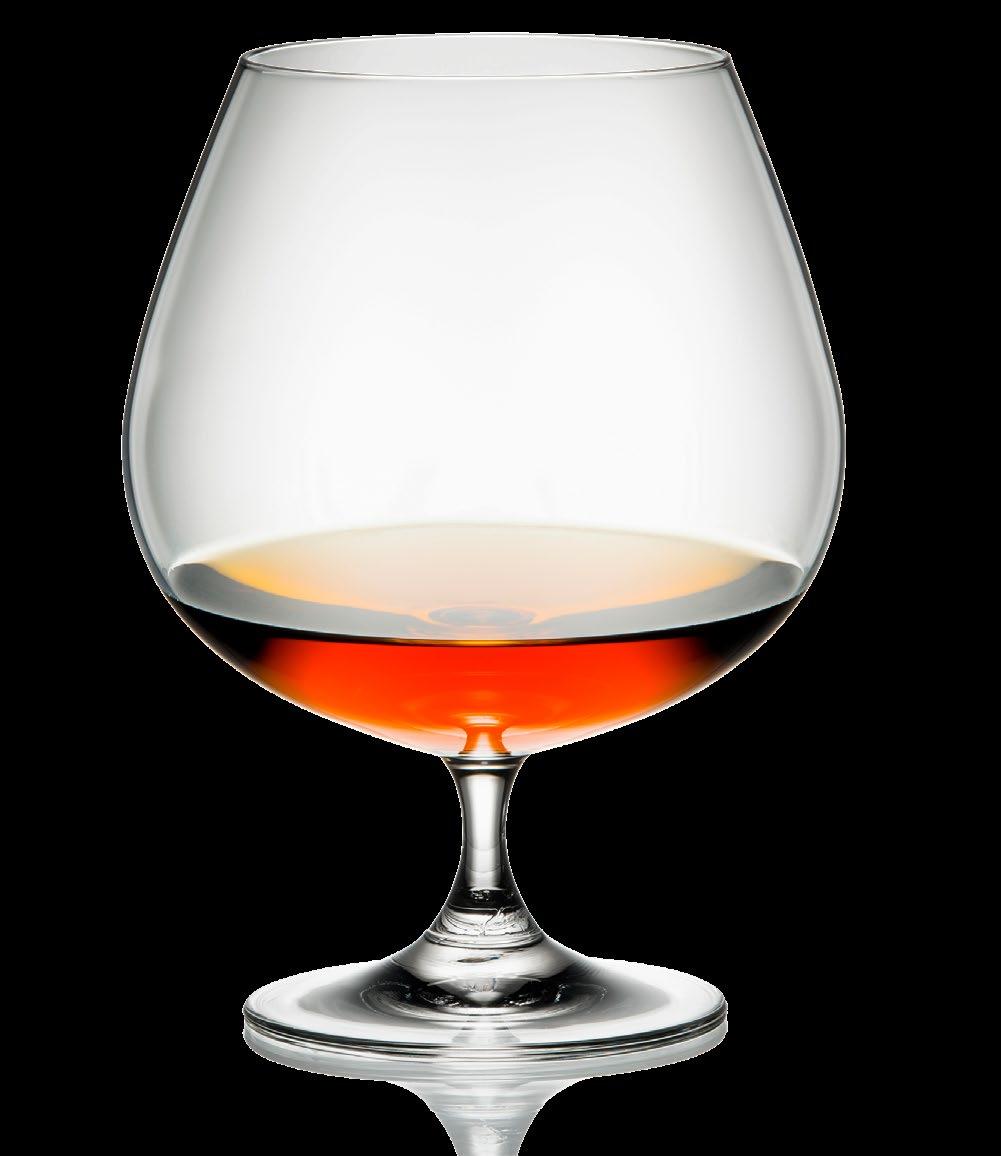
| Page 23
© CHARENTE TOURISME
DECODING THE LABEL
Decoding the letters on the label. The letters which follow ‘cognac’ tell you clearly how long it has been aged:
VS (Very Special) is the youngest cognac, with at least two years’ ageing.
VSOP (Very Special Old Pale) has been aged for a minimum of four years.
XO (Extra Old) / Napoleon have at least six years of ageing behind them, and often very much longer.
Many smaller domaines, like Conte Filles, are still family owned

characteristic rich, golden hues and unique flavours. Now the artistry of highly-skilled master blenders takes over, combining painstakingly selected eaux-de-vie to create the signature styles which are the hallmarks of their cognac house. Only when this is completed will the cognac finally be ready to be bottled and labelled.
Production has fluctuated over the years, but cognac has been enjoying a healthy revival, thanks to a new generation of connoisseurs, plus strong exports to China and the USA.
VISITING A COGNAC HOUSE
Many of the major cognac houses offer regular guided tours in English to explain the production processes, their history and the importance of the ‘terroir’. Tours include a tasting (for adults only –soft drinks are provided for younger visitors) and reservations are strongly recommended during busy summer months.
Several houses offer more in-depth visits and workshops lasting from 2 hours to a full day, where you can experience blending cognacs and learn about the Cellar Master’s art. Many houses are still family owned, and you’ll often be shown around by the owners themselves.
WHICH TOURS?
Families are welcome on tours, although tastings are for over18s only. From the many tours which on offer, we recommend visiting both a large and small estate as they offer very different experiences. If visiting a smaller domaine on a free tour, do try to support them through buying at their boutique.
Courvoisier
2 PLACE DU CHÂTEAU, 16200 JARNAC
With a heritage dating back to 1809, Courvoisier is based at its magnificent château in Jarnac. They offer a variety of tours and tastings, reserve your place online.
courvoisier.com

G et C Raby
16130 SEGONZAC
Fifth generation estate at the heart of the Grande Champagne which was home to the inventor of the double distillation process. The current owners offer visits and tastings of their cognacs, pineaux and wines.
cognac-raby.fr

Conte Filles
16480 CHILLAC

Award-winning domaine in the same family for five generations and now managed by two sisters,. Visit for a tour in English followed by a tasting of pineau and cognac.

domaine.contefilles.com

www.livingmagazine.fr Living Magazine Summer Guide 2023
WHERE IS COGNAC PRODUCED?
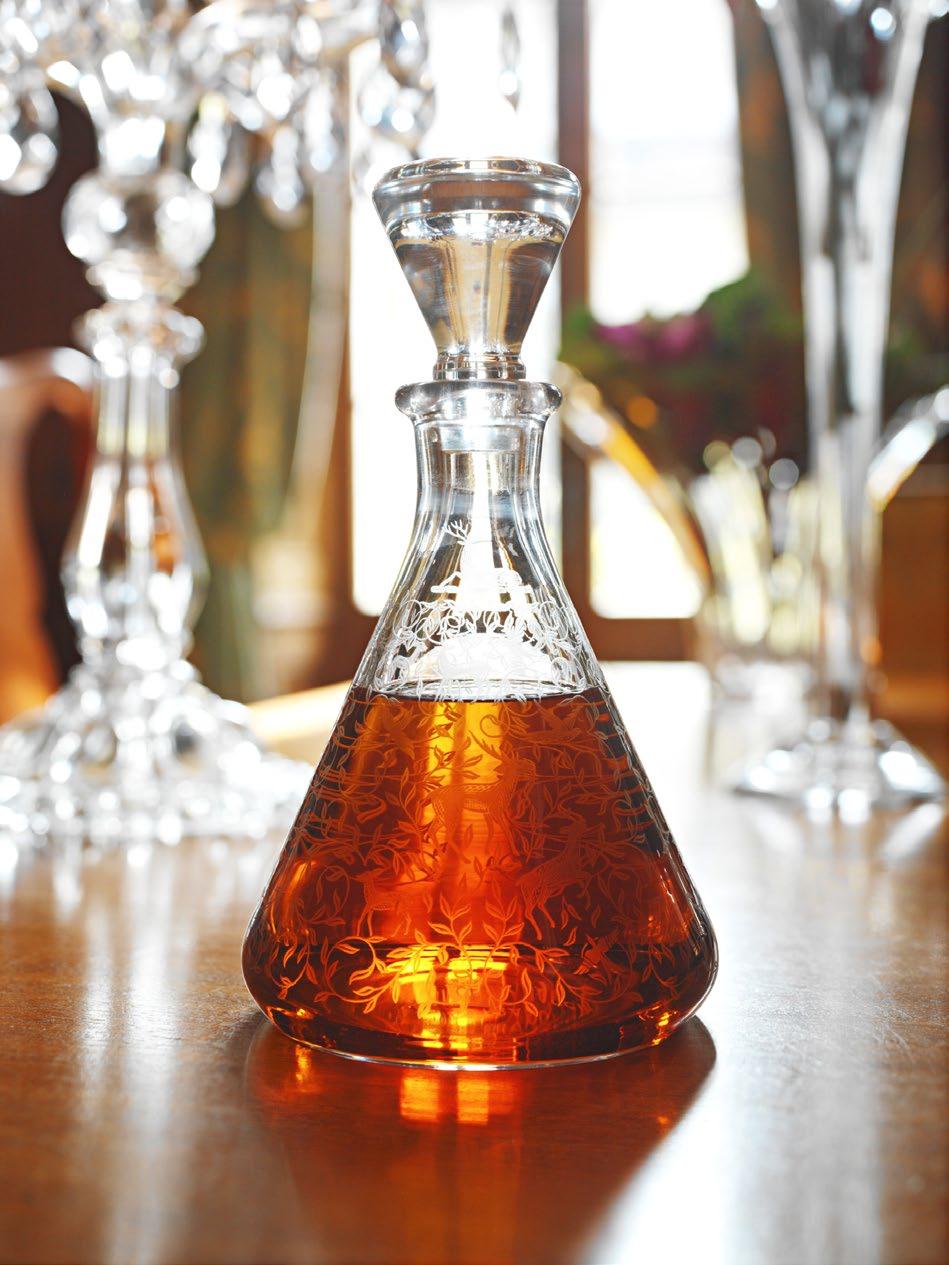
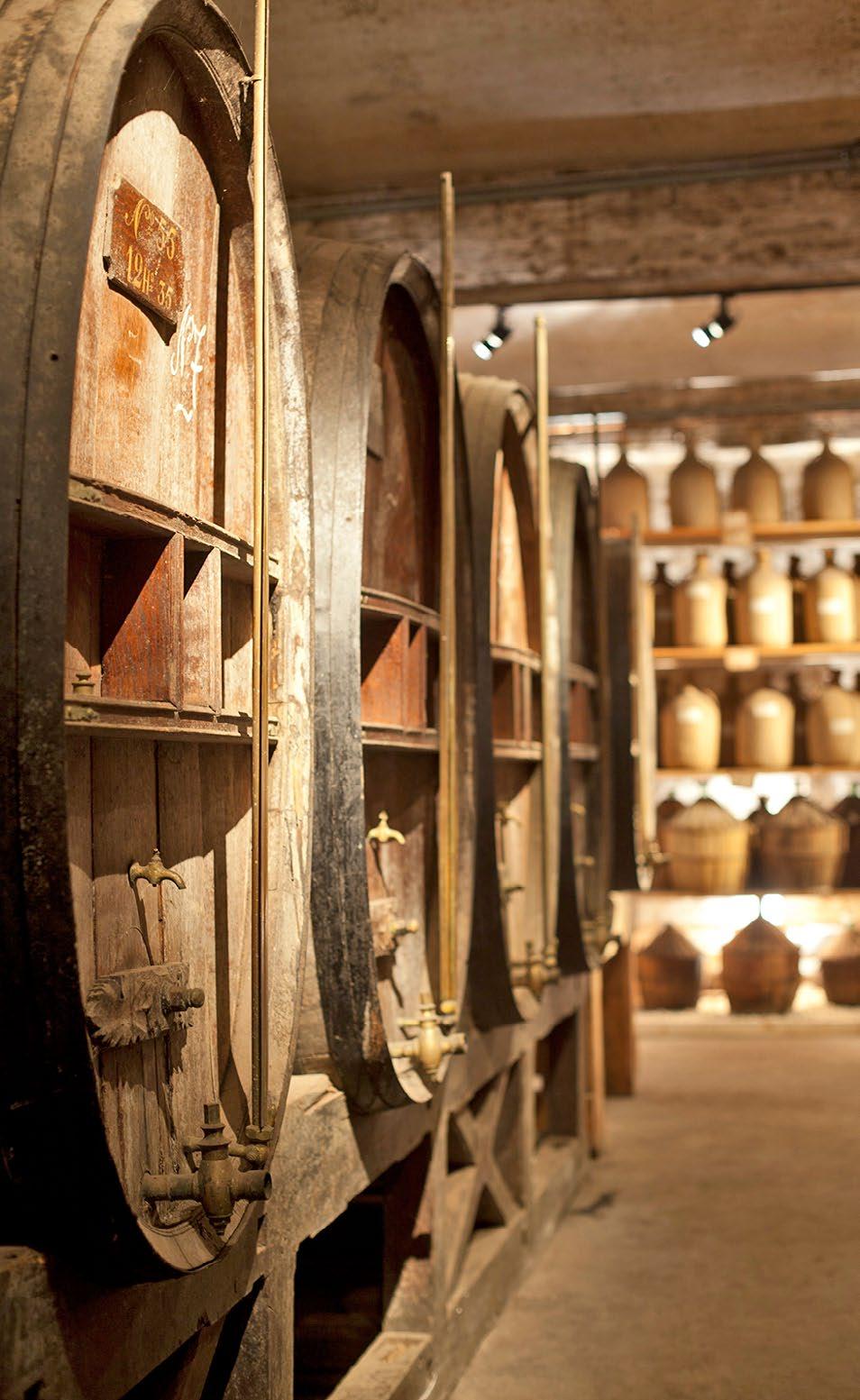
The Grande Champagne , centred around Segonzac, is bounded to the north by the Charente river and to both south and west by the river Né. Its grapes produce the very finest cognacs.
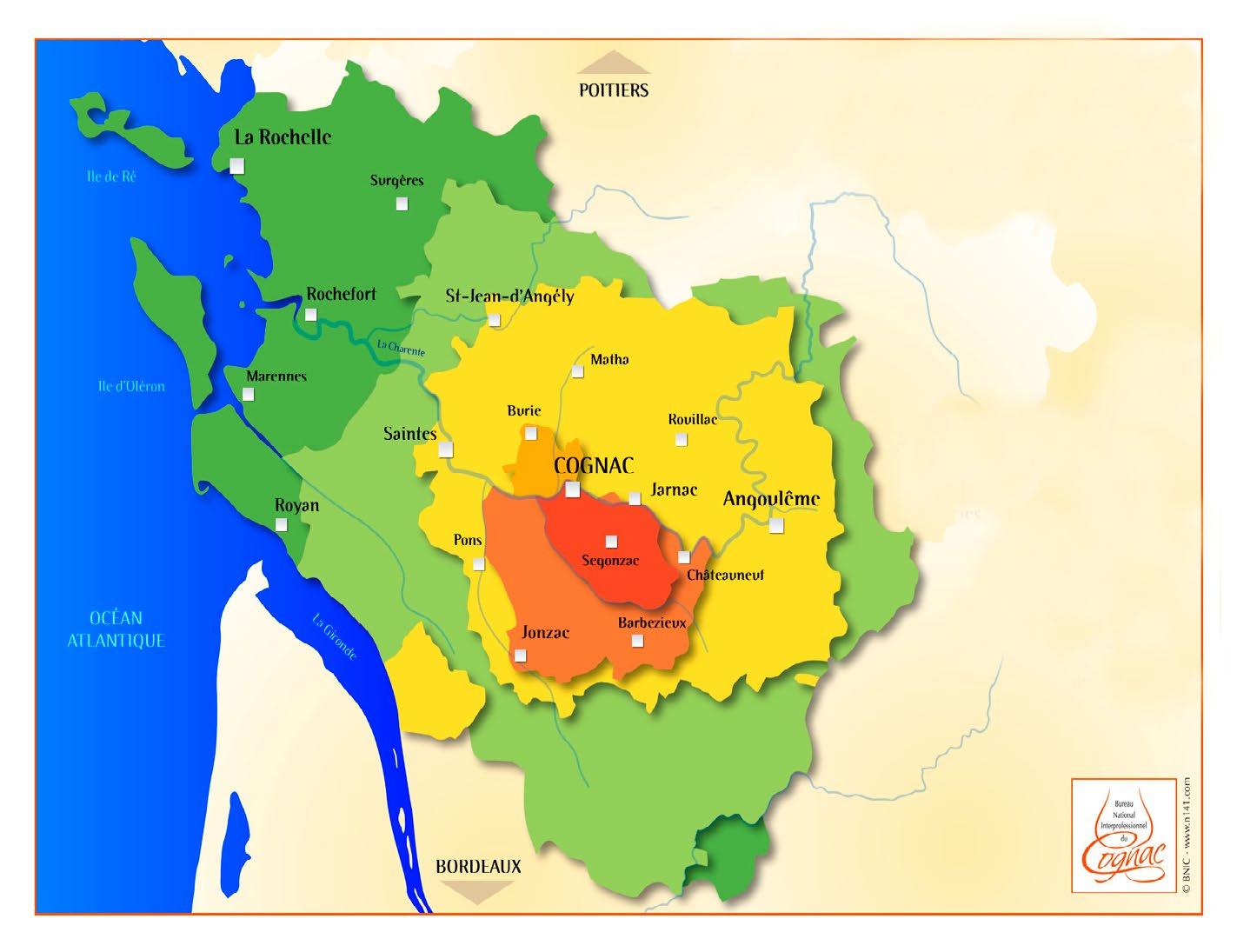
The larger Petite Champagne includes Jonzac and Barbezieux to the south, with the Charente river as its northern border and the Seugne hugging its western and southern edges. Its grapes tend to produce slightly less subtle cognacs.

The smaller Les Borderies area has less universally appealing grapes, but is home to some of the biggest Cognac houses, who once used the
Charente river to transport their goods, and who still work with many smaller local producers.
Beyond these areas, grapes are grown in three ‘bois’ or ‘woody’ regions – fins bois (fine wood), bons bois (good wood) and bois ordinaires (ordinary wood). Saintes, Saint-Jean-d’Angély, Aigre, Mansle and Angoulême all fall within ‘fins bois’, while Saujon, Saint-Porchaire, Villefagnan, La Rochefoucauld and Marthon are in ‘bons bois’.
The final cognac area extends to the CharenteMaritime coast and just into Deux-Sèvres, in the far north and west of the region.

| Page 25
PINEAU VARIETIES
WHITE
How old? It’s aged for a minimum of 18 months (with 12 months in oak barrels).
Colour: It ranges in tone from a pale yellow to a dark, golden hue.



VIEUX & TRÈS VIEUX WHITE
How old? Aged for at least 5 and 10 years respectively.
Colour: Dark and golden.
Bouquet: Honey, vanilla, prune and cinnamon aromas, with nutty overtones. Ageing intensifies flavour and adds ‘rancio ’ – originally a Portuguese word describing characteristics of port wine during the maturing process, and here used to describe a particular oxidised aroma.
RED & ROSÉ
How old? 14 months (including at least 8 months in oak barrels).
Colour: From pink to deep red. Bouquet: Fruity with elegant raspberry and cherry aromas.

Red in particular has hints of ripe fruit accompanied by a touch of cinnamon, liquorice and vanilla.
RED & ROSÉ VIEUX & TRÈS VIEUX
How old? Aged for at least 5 and 10 years respectively.
Colour: Pink with amber and brick-coloured highlights.

Bouquet: Hints of oak, prune, and chocolate on the nose, with a long, aromatic aftertaste.
PINEAU DES CHARENTES
Our flavoursome apéritif is a happy marriage of cognac and grape juice. Visit local producers whose families have been perfecting their blends for generations...
A brand new drink was born when a fabled wine producer unknowingly poured grape juice (or ‘must’) into a barrel of cognac. The precise date remains a delicious mystery, but brandy and wine production were already well established locally. Some years later he returned to the barrel and discovered that he had somehow created a new type of alcohol.
It takes an entire year to cultivate grapes and produce pineau. From September master pineau makers eye their grapes attentively until they are ready to harvest. After picking, the vines rest before being carefully pruned and examined in mid-winter to assure their health and vigour. Distillation and blending, on the other hand, take place behind closed doors. White grapes are pressed immediately, while red grapes are macerated and left for a few hours to leach their skin colour into the juice (precisely how long determines whether a pineau will be red or rosé). Fermentation stops once the pressed grape juice is mixed with cognac, and the blend is then aged for a minimum of 12 months. One of the attractions of pineau is that its flavour varies according to the individual producer. In marked contrast to cognac’s very specific growth areas, pineau has no ‘Premier Cru’ areas, but in order to be labelled Pineau des Charentes bottling must take place in the region of production. Pineau producers blend their grape juice with their own cognac, so essentially the same grapes grown for cognac are used for pineau. Pineau blanc is made from varieties such as Ugni Blanc, Folle Blanche, Colombard, Sémillon and Sauvignon. However, red or rosé forms are also very popular and typically employ Cabernet Sauvignon and Merlot.
Since 1945 Pineau des Charentes has enjoyed Appellation d’Origine Contrôlée (AOC) protection, ensuring that strict standards are maintained. It’s traditionally enjoyed as an apéritif before meals, but can also accompany blue cheeses, fruit or a dessert.
www.livingmagazine.fr Living Magazine Summer Guide 2023
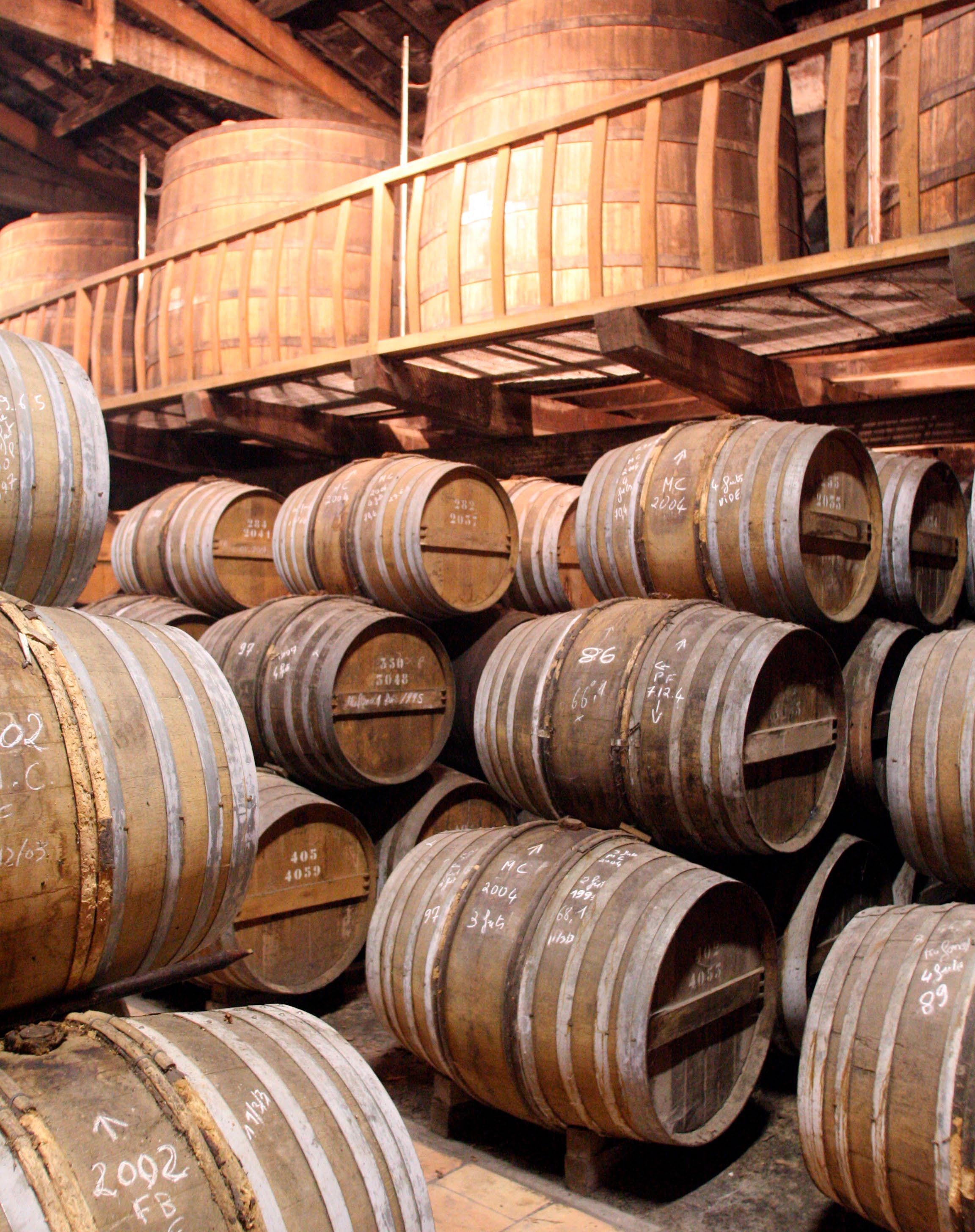
FAMILY FUN DAYS
There’s a fantastic selection of days out across the region so how do you choose where to go? We’re here to help you with our selection of family friendly attractions, wherever you are based...

CHARENTE (16)
CHEMIN DE FER CHARENTE-LIMOUSINE
16500 CONFOLENS
Pedal your own ‘vélo-rail’ along 17km of railway tracks through the heart of the Charente countryside from Roumazières or Confolens to Manot and back (trips last about 2h30).

Alternatively, jump on board the ‘train touristique’ from Confolens to Manot. cf-charentelimousine.fr
MUSÉE DE LA BANDE DESSINÉE
16000 ANGOULÊME
This famous museum in Angoulême celebrates the eternally-hip comic strip’s
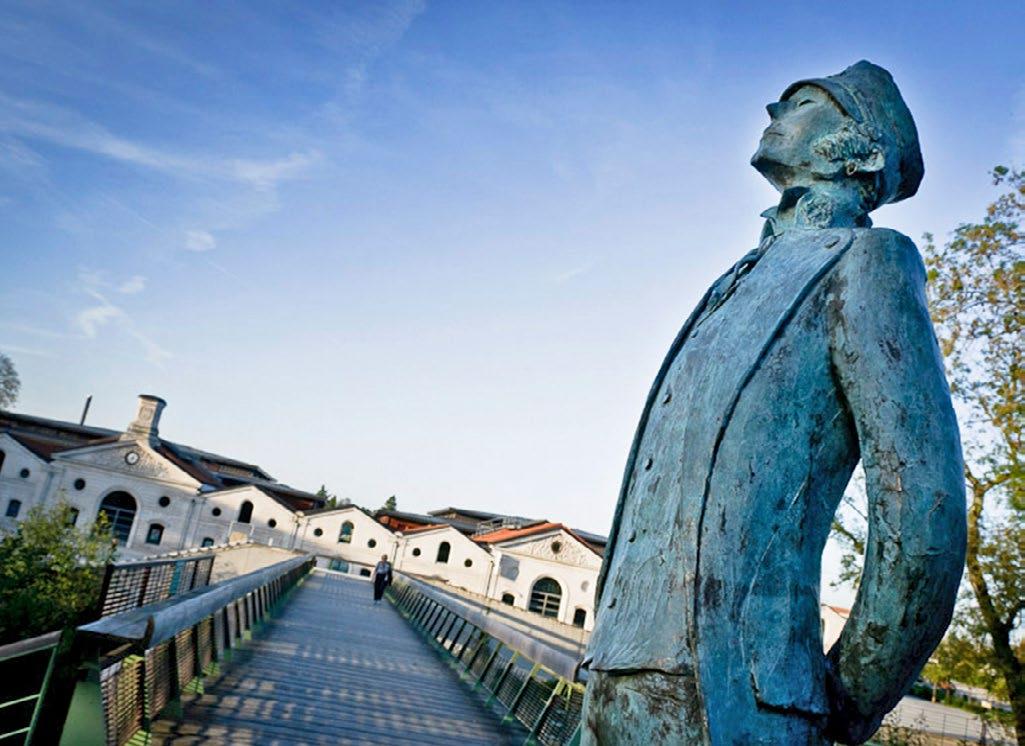
origins plus its cultural and political impact on the world.
cItebd.org
NAUTILIS
16710 SAINT-YRIEIX-SURCHARENTE
Seven different indoor and outdoor pool areas, including an 80m slide, spa and a cardio-gym, all under one roof on the edge of Angoulême.
nautilis.fr
ISLE NATURE
16140 SAINT FRAIGNE
Musée de la Bande
Dessinée, Angoulême
Vélo-rail, Charente-Limousine
Built on marshes close to the river, Isle Nature’s Jardin Ephemère is a wonderfully wild garden and includes a labyrinth, willow teepees and games for children.
islenature.fr
MUSÉE D’ANGOULÊME
16000 ANGOULÊME
Packed with exhibits, from local archaeology (including locally excavated dinosaur
bones) to items from the Maghreb and Oceania, plus fine art and ceramics.
maam.angouleme.fr
CASSINOMAGUS
16150 CHASSENON
The 3-storey thermal baths are some of the best preserved monuments of the Roman Empire and the surrounding 25ha park includes gardens, games and exhibitions. Guided visits in English around the archeaological site help you discover the secrets of ancient construction technique.
cassinomagus.fr
©
© S.
MARIOT CHRISTOPHE/CHARENTE TOURISME
CHARBEAU
AVENTURE PARC
16310 MASSIGNAC
Combine a day at the Lacs de Haute Charente with treetop adventures for adults and children. Accrobranche, bungee jumping and free jumping onto giant cushions of air!
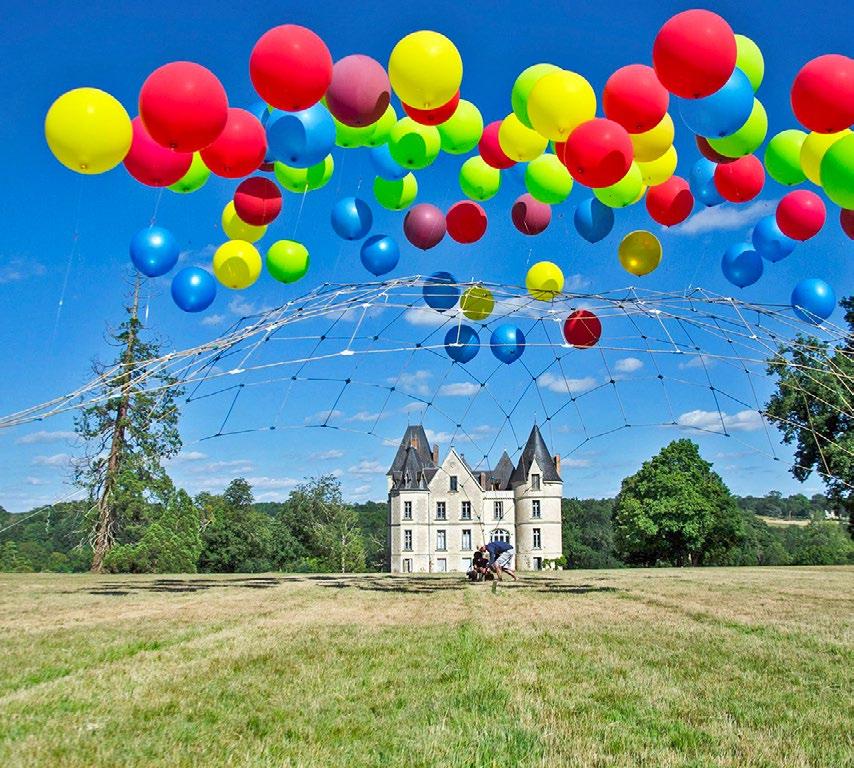
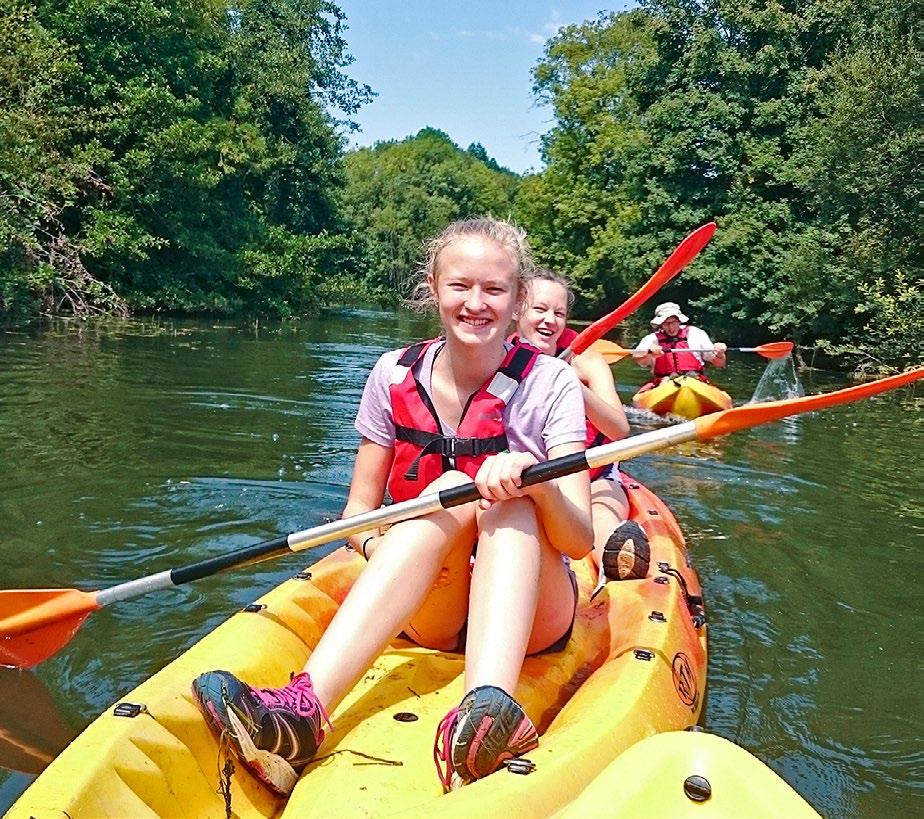

aventure-parc.fr
MUSÉE DU PAPIER
16000 ANGOULÊME
Housed in an atmospheric water-powered former paper mill, this small museum tells the history of the local paper industry, with period printed packaging and other decorative retro products.
maam.angouleme.fr
CORIOBONA - LES GAULOIS D’ESSE
16500 ESSE
A carefully reconstructed Gaulois village set above the Issoire valley. Visit artisans’ workshops, see inside the house of an aristocrat and learn about ancient daily life. coriobona-village-gaulois.fr
DOMAINE DE BOISBUCHET
16500 LESSAC
Every summer renowned international architectural designers and design innovators lead courses at this beautiful 150ha estate. Visit the grounds and see the innovative and experimental buildings
constructed over past years. Relax at the onsite organic bistro overlooking the Vienne river. boisbuchet.org
CHARENTEMARITIME (17)
LE PETIT TRAIN DE FOURAS
17450 FOURAS
See the coastline from a different perspective aboard the little tourist train which departs from the Fort Vauban. Take a 1hr 15min trip to the mouth of the Charente river, or 45 min along the beaches to the Pointe de la Fumée.
petit-train-rochefort-fouras.com
LA PIERRE DE CRAZANNES
17350 CRAZANNES
Set in 13 hectares, this former stone quarry (now a protected nature reserve) once supplied stone to build Fort Boyard. The steep cliffs and narrow gorges left behind offer a unique environment where ferns and clematis mingle. Sculptures are found through the park and you can even try your hand at stone carving. pierre-de-crazannes.fr
LES ANTILLES DE JONZAC
17500 JONZAC
One of the region’s biggest waterparks, with beaches, outdoor and indoor pools, competition and fun pools, spa and beauty centre. On-site restaurant with a panoramic view over pools.
lesantillesdejonzac.com
MUSÉE DE ROYAN
17200 ROYAN
In a former market hall discover the origins, architecture and post-WWII reconstruction of this elegant coastal
| Page 29
Messing around on ©
Charente
WWW.AVENTURE-PARC.FR
the
Family Days Out
resort. Interactive exhibits, films and more bring to life the history of this city, which was twice destroyed and three times fought over.
ville-royan.fr
LES GROTTES DU RÉGULUS
17132 MESCHERS-SUR-GIRONDE
These surprising troglodyte caves (below) are hidden in the cliffs of the Gironde estuary. Guided visits in French, but an English translation is available. ot-meschers.fr
ZOO DE LA PALMYRE
17570 LES MATHES

One of the best zoos in Europe, and set in 18 hectares among the pines of the Forêt de la Courbe. See more than 1,600 animals from all five continents including polar bears and snow leopards plus Siberian tigers, elephants, monkeys and apes.
zoo-palmyre.com

CITÉ DE L’HUÎTRE
17320 MARENNES
Explore the world of oyster farming on the Atlantic coast. Five oyster huts house a permanent exhibition and the included bike loan allows you to cycle the 3.5km trail through the oyster beds. Demonstrations, activities and a restaurant on site.
cite-huitre.com

LES GROTTES DU RÉGULUS
17132 MESCHERS-SUR-GIRONDE
These surprising troglodyte caves (right) are hidden in the cliffs of the Gironde estuary. Guided visits in French, but an English translation is available.

L’HERMIONE & ACCROMÂTS
17300 ROCHEFORT
The replica of Hermione is undergoing extensive repairs but you can learn about life aboard the 18th century ship before heading to the next quay and Accromâts. Don’t miss the thrill of climbing to the 32m-high crow’s nest with its breathtaking views before taking a ropewalk or zipwire between the masts (suitable for over-6s). hermione.com

ot-meschers.fr
CHÂTEAU
SAINT-JEAND’ANGLE
17620 SAINT-JEAND’ANGLE
Reawaken your inner knight or princess at this medieval chateau. Historic costumes, giant puzzles, trails and more
will keep the whole family entertained.
chateausaintjeandangle.fr
LA CORDERIE ROYALE
17303 ROCHEFORT
This unique ropeworks is the jewel of Rochefort’s Maritime Arsenal and has recently renewed its exhibitions as part of 350th anniversary celebrations. Learn all about sailors’ knots, see a huge ropemaking machine, visit the maritime exhibition and browse the extensive bookshop.

corderie-royale.com
LE BUNKER
17000 LA ROCHELLE
Visit a miraculously preserved secret bunker at the heart of La Rochellewhich was the headquarters of the occupying German Admirals and U-boat commanders during WWII.
bunkerlarochelle.com
MUSÉE MARITIME
17000 LA ROCHELLE
Discover La Rochelle’s seafaring history and go aboard France’s last meteorological vessel, a tug, a fishing trawler and several classic historic yachts.
museemaritimelarochelle.fr
| Page 30
www.livingmagazine.fr
Climb high at AccroMâts
Zoo de la Palmyre plays a
leading role in conservation
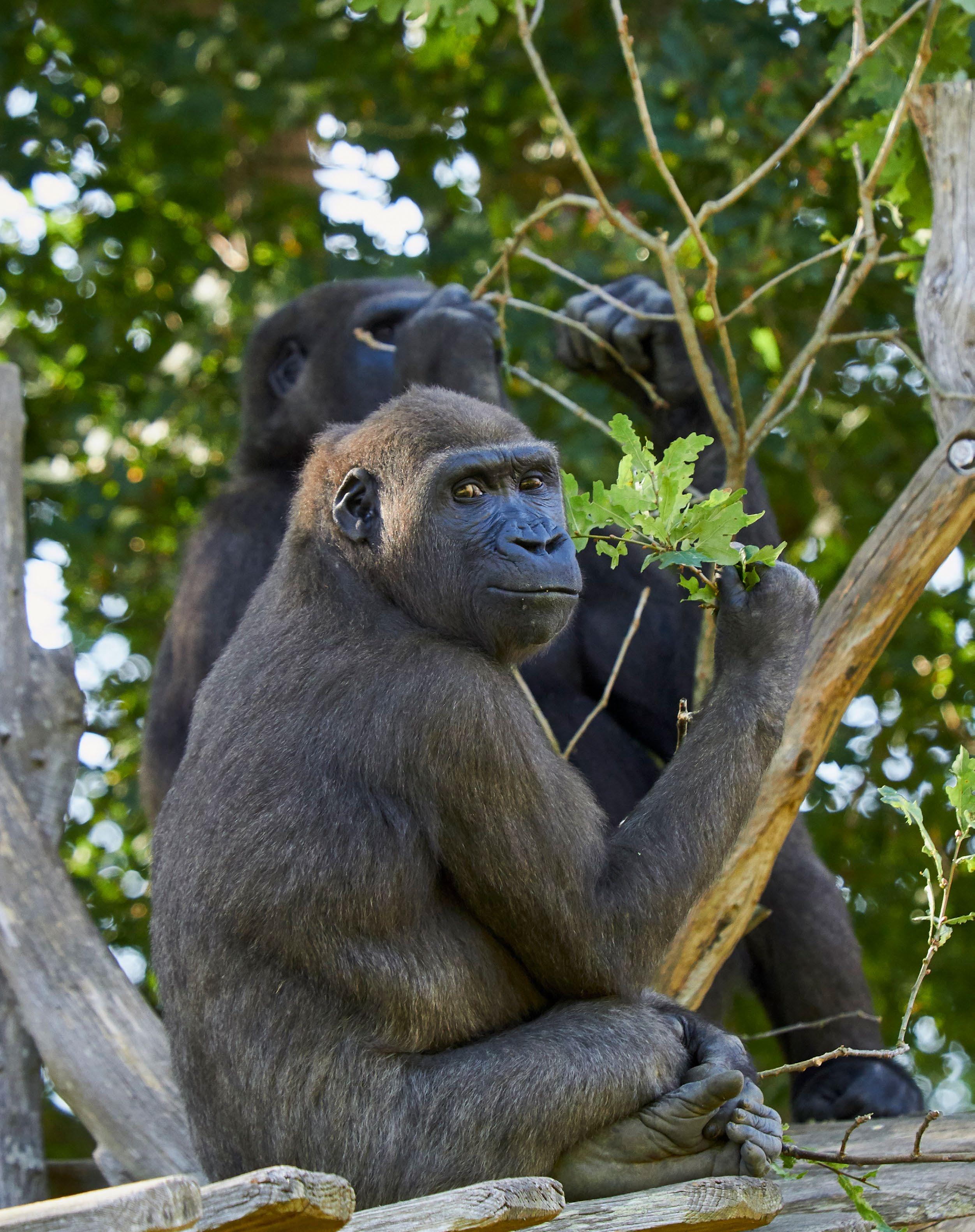
© FLORENCE PERROUXZOO DE LA PALMYRE
Family Days Out
MUSÉE DES COMMERCES D’AUTREFOIS
17300 ROCHEFORT
Step into bygone France as you always imagined it, in this private museum which preserves twenty original retro shops, bars, workshops and more.
museedescommerces.com
LE CEP ENCHANTÉ
17490 MACQUEVILLE
An educational circuit with a tablet through cognac vineyards reveals all about grapes and winemaking. 9-hole ‘SwinGolf’ also on site.
lecepenchante.com



PLANET EXOTICA
17200 ROYAN
7.6 hectares of activities and exhibitions about nature, reptiles, dinosaurs and exotic flora and fauna. Visit the huge tropical greenhouse and the desert hall where you will find one of Europe’s largest reptile exhibitions. Mini farm, petting area and water fountains.
planet-exotica.com
CHÂTEAU DES ENIGMES
17800 PONS
Pit your wits to solve family-friendly treasure-hunt riddles in a wooded park and a magnificent Italian Renaissancestyle chateau.
chateau-enigmes.com
PALÉOSITE
17770 SAINT-CÉSAIRE
This large living history centre will transport you back to prehistoric times, with lots of interactive family fun activities and demonstrations.
paleosite.fr
LA ROCHELLE AQUARIUM
17000 LA ROCHELLE
Enter through a lift simulating a deep-sea dive, and you’ll be enthralled. More than 10,000 sea creatures are on display, from brightly coloured fish to a 20m deep shark tank viewable from three levels.
aquarium-larochelle.com
FERME DE MAGNÉ
17250 SAINTE GEMME
An animal park with petting farm, children’s games, a maze and pony treks. Refreshments available.
fermedemagne.com
ASINERIE DU BAUDET DU POITOU
17470 DAMPIERRE-SURBOUTONNE
The home of the region’s much loved shaggy-coated Baudet donkeys, rare Poitevine mules and heavy horses. Exhibitions and events throughout the summer along with English language tours.
asineriedubaudet.fr
PALMILUD WATER PARK
17180 PÉRIGNY
Swimming pools, slides, jacuzzis and a sauna on a 4ha park with children’s games and snack bar.
palmilud.com
ÉCOMUSÉE DE PORT-DES-BARQUES
17730 PORT-DES-BARQUES
On the banks of the Charente estuary, at the heart of the oyster farms, this museum encourages children to get hands-on to learn about the environment.
ecomuseeportdesbarques.net
MUSÉE NATIONAL DE LA MARINE
17300 ROCHEFORT
The National Maritime Museum reveals the fascinating story of Rochefort’s proud maritime history and looks at the many fighting ships it built for the French navy.
musee-marine.fr
PARC AVENTURE DE FONTDOUCE
17770 SAINT BRIS DES BOIS
Treetop adventures in the grounds of the famous abbey. Nine rope courses for the older children and three for younger ones with two parallel zip-lines, each 200m long. Fun games at the abbey and an outdoor laser game complete the day.
fontdouce.com
TRAIN DES MOUETTES
17600 SAUJON
France’s oldest working steam locomotive hauls antique carriages from La Tremblade to/from Saujon beside the Seudre estuary, passing oyster beds.
traindesmouettes.fr

| Page 32
www.livingmagazine.fr
VIENNE (86)
HISTORIAL DU POITOU
CHÂTEAU-MONTS-SUR-GUESNES
Travel back through time to the Middle Ages and explore the origins of the Kingdom of France when Aliénor d’Aquitaine and Richard the Lionheart shaped the region as well as the lands beyond. Discover incredible destinies, epic adventures and the importance of power plays...
chateau-monts-sur-guesnes.com
PARCOURS AVENTURE DE LA VALLÉE DES LÉGENDES
86240 LIGUGÉ
Nine different tree top accrobranche courses at the Domaine de Givray just 5 minutes from Poitiers.
gravite-86.com
PARC DU FUTUROSCOPE
86360 CHASSENEUIL-DU-POITOU
No visit to the region is complete without a visit to Futuroscope. Fun, festive and family-friendly with exhilarating adventures, heart thumping thrills, spellbinding live shows, captivating
journeys, a fairy-tale aquatic evening show, enchanting attractions… There are a variety of on-site restaurants and snack bars open throughout the park and plenty of places just to relax and soak up the atmosphere.
NEW for 2023
Tornado Chasers, an immersive adventure ride takes you to the heart of a tornado to experience the power of nature.
Don’t forget that Living Magazine readers receive a generous of 7€ per person
futuroscope.com

DÉFIPLANET’
86410 DIENNÉ
Set in 47ha of unspoilt nature just 25 minutes from Futuroscope and Poitiers, DéfiPlanet’ au Domaine de Dienné is a family theme park with a range of activities on offer including swimming pools, accrobranche and pony rides.
defiplanet.com
LES GÉANTS DU CIEL
86300 CHAUVIGNY
Daily falconry displays set within

ROC AUX SORCIERS
86260 ANGLES SUR L’ANGLIN
At the heart of one of France’s most beautiful villages is a 20m-long sculpted freize featuring over 30 animals and dating back 15,000 years. Dubbed the Lascaux of sculpture, the original is protected but a replica is open.
roc-aux-sorciers.fr
SAINT-CYR LEISURE PARK
86130 SAINT-CYR
Beautiful 300 hectare park dedicated to sports, nature and recreation. The 85ha lake has lifeguards on its beach from 10am-7pm during the summer.
lacdesaintcyr.com
ETHNI’CITÉ
86220 SAINT-RÉMY-SUR-CREUSE
Visit a troglodytic village from the times of Richard the Lionheart, set high above the Creuse river. See how inhabitants lived during the 17-19th centuries with the help of exhibitions and re-enactments.
ethnicite.fr
ACCRO’LATHUS
86390 LATHUS SAINT-RÉMY
Five rope courses through the treetops
| Page 33
Family Days Out
are also panoramic views of the medieval town and countryside.
chauvigny-patrimoine.fr
LA CITÉ DES TANNEURS
86470 BOIVRE LA VALLÉE
Visit an artisanal leather tannery (below) and discover the tanning process from the Middle Ages to today before taking part in a workshop (reservations recommended).

VÉLO-RAIL DE CHAUVIGNY
86300 CHAUVIGNY
Pedal along ancient railway lines and enjoy an exceptional view of the medieval city of Chauvigny before heading out into the Vienne countryside. The return trip covers 17.4km and takes 2 hours at average pace.
velorail-chauvigny.fr
DOMAINE LE BOIS AUX
DAIMS
with challenges along the way, all supervised by qualified staff. Try your hand at flying trapeze, zip-wire, spiders’ web nets, Tarzan jump and more. cpa-lathus.asso.fr
LA VALLÉE DES SINGES
86700 ROMAGNE

Get aquainted with over 450 primates, most of them living in near-total liberty over 22ha of parkland. The celebrated collection includes gorillas, chimpanzees, lemurs and you can watch over 40 different feeding and activity times each day.
la-vallee-des-singes.fr
OXYGÈNE 40 & ARBRÉSO
86150 L’ISLE JOURDAIN
Adrenalin junkies can leap from the 47m viaduct at l’Isle Jourdain (above) over the Vienne river on a bungee, or whizz down one of the giant zip-wires crossing the river, the longest of which is 505m. There are treetop climbs and family accrobranche routes too.
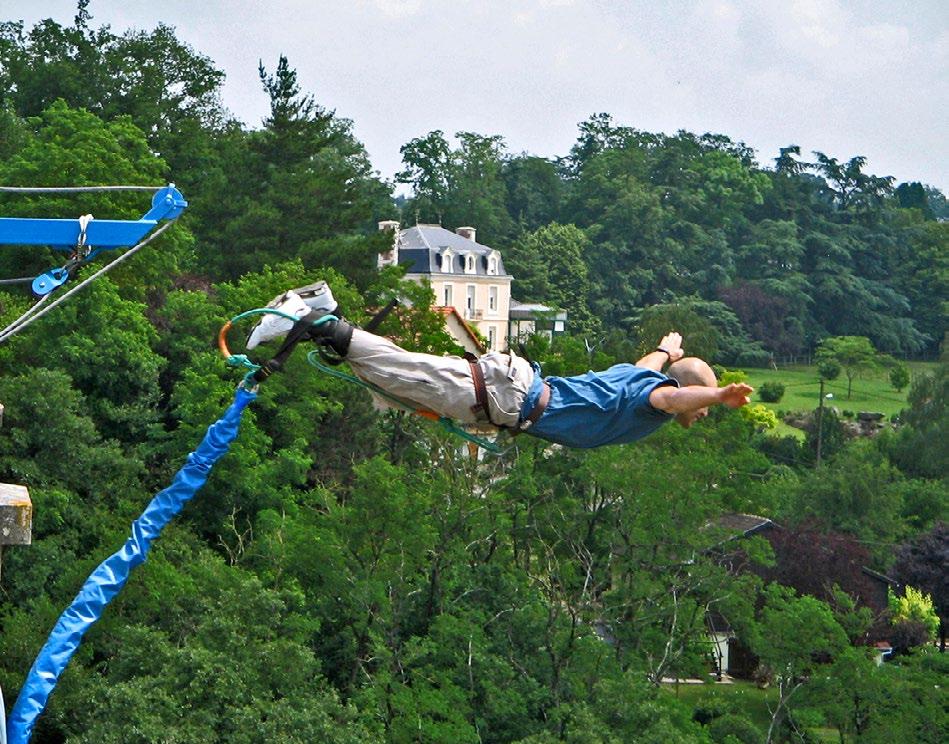
oxygene40.com arbreso.com
ESPACE D’ARCHÉOLOGIE INDUSTRIELLE
86300 CHAUVIGNY
In a 12th century donjon, the displays recount the history of the local industrial heritage. There
citedestanneurs-lavausseau.fr
LE CORMENIER
86400 CHAMPNIERS
Immerse yourself in bygone everyday rural life during a 2½hr visit (available in English) with faithfully recreated scenes and special effects following Pierre born in 1898 as he grows up. lecormenier.com
GLISS-UP WATER JUMP
86370 VIVONNE
High-adrenalin water slides and jumps along with wakeboards, beach and restaurant.
gliss-up.fr
86120 MORTON
Day tickets are available for this Center Parcs site close to Poitiers. Access the Aqua Mundo water park as well as outdoor play sites and farm. Additional activities available at cost.
centerparcs.fr
LA FERME MUSÉE D’ACADIENNE
86210 ARCHIGNY
Expelled from Canada by the British, Acadian families arrived here in 1773. Today, you can visit 38 cob houses built for them and retrace their footsteps.
archigny.net


CENTRE AQUATIC ABYSSÉA
86320 CIVAUX
A swimming and bowling complex which is perfect for a rainy day. The pool has a giant toboggan and relaxing spa complex. There’s also a 20m deep diving well and an 8 lane ten-pin bowling alley.
vert-marine.com/abyssea-civaux-86
DEUX-SEVRES (79)
TUMULUS DE BOUGON
79800 BOUGON
Discover five tumuli built by prehistoric man in the Neolithic period (above), plus full size reconstructions of two prehistoric houses, with
| Page 34
www.livingmagazine.fr
demonstrations and activities. 2019 sees the arrival of the new mammoths exhibition with a life size replica.
tumulus-de-bougon.fr
LAC DU LAMBON
79370 PRAILLES
Choose from water-based activities, canoeing, paddle-boarding, pedaloes, or a range of other activities including accrobranche, mini-golf and archery at this leisure lake.
lelambon.com
MUSÉE DE RAURANUM
79120 ROM
This child-friendly museum includes treasure hunts, a ‘dig’ (for artefacts excavated in Rauranum, a town on the Poitiers–Saintes Roman road) and Roman games.

FB: @rauranum
PESCALIS
79320 MONCOUTANT
For a watery fun day out visit the largest fresh water aquarium in the region, then enjoy a 150 ha nature park with (no-kill) coarse fishing lakes. There are plenty of activities for non-anglers, from horseriding to mini-golf and bike hire.
pescalis.com
Family Days Out
SÈVRE AUSTRUCHE
79440 COURLAY
Visit an ostrich farm with the added fun of a 9,000m2 maze and children’s games. The farm shop sells local produce and souvenirs.
sevre-autruche.fr
LES OISEAUX DU MARAIS POITEVIN
79210 SAINT HILAIRE-LA-PALUD
An ornithological park in the heart of the Marais Poitevin, this 8ha paradise allows you to discover 70 bird species as well as typical marsh flora. You can access the wilder areas by hiring a boat. oiseauxmaraispoitevin.com
PARC DE LA VALLÉE
79150 MASSAIS
Near Argenton, this family park offers fairground rides, shows and a waterpark. Take a boat out on the neighbouring river and picnic in the grounds. parcdelavallee.com
LE NOMBRIL DU MONDE
79130 POUGNE-HÉRISSON
Children love this imaginative and eccentric garden. Discover ‘the navel of the world’, a land of sounds, legends and enchanted stories. Explore the gardens where stories find refuge and listen carefully as the nombril talks to you.
nombril.com
MUSÉE DU MOTOS ANCIENS
79370 CELLES-SUR-BELLE
45 historic motorcycles and mopeds are displayed in this museum behind the town’s Abbaye Royale.
musee-motos-cellessurbelle.fr
ZOODYSSÉE
79360 VILLIERS-EN-BOIS
Try to spot all 70 species of European animals in this 30 hectare park set in the 3,500 hectare Forêt de Chizé. Learn about conservation, visit the mini-farm or take a horse-drawn cart around the circuit.
zoodyssee.fr
LE CENTRE RÉGIONAL ‘RÉSISTANCE & LIBERTÉ’
79100 THOUARS
The history of the region from 1933-45 and the role of the French Resistance is revealed at this museum, set in the stables of the Château des Ducs de La Trémoille.
crrl.fr
PARC MOUTON VILLAGE
79340 VASLES
Everything you want to know about sheep and probably more! In addition to 20 or so breeds from all over the world, the 6-hectare park includes an arboretum and a bird reserve.
moutonvillage.fr
LE PETIT TRAIN PIBALOU
79510 COULON
A fun way to discover the Marais Poitevin in as little as one hour before taking to the water or hiring a bike to explore further.
lemaraispoitevin.fr
MINES D’ARGENT DES ROIS FRANCS
79500 MELLE
Claiming to be the oldest silver mines open to visitors in the world, these mines date back to Charlemagne and their silver was made into coins until the end of the 10th century. The visit lasts 1h30 and is in French.
mines-argent.com
| Page 35
 Saint-Savinien on the River Charente
Saint-Savinien on the River Charente
Away from the Atlantic lie unspoilt rural landscapes shaped by noble rivers. Here you’ll find ancient Romanesque architecture, medieval chateaux, serene gardens and authentic villages, along with vineyards, forest trails and more...
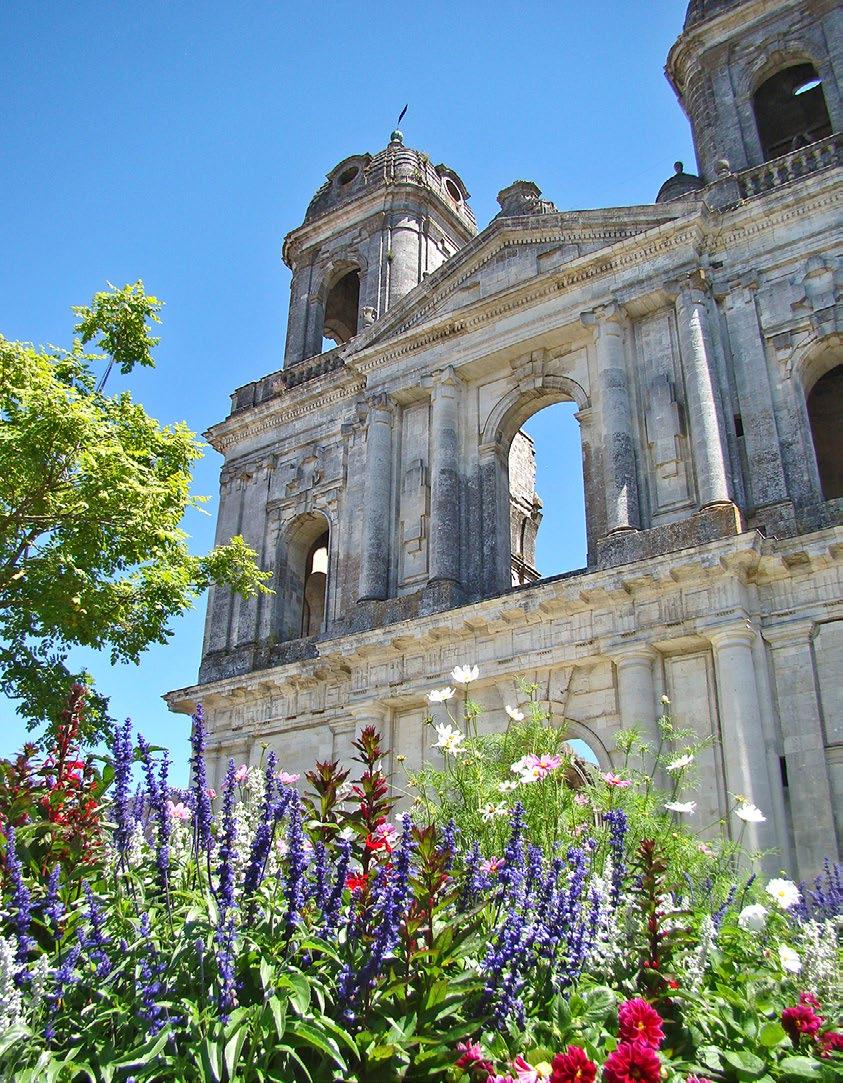
LES CHARENTES EXPLORING
THE SAINTONGE
This fascinating area takes its name from the ancient riverside town of Saintes, whose startling 11th century Sainte-Eutrope basilica is a UNESCO World Heritage Site. Close to it are extensive Roman remains, including the Arc de Germanicus (a 2,000 yearold triumphal arch) plus a large amphitheatre known locally as ‘Les Arènes’. With riverside walks and great restaurants, Saintes will steal your heart away and inspire you to explore the beautiful Saintonge.
In the town of Pons you’ll discover a magnificent 12th century donjon plus the lovingly restored Hôpital des Pèlerins, founded in 1160 and now also UNESCO listed. Nearby is the Château des Enigmes, a family activity park set around an ornate Renaissance-style chateau. Further south, the medieval town of Jonzac has two historic mills, still powered by wind and water and selling their produce direct to visitors.
There are lots of opportunities to get closer to nature. At the Maison de la Forêt, near Montlieula-Garde, you can climb a forestry lookout tower in a
landscaped park presenting traditional woodland activities, visit a butterfly reserve and more. Alternatively, cruise the Gironde (Europe’s largest estuary) from the little port of Vitrezay, which has 16km of lakeside paths for cyclists, walkers and nature watchers. It also offers canoes and fishing (you can even hire a traditional carrelet net-fishing hut). Inland lie lakes, waterways and Les Antilles (a lagoon in Jonzac heated by thermal springs) plus the Parc de Beaulon, with blue fountains, a 15th century chateau and formal gardens. Among the peat marshes of the Espace Naturel des Bénissons are butterflies, dragonflies, amphibians and many rare plant species, and you can retrace the footsteps of prehistoric man at the huge Paléosite. Here a virtual time machine travels via the Middle Ages and Roman occupation back to prehistory.
In fact, the Stone Age is still with us at Les Lapidiales – an open-air sculpture park (free admission) whose works have transformed the former stone quarries of Port d’Envaux, north of Saintes. The 10km Chemin de la Pierre leads to the vast, abandoned quarries of Crazannes, whose museum celebrates centuries of stone extraction in the Saintonge. Rising above it all is an impressive Gothic chateau.
A few km downstream lies Saint-Saviniensur-Charente, an enchanting riverside market town, where a sunny viewpoint set high on a limestone promontory reveals the pastel terracotta rooftops of an ancient port which traded timber, grains, wines, spirits and locally quarried stone. Hire a kayak or self-drive
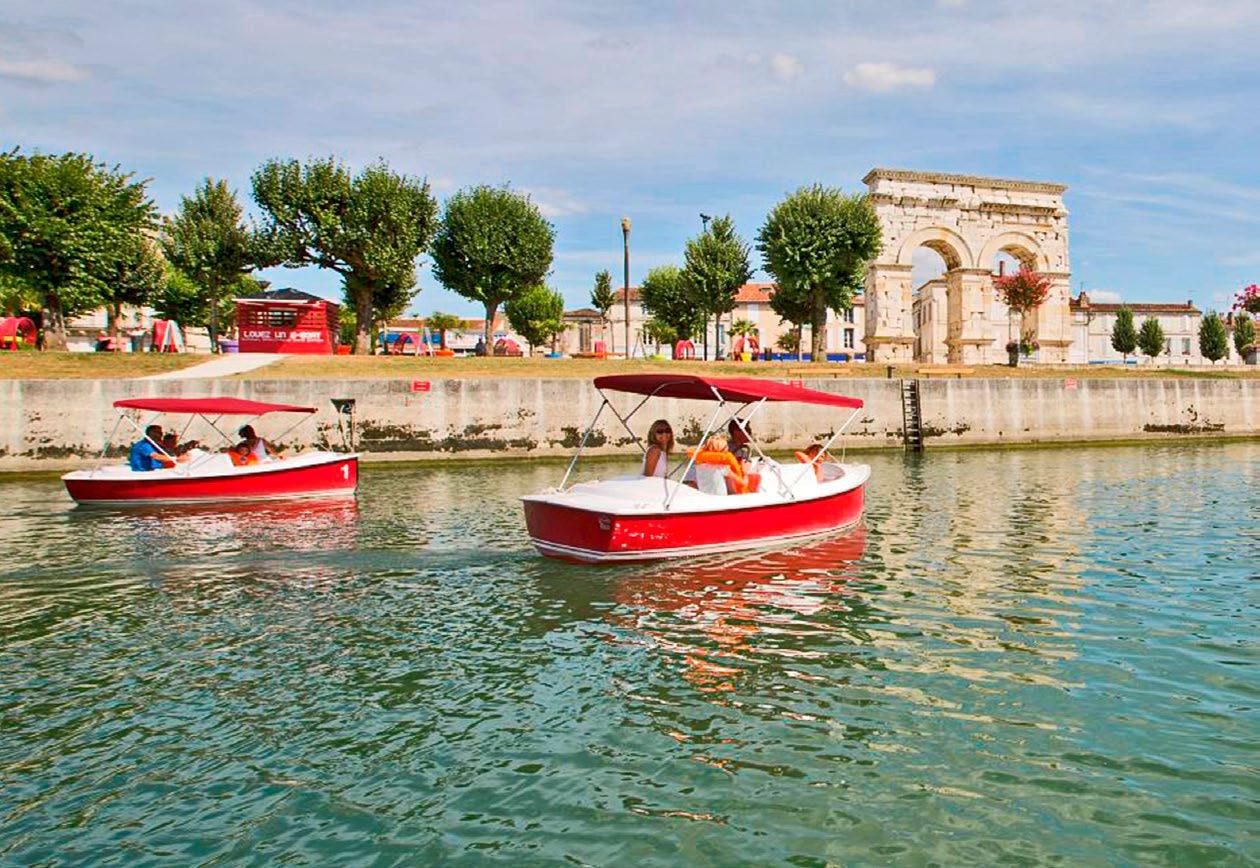
| Page 37
Arc de Germanicus and River Charente, Saintes
Saint-Jean-d’Angély 17th century abbey towers © CMT17 C. TRIBAL
© SÉBASTIEN LAVAL, CDT17
river cruiser from the riverbank, or wander among beautiful landscaped parkland, where you can skipper a scale model ship on a sheltered lake.
Nearby the gracious 15/17th century Château de la RocheCourbon overlooks a vast ornamental lake, the focalpoint of Italianate formal gardens created with miraculous ingenuity on unstable coastal marshland. The spirit of the Italian Renaissance also influenced the moated chateau of Dampierre-sur-Boutonne (right), whose award-winning restoration encompassed two gardens, with a labyrinth-style topiary maze. The village itself is charming, and nearby at the Maison du Baudet du Poitou you can meet the gentle giants of the donkey world. The centre has been instrumental in preserving the curly-coated Baudets which for centuries have been familiar features around the region. You’ll learn how they worked the land, and how they’ve been saved from extinction. Beside the Boutonne river lies Saint-Jean-d’Angély, whose narrow medieval streets contain 16th century half-timbered façades, an elegant Renaissance fountain and a stone gateway built in 1406-10 and topped by a noble bell tower. The Musée des Cordeliers displays the first vehicle (a 1922 Citroën) to cross the Sahara, while nearby is the vast Salle d’Aliénor d’Aquitaine, built using neo-Classical stonework from the cloisters of the town’s 17th century Abbaye Royale, whose construction was halted by the French Revolution. The abbey’s impressive western façade and two monumental towers still dominate the town skyline.

Finally, in the north west of the region is Aulnay-de-Saintonge, another characterful town whose market place is packed with colourful stalls on Thursday and Sunday mornings. For centuries Aulnay was a halt for pilgrims bound for Saint-Jacques de Compostela, and its jewel of Romanesque architecture – the vast, ornate Eglise Saint-Pierre d’Aulnay (right), dating from 1120-40 – is today a UNESCO World Heritage Site.
SOUTHERN CHARENTE
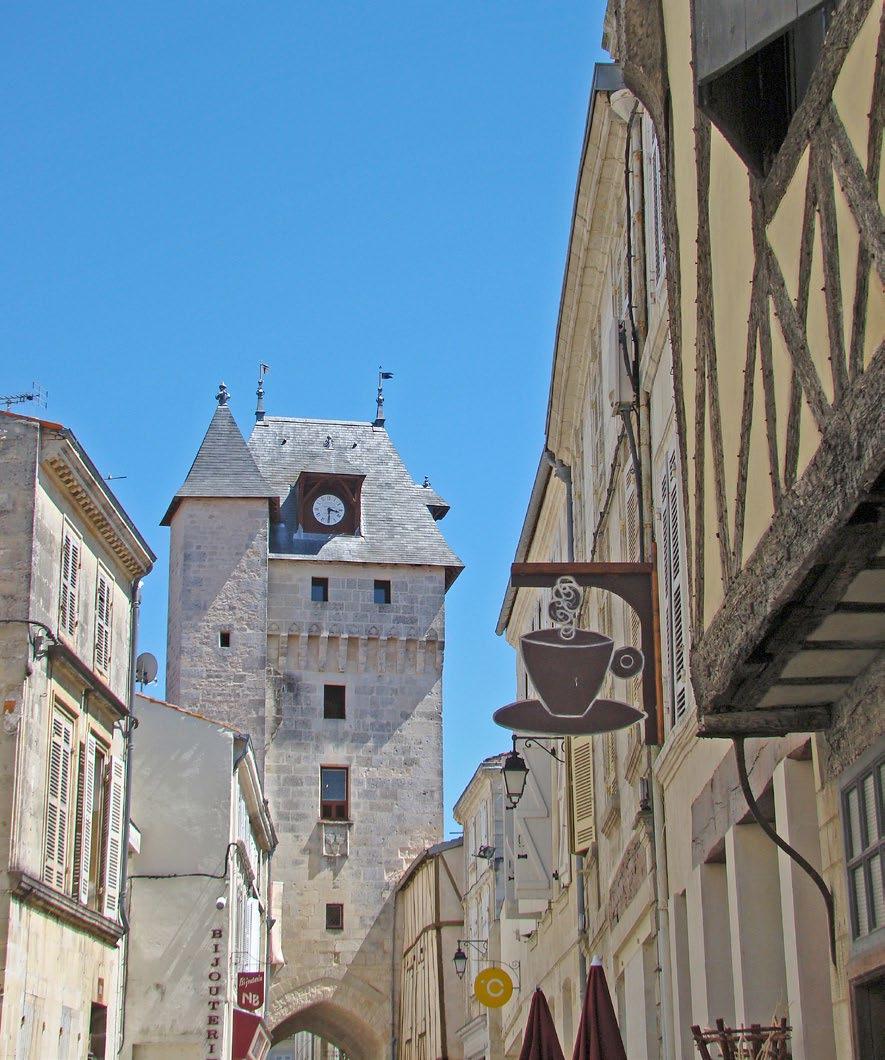
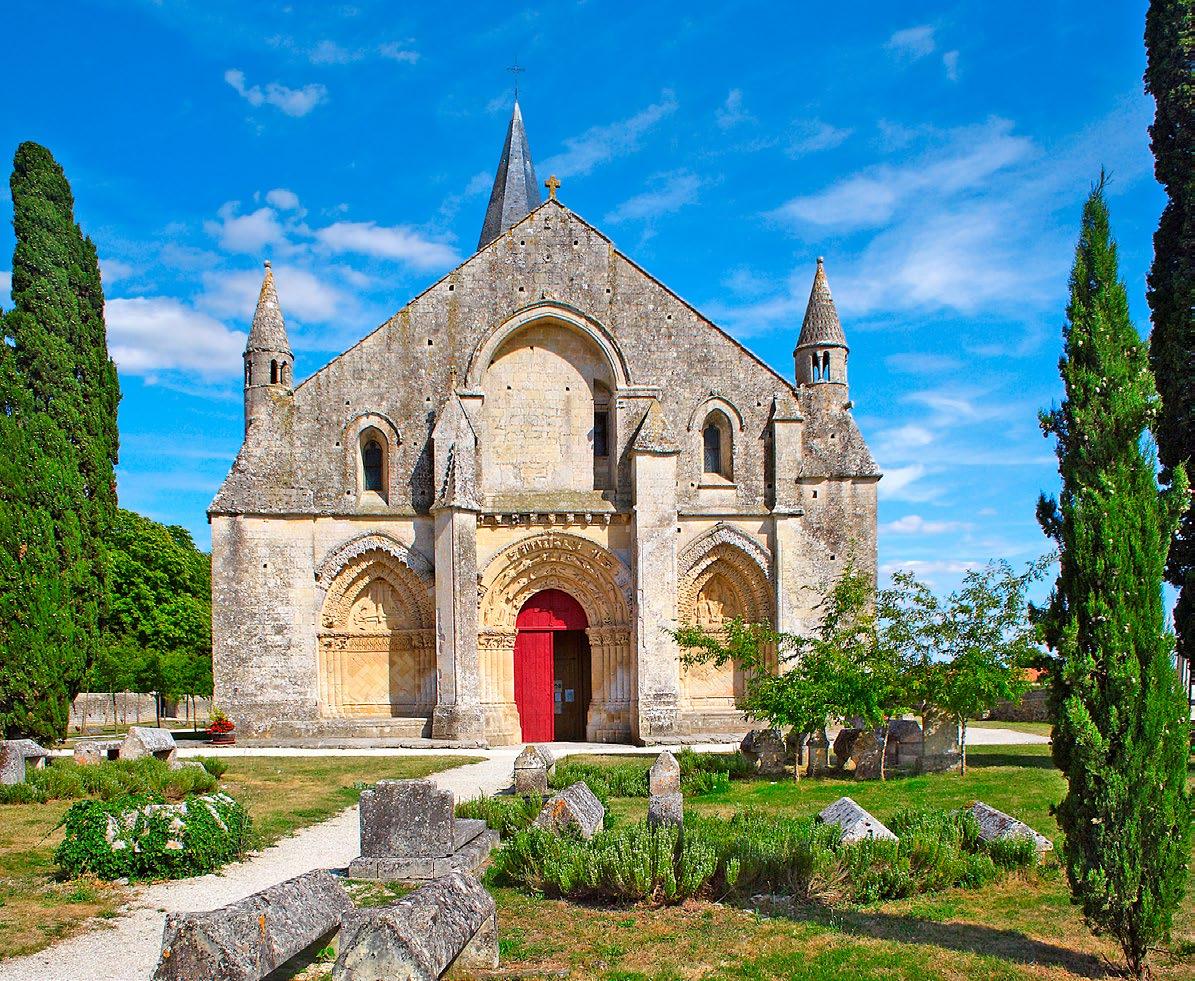



Among gentle hills and leafy valleys lie some exceptional sights. Overlooked by a feudal chateau, Aubeterre-sur-Dronne’s classic market square has colourful summer evening markets, but its real treasure lies hidden from view. The astonishing Eglise monolithe Saint-Jean is a vast troglodytic church hewn from the pale limestone (‘alba terra’) bedrock from which the village takes its name. Another surprise is the Musée des Marionnettes, with puppet theatre shows in English during July & Aug. Alternatively, explore the nearby River Dronne by canoe or kayak.
The town of Chalais’ elegant and beautifully restored chateau (occupied by the English during the Hundred Years War) welcomes visitors on Tuedays to Sundays, while Barbezieux’s own 15th century chateau retains the heavily fortified gateway of the mighty stronghold it once was. Beyond it are a museum of local archaeology and the town’s Tourist Office. Nearby is the vast Eglise Saint-Mathias, constructed during the 12th-15th centuries and still a place of pilgrimage. The largely Romanesque interior contains
www.livingmagazine.fr Living Magazine Summer Guide 2023
© CHARENTE TOURISME
The medieval streets of Saint-Jean-d’Angély
relics of the Saint, a fragment of the True Cross and vibrant 20th century stained glass by Georges Devêche. North of the town at Touzac are the exquisitely landscaped Jardins du Chaigne – ‘Jardins Remarquable’ listed gardens featuring topiary, roses, lavender and Mediterranean plants, all set among cognac vines.
The area is also known for its vineyards. You can visit a producer in a unique setting of a 12th-15th century manor house at Le Maine Giraud, near Blanzac. The former home of 19th century playwright and novelist Alfred de Vigny (celebrated in a small museum) sits among 42 hectares of vines and produces both fine cognac and Pineau des Charentes. Visits reveal traditional distillation techniques. Also worth visiting is the Moulin de Perdrigeau, a former 18th century windmill near Montmoreau Saint-Cybard. It milled grains for over a century and served during WWII as a German observation point. There’s an external staircase to the summit, where an orientation table indicates principal features among the panoramic countryside views.


WESTERN CHARENTE
Explore the riverside town of Cognac, whose historic heart preserves stately 16th century mansions built by wealthy merchants (hunt the salamander emblem of King François I, born in the Château de Cognac in 1494), medieval timber-framed houses plus old stone ‘chais’ in which barrels of fine cognacs mature to perfection. See things differently by cruising the Charente, between fields of vines & sunflowers, on a traditional ‘gabare’. La Demoiselle, a replica of the famous flat-bottomed sailing barges which transported barrels of cognac and other local produce, sails regularly from Cognac’s ancient quayside (tickets available at Cognac Tourist Office) and from Saint-Simon, known as ‘le village gabarier’. The fascinating story of the boats which were constructed on the riverbanks, and of the lives of those who sailed

| Page 39
Aubeterre sur Dronne is full of surprises
The fortified entrance to the Chäteau de Barbezieux
Eglise monolithe Saint-Jean
them, is recounted in Saint- Simon’s Maison des Gabariers. For centuries gabares served the quaysides of nearby Jarnac carrying Atlantic coast sea salt and, of course, cognac. The old towpaths and warehouses survive, and the town is home to the illustrious cognac houses of Courvoisier, Hine and Louis Royer. The celebrated Grande Champagne vineyards enfold Segonzac, behind whose 12th-15th century church is an authentic ‘lavoir’ – a village wash-house fed by fresh spring water. Nearby are several smaller cognac and pineau houses. Explore a huge network of quiet country tracks among world-famous vineyards and fields of vibrant sunflowers in perfect peace by hiring a bike – or even on horseback.
On the 27th of each month Rouillac hosts one of France’s largest markets and Aigre, with a long tradition of cognac trading, is another market town. There’s history too – in nearby Ligné the Cimetière des Chevaliers preserves 70 engraved Knights Templar
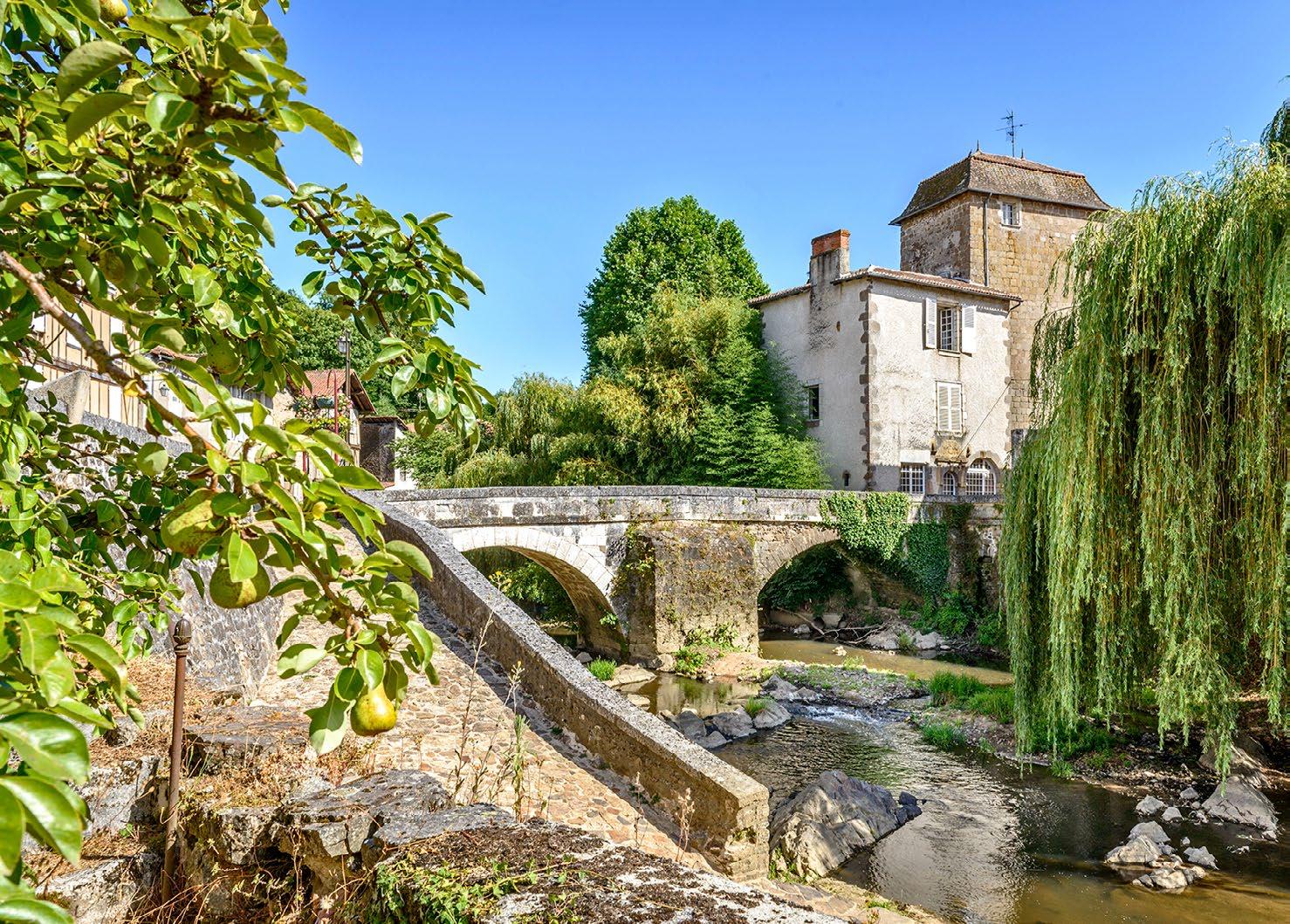
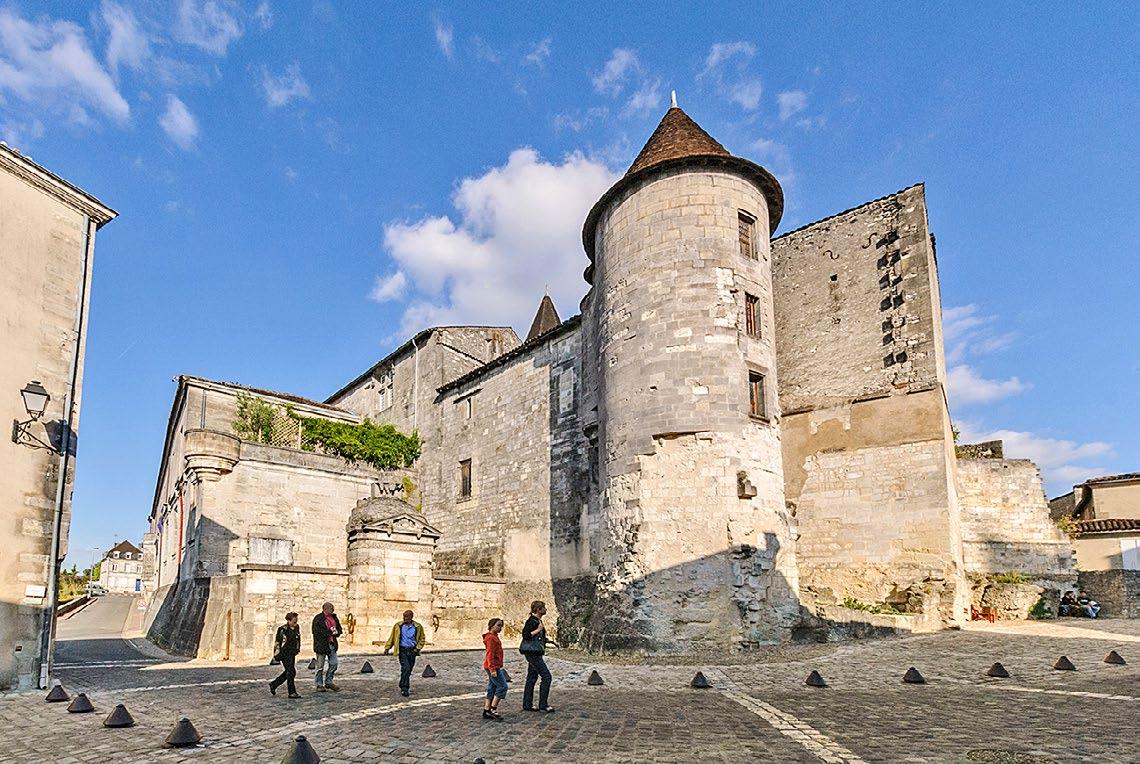

tombstones from the time of the Crusades, Saint-Brice has an 11th century abbey, while at Les Bouchauds are four GalloRoman temples and a vast amphitheatre (Rouillac Tourist Office has visit details). You’ll find many more serenely beautiful Romanesque churches in hamlets and towns throughout Cognac Country.
CHARENTE-LIMOUSINE


You’ve just found the perfect place in which to unwind. Confolens, at the confluence of the Vienne and Goire rivers, was once an important trading port, and retains 18th century mansions on each bank, plus medieval timber-framed houses around rue du Soleil. A granite tower survives from a 12th-13th century chateau, while just upstream is Saint-Germain-de-Confolens, still dominated by romantic 12th-15th century fortress ruins set on a rocky hillside. The Croix de Bellevue offers panoramic views of the Issoire and Vienne valleys, the village and its 14th century bridge. Beyond it lie a weaver’s house and a Romanesque church built on the plan of a Greek cross.
Brigeuil was fortified during the French Wars of Religion but the ancient town was already here when the Gauls struggled against the Romans. It retains 15th century portals, a Romanesque church, a 12th century monument to the dead, a Renaissance gateway and an unusual pyramid-

www.livingmagazine.fr Living Magazine Summer Guide 2023
The Château de Cognac
© AURÉLIE STAPF (PORTEURDESONGE.COM)/ MAXIME MENDIZABAL (DRONER WIN AIR)
© STÉPHANE CHARBEAU/
The riverside town of Confolens
 Cycling over the Charente near Jarnac
Cycling over the Charente near Jarnac
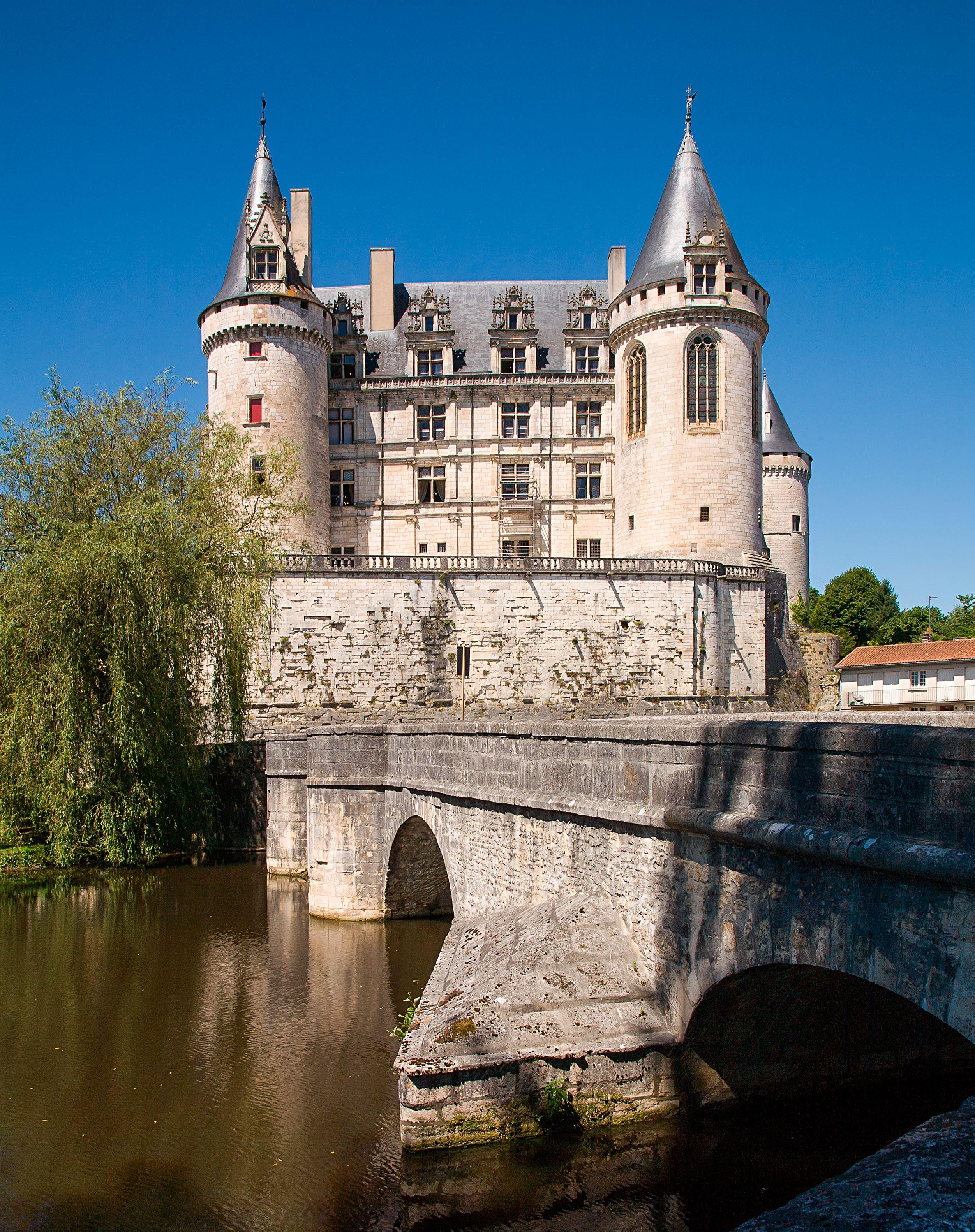 Château de La Rochefoucauld
Château de La Rochefoucauld
shaped fountain. The Romanesque church at Lesterps has a 43m high granite belfry built by Augustinian monks. Destroyed in 1040, it was rebuilt 300 years later. Champagne Mouton’s church contains the tomb of a high constable of Scots origin whose crest adorns one of the vaults.
Remarkable evidence of Roman occupation survives at Cassinomagus, near Chassenon, which preserves 1st century Gallo-Roman thermal baths, a network of aqueducts, hot and cold rooms, swimming pools and more. There are displays of archaeological finds plus guided tours for summer visitors.
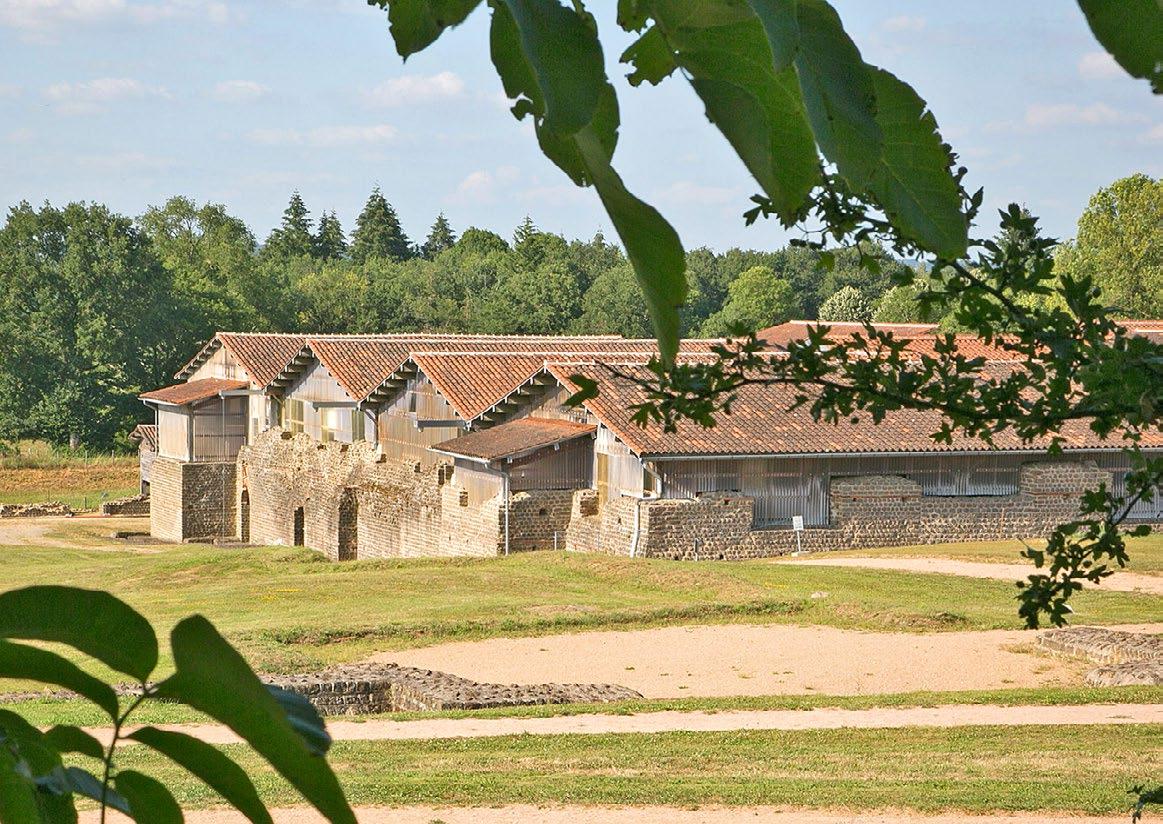

The Lacs de Haute-Charente offer swimming, sailing, canoeing, windsurfing, water-skiing and fishing on two freshwater lakes covering 400 hectares. Lac Lavaud’s water sports centre offers lessons and has lifeguard supervision, with disabled access. The lake has sandy beaches shaded by oaks and willows plus picnic spots, ramblers’ trails, shops and restaurants. Both lakes sell shore fishing permits. A hide at Foucherie allows you to observe (by appointment) up to 70 bird species, and the Maison des Lacs in Massignac offers visitor information.
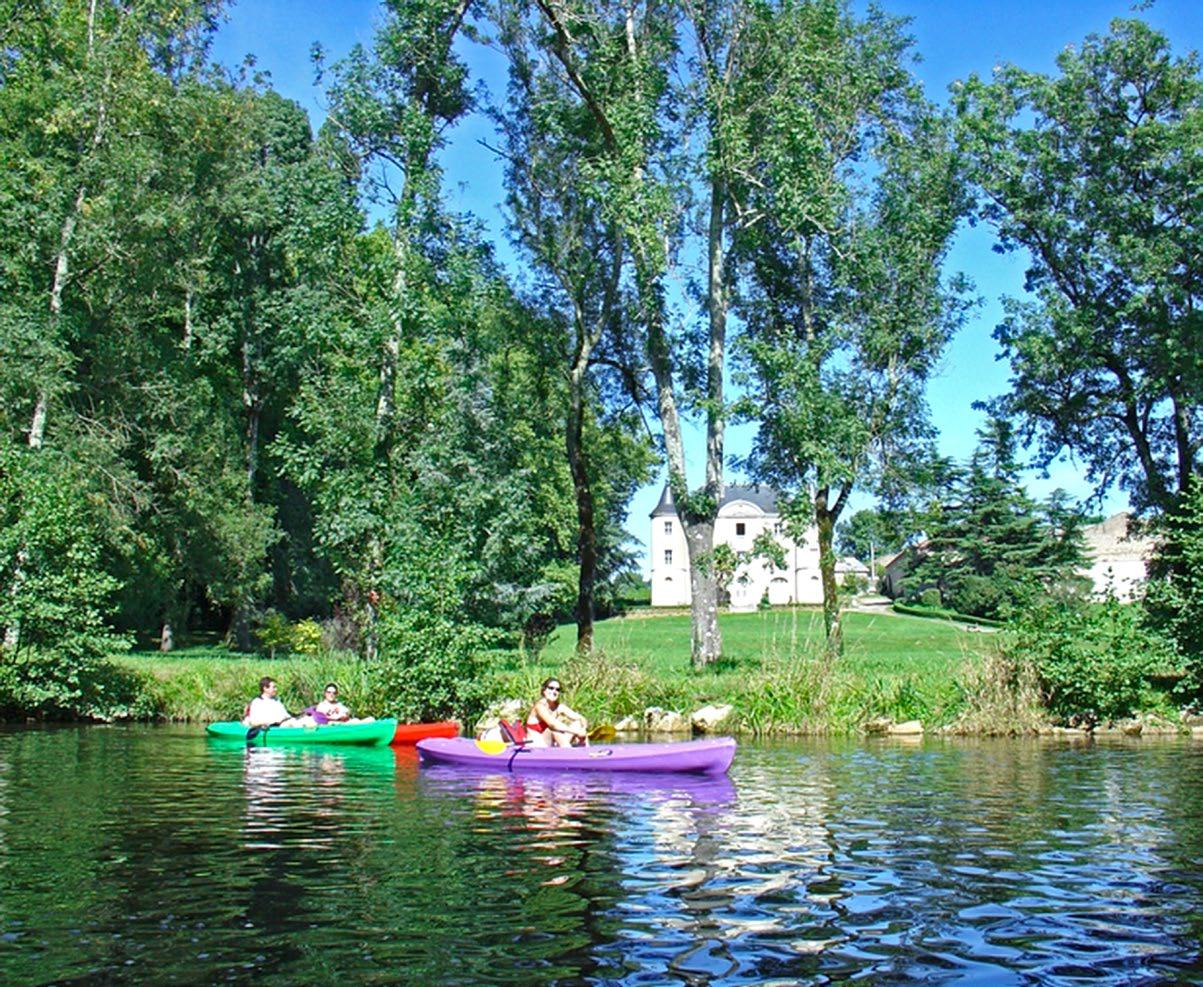
HORTE & TARDOIRE VALLEY
Set on a hill amid deepest unspoilt France, the town of VilleboisLavalette is itself overlooked by an imposing and lovingly restored 10th-13th century fortress. Join a guided tour in English (times vary, but the town’s Tourist Office has full details). Constructed in 1665, Villebois’ market hall is one of the oldest and finest in SW France, and retains its 17th century sundial. On Saturday mornings traditional stalls sell local produce including honey, bread and fresh Atlantic Coast oysters, while at lunchtimes there are restaurant tables. In nearby Magnac-Lavallette-Villars an enthusiastic volunteer labour force is painstakingly restoring the Château de la Mercerie, a flight of fancy conceived on an astonishing scale by two brothers during the 1930-70s.
La Rochefoucauld is another atmospheric market town dominated by a mighty chateau (left). The 11th century donjon was joined by the round towers around 1350, other features being added in 1760. You can visit parts of the chateau, which still belongs to the La Rochefoucauld family, one of the oldest noble families in France. The nearby 4,000 hectare Forêt de la Braconne has walking trails leading to huge natural pits up to 55m deep.
Along both the Horte and Tardoire rivers lie a number of restored working mills, producing different kinds of flour plus pure walnut and hazelnut oils, while the Moulin de la Pierre at Vilhonneur is France’s only water-powered mill still cutting limestone. See the area in perfect peace by canoeing gently down the Tardoire river, past mills and chateaux – particularly recommended is the journey down to the Chambon Gorges (Montbron Tourist Office has details). Alternatively, stroll on some of the many paths which lead to silent oak and chestnut forests. If you love trees, don’t miss the Arboretum Jean Aubouin du Clédou at La Mothe-Clédou. A trail created by the Office National des Forêts leads you among over 10 hectares of trees from almost 40 countries, including giant sequoias.
| Page 43
Canoe along the Tardoire near Montbron
Follow in Roman footsteps at Cassinomagus
Forêt de la Braconne features deep natural pits
ANGOULÊME (16)



Set high on a limestone plateau, the heart of old Angoulême contains medieval buildings and elegant 18th & 19th century mansions and townhouses. You’ll also see hints of Angoulême’s International Comic Strip Festival and museum, in hip, colourful cartoon-style murals by created by talented artists - the Tourist Office has a handy map or you can download the app ‘Murs BD’.

The 12th century Romanesque Cathédrale Saint-Pierre (right) was embellished by the architect who created the Sacré-Cœur Basilica in Paris. Behind the cathedral is the Musée d’Angoulême, with 1620th century works of art, dinosaur bones from important nearby fossil beds of Angeac-Charente and much more.
The Hôtel de Ville retains a tower from an earlier château

Stroll along the medieval ramparts for elevated views of the Charente valley. The river once powered the city’s paper mills, whose long history is brought vividly to life in the Musée du Papier Le Nil, housed in an atmospheric former paper mill with giant water wheels. The nearby riverbanks are now landscaped leisure areas. Alternatively, follow the old towpath (la Coulée Verte) by walking or cycling – there are many picnic spots en-route to the Plan d’Eau de la Grande Prairie. This lakeside family attraction, set among 50 hectares of parkland at St Yrieix (below), has a sandy beach and swimming pool, along with facilities for many water sports including canoeing and sailing.


www.livingmagazine.fr

 Stop for a photo at beautiful Angles sur Anglin
Stop for a photo at beautiful Angles sur Anglin
HISTORIC POITOU

AROUND VIENNE

Welcome to an ancient land once ruled by the Plantagenêts, and whose name derives from that of Poitiers, capital city of the modern-day département of Vienne.
Some way to the north of Poitiers, at the final navigable stretch of the River Vienne, lies the town of Châtellerault, which from the 13th century exploited both its strategic location and highlyskilled artisans to develop important cutlery, sword-making, ropemaking and tanning industries. These ancient trades have largely disappeared locally, but echoes remain in ‘La Manu’, a 19th century former munitions manufacturing complex now home to an ice rink and the renowned Auto Moto Vélo historic vehicle museum The town was also the home of philosopher René Descartes, and the 12th century Eglise Saint-Jacques adds another dimension to a visit, making Châtellerault well worth getting to know.
Down river is Chauvigny, one of Michelin Travel Guides’ Top 100 Small Towns in France to Visit. Rising above the medieval town, the Château Baronnial, Château d’Harcourt, Château de Montléon, Donjon de Gouzon and the Tour de Flins create a spectacular effect. In the old upper town lie charming narrow streets and interesting architecture, including two lovingly restored Romanesque churches.
SOUTHERN TOWNS & VILLAGES
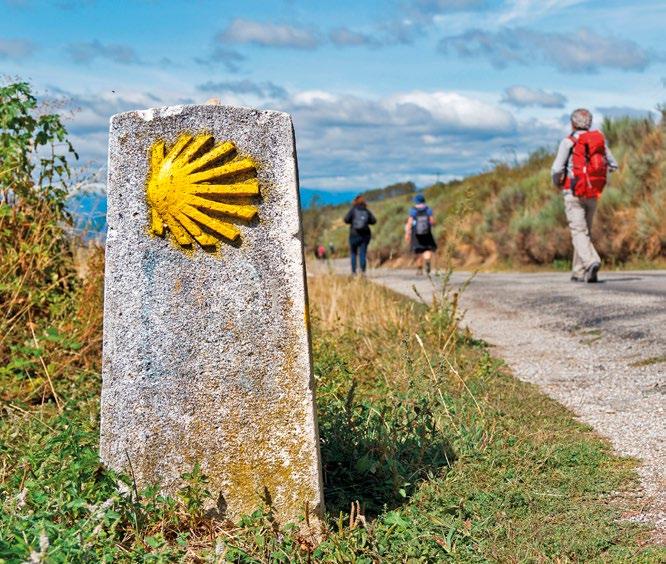
Further south-west at Charroux is a medieval covered market hall and the startling Tour Charlemagne, an 11th century lantern tower from the once-grandiose Abbaye Saint-Sauveur (below). The abbey ruins, including their important Gothic statues, are open to visitors. The historic market town has long been a halt for pilgrims bound for Santiago de Compostela, and was the seat of the French government for six years during the Hundred Years War. From Charroux the River Charente flows discretely towards Civray, a peaceful market town (markets Tues and Fri mornings) long popular with visitors. Overlooking a broad market square is the large 12th century Eglise SaintNicolas, whose interior is an unexpected jewelbox of painted decoration. Along the peaceful riverbanks and park nearby you’ll find several shaded picnic spots.
Châtellerault’s
celebrates the town’s industrial past
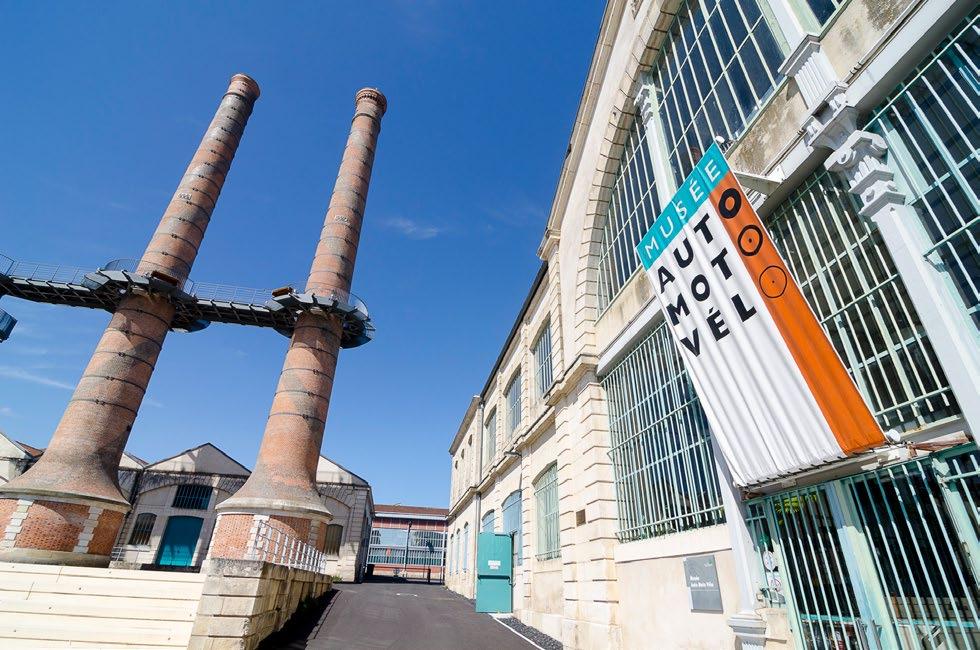
| Page 47
This ancient land is home to fields of sunflowers, gently-meandering river valleys, atmospheric market towns & villages, plus Romanesque architecture, a motor-racing circuit and the Futuroscope family attraction park.
The rooftops of Chauvigny
‘La Manu’
THE UPPER REACHES OF VIENNE

North east of Chauvigny is photogenic Angles-sur-l’Anglin, one of Les Plus Beaux Villages de France and an essential visit. Its name derives from Saxon ‘Angles’ tribes who invaded England in the 5th century, and from the river flowing through the heart of the lower village (the upper village is tucked away behind the chateau). It’s famed for ‘Jours d’Angles’ – delicately embroidered fabrics – and for the 15,000 year-old Magdalenian sculptures in the Roc-auxSorciers (Sorcerer’s Rock). Further south is Saint-Savin’s ancient abbey (left), a UNESCO World Heritage Site whose glorious 11/12th century wall paintings have prompted the title of ‘the Romanesque Sistine Chapel’.
Continue south and you’ll reach Montmorillon (right). Overlooking the River Gartempe, it has a passion for writing, calligraphy and everything to do with books. The Eglise NotreDame and its crypt contain medieval frescoes and the graceful Vieux-Pont has spanned the river since 1404.


Thrill seekers love L’Isle Jourdain, which in summer offers bungee jumps and zipwires from a spectacular 40m high former railway viaduct, water-skiing on the Lac de Chardes, and high-octane thrills at the nearby Val de Vienne motor racing circuit.
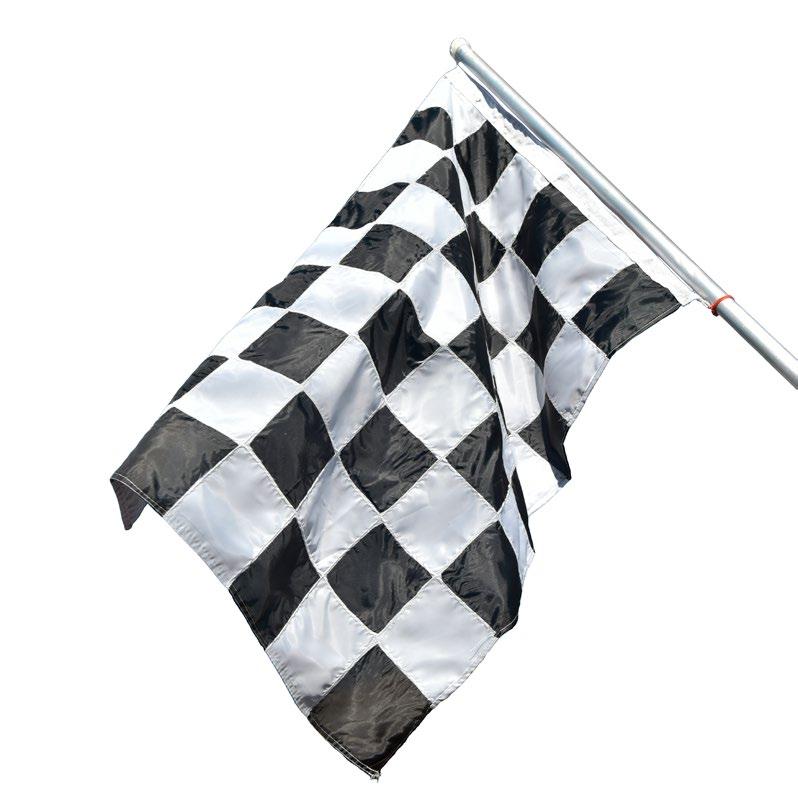


A few kilometres west at Saint-Martin-l’Ars is the Abbaye de La Réau (left), founded 850 years ago, and whose formal gardens are being lovingly restored. Children can go on a treasure hunt dressed in monks’ attire and other activities include stonecutting, calligraphy and traditional breadmaking.

www.livingmagazine.fr
La Cité de l’Écrit, Montmorillon

IN LEAFY DEUX-SÉVRES
The Deux-Sèvres département, an unspoilt realm of forests, lakes, quiet towns & villages, has peaceful lanes ideal for cycling among old watermills, ancient Romanesque churches and two Sèvre rivers.
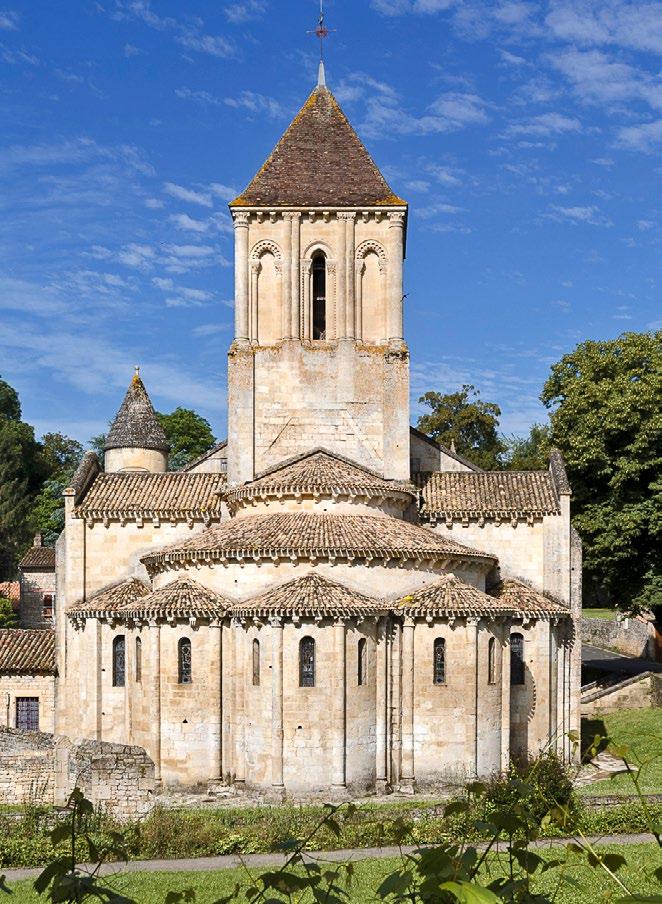
Deep in the Gâtine countryside lies the town of Parthenay, whose Saint-Jacques medieval quarter preserves timber-framed houses, a 13th century chateau, granite fortifications and Romanesque churches. Further afield are the tiny medieval towns of Airvault and Saint-Loup-Lamairé, character villages like Gourgé and Saint-Généroux, plus Pougne-Hérisson’s curious storytelling gardens, ‘Le Nombril du Monde’.
Further north, Bressuire is the gateway to the Bocage - an area of small fields, hedgerows, rivers, gentle hills and woodland. Quiet lanes pass watermills, windmills, wayside chapels, shrines and Romanesque churches along a Compostela pilgrimage route. See the frescoes at Saint-Clémentin’s beautiful 13th century Chapelle des Rosiers, whose metal steeple is one of only three in all France.

Parthenay sits high above the River Thouet
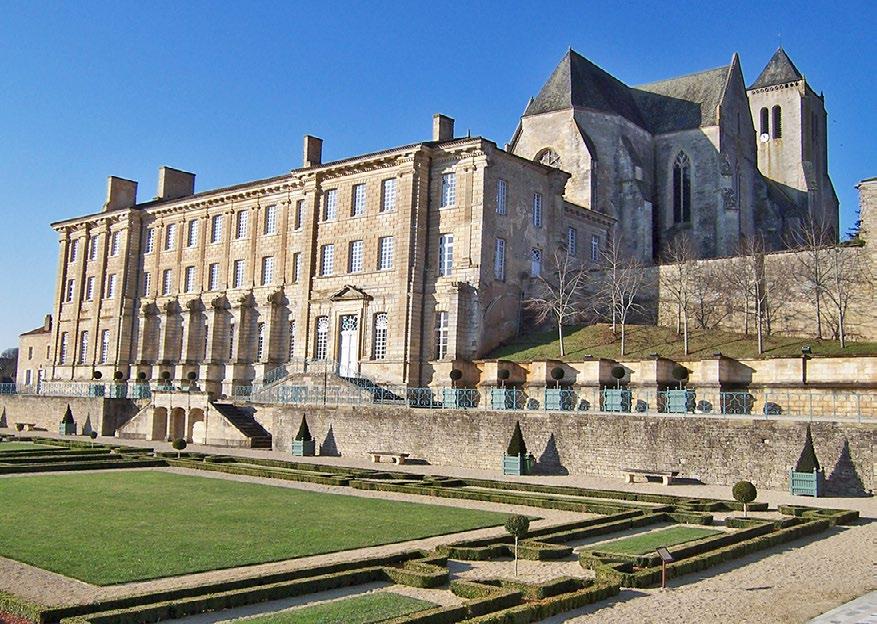

A WEALTH OF HISTORY


Follow the river Thouet to historic Thouars, which hosts art exhibitions and the largest market in Deux-Sèvres. Celebrated for its floral displays, this ‘Ville d’Art & d’Histoire’ has many listed buildings, extensive wartime exhibits in the Centre Régional Résistance et Liberté, and a remarkable 19th century water turbine mill, while botanists appreciate the Pressoir valley’s biodiversity. Nearby, the Oriental Garden at Maulévrier is exquisite, and the magnificently restored Château d’Oiron rivals those of the Loire Valley – its contemporary and fine art collections are unique in France. Further south the market town of Melle has ancient silver mines which once supplied the French mint, plus three Romanesque churches – the Eglise Saint-Hilaire is a UNESCO World Heritage Site. Encircling the town, the Chemin de la Découverte is an awardwinning arboretum and rose walk. Nearby Celles-sur-Belle has a magnificent Abbaye Royale where neo-Classical architecture meets Flamboyant Gothic style. Just behind it, the Musée Pierre Certain displays a collection of historic motorcycles.

www.livingmagazine.fr Living Magazine Summer Guide 2023
© DARRI PARC NATUREL RÉGIONAL DU MARAIS POITEVIN
THE MARAIS POITEVIN
At the heart of France’s second largest wetland area is the Sèvre Niortaise river, made navigable by order of Napoléon in 1808 to enable traditional barges (gabares) to sail between Niort and the Atlantic coast ports. Today the natural, unspoilt environment is perfect for walking, cycling, horse riding and of course boating, all of which have hire facilities. The abundant wildlife includes otters, and the Marais is a stopover for migratory birds - you’ll see many species at St-Hilaire-la-Palud’s ornithological park.
Neolithic man inhabited an area extending to the Baie d’Aiguillon on the Atlantic Coast. Draining the marshes began in the 10th century, but it was only after the Hundred Years War that work really began in earnest. By the 17th century the Marais had finally begun to look broadly as it does today. The classic way to see it is to park your car in a village (motorhomes have parking and services in Arçais, Coulon and Mauzé- sur-le-Mignon) and enjoy a more environmentally friendly option. Discover the tranquillity of the canals by taking a trip in a traditional flat-bottomed boat from Coulon, Arçais, St-Hilaire-la-Palud, La Garette, Maillezais or Le Mazeau. Hire points offer varied packages, but it’s well worth taking a guide, who will navigate through the labyrinth of conches, fossés and rigoles, while providing anecdotes about the history of the Marais.
Hire a bike from Coulon, Arçais or La Garette and enjoy 50km of flat cycle tracks - since they wind between the waterways, you’ll have no hills to climb! To take things even more gently take a stroll on marked footpaths (pick up a map of suggested itineraries from local tourist offices). Another popular way to discover the Marais is on horseback, you can even visit the countryside in a horsedrawn carriage or a land
As for the villages, Coulon, Arçais and Magné lie in the heart of the wetlands, and are popular with visitors. Coulon



is the Marais Poitevin’s notional capital, and was once a bustling port. Its history, and that of the Marais, are recounted in the Maison du Marais Poitevin museum. Arçais also had a busy river port, but today charms visitors with cobbled streets, chateau ruins plus craft and antique shops. Magné has an island setting between the Sèvre Niortaise and Sevreau rivers, with a Gothic church and a 19th century lock-house called the ‘Marais-Pin’. Le Bourdet is famed for its 2km path called ‘Le Sentier de la Maraîchine’ (a reference to the local breed of cattle which still graze here) plus botanical and geological circuits. Each village reveals its own secrets, with picturesque streets, traditional marsh houses, boutiques and art galleries, churches, traditional washhouses, locks, bridges and dovecotes.
Coulon’s Maison du Marais Poitevin is one of four differently themed museums in the Marais.
| Page 51
POITIERS (86)
This vibrant hilltop city, overlooking the Boivre and Clain rivers, has a colourful historic heart with the highest density of ‘Monument Historique’ architecture outside Paris. They include Gallo-Roman remains, Romanesque and Renaissance buildings, a vast Gothic cathedral, plus half-timbered medieval houses. There are many more surprises among the pavement cafés around the beautifully renovated Place du Maréchal Leclerc and the bustling market in Place Charles de Gaulle. Maps, information and guided tours are all available at the Tourist Office.
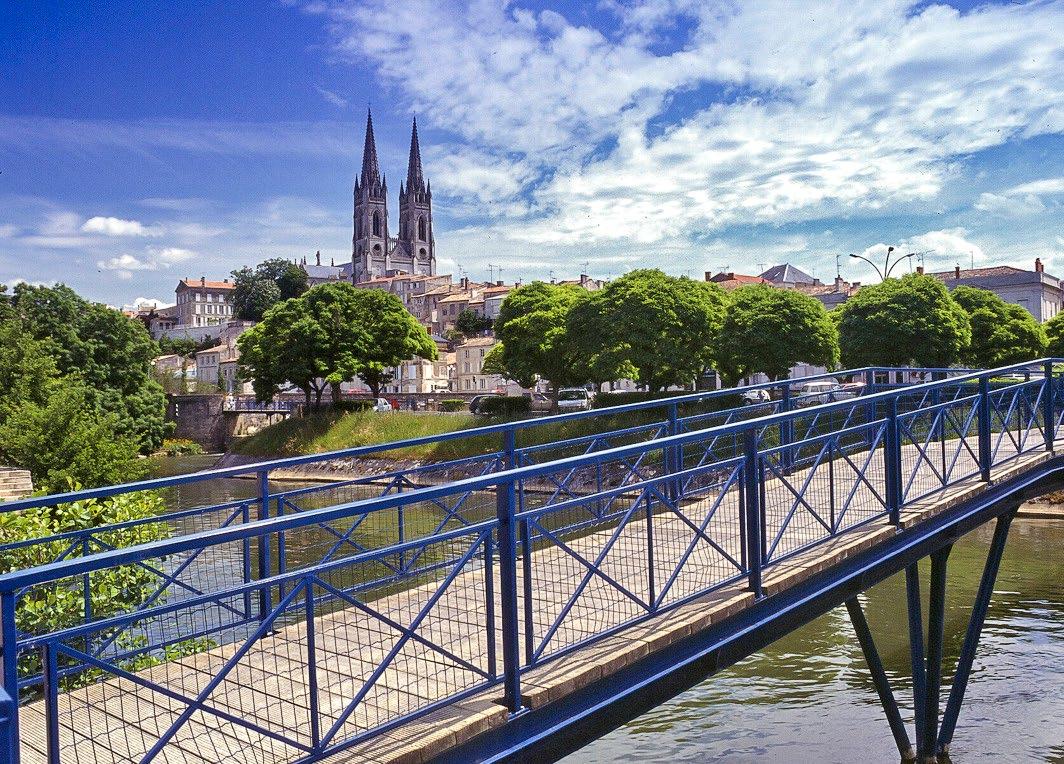
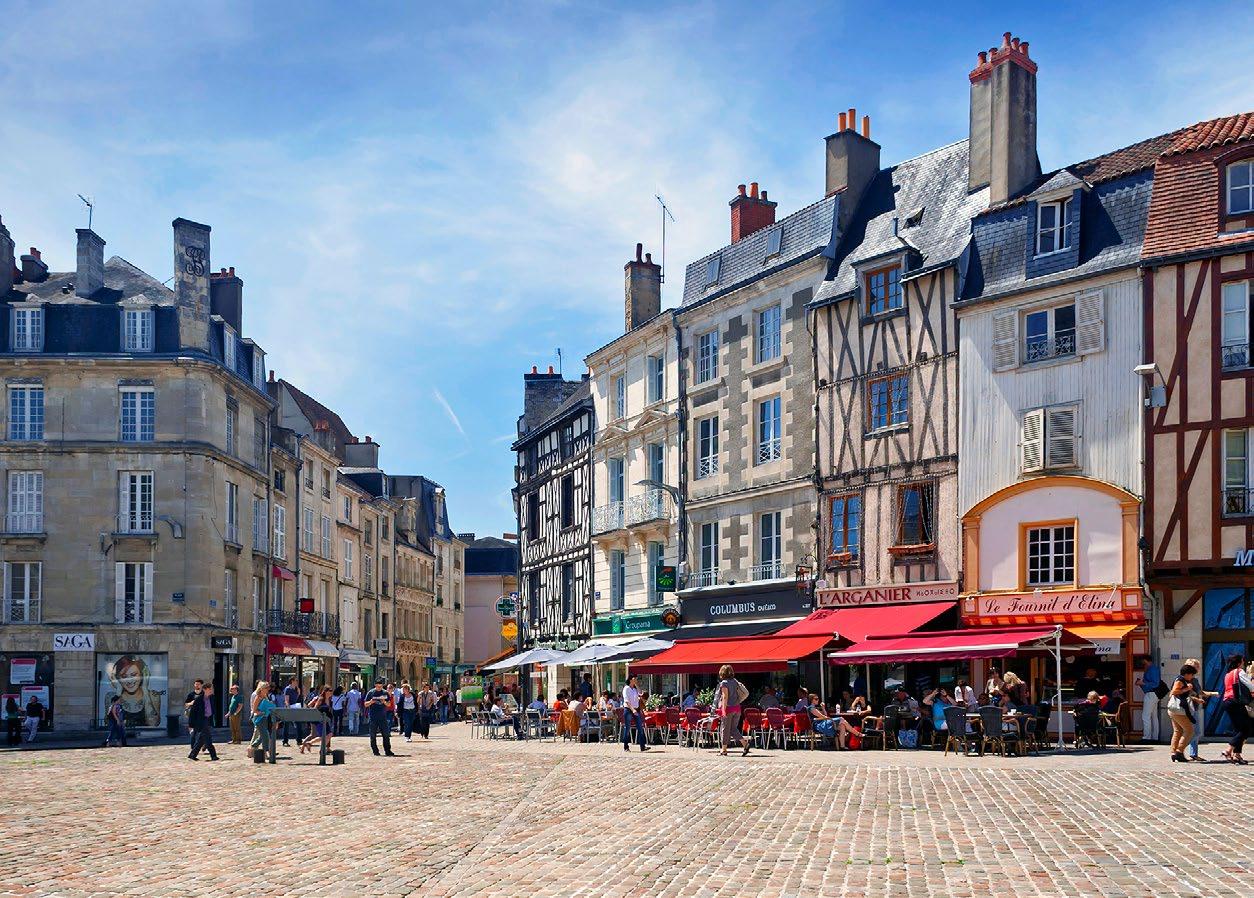
The 4th century Baptistère Saint-Jean is France’s second oldest Christian building. Nearby, the Cathédrale Saint-Pierre was begun in 1162 by Henry II and his wife, Aliénor of Aquitaine. The Crucifixion window stained glass and stall carvings are dazzling medieval masterpieces. The Eglise Notre-Dame-la-Grande in place Charles de Gaulle is one of France’s finest Romanesque churches, with a jewelbox interior. Its western façade’s original vivid medieval colours are recreated at 10.30 each evening in Les Polychromies, a free light show. In rue Gambetta the Palais de Justice conceals a vast 12th century Gothic hall, seat of the Counts of Poitou and Dukes of Aquitaine.
The 11th century Eglise SainteRadegonde contains the Saint’s tomb, with what is claimed to be Christ’s footprint in stone. Also worth seeing: the 7th century Hypogée des Dunes underground chapel and the prehistoric Pierre-Levée dolmen near the Pont-Neuf, where Renaissance writer François Rabelais carved his name while a student at the city’s university.
CITY BUZZ



NIORT (79)
Niort’s once busy quaysides handled hides for tanning and chamois leather businesses supplying the French army. In recent years the city centre has undergone an imaginative transformation, with convenient underground parking making exploring on foot a pleasure. The Donjon d’Aliénor d’Aquitaine (below), a mighty fortress, towers assertively above the Sèvre Niortaise river. It was begun by Henry Plantagenêt and Aliénor d’Aquitaine when England ruled much of western France, and was completed by their son, Richard Cœur de Lion. Don’t miss the views from the summit – an orientation panel identifies many of the surrounding features.

Beside the Donjon are Les Halles de Niort – a magnificent iron and glass market hall, where local producers display their wares each morning (except Mon). Across the river on an island stands the 12th century Fort Foucault, but the town’s crowning glories are the 75m-high twin spires of l’Eglise Notre-Dame. At the foot of the old quarter is Le Pilori – a pre-Revolution town hall, which now hosts art exhibitions.
There’s lots more to see in Niort: fine art and natural history collections in Le Musée Bernard D’Agesci; the Moulin du Roc theatre and cinema centre; La Porte Bleue, exhibiting creative digital works; half-timbered medieval houses around rue Victor Hugo; the landscaped place de la Brèche, now with picnic spots and children’s play area, plus the cool haven of the Jardin des Plantes. At the entry to the shopping areas four bronze dragons created in 1992 commemorate a 17th century local legend.

www.livingmagazine.fr
After unwinding amid the calm of the countryside, you’ll find the Poitou capitals offer lots more than shopping and dining
Niort skyline Café culture, Poitiers
The Grande Salle of the Palais des Ducs d’Aquitaine, Poitiers

EXPLORE ON TWO WHEELS

Parking the car and switching to pedal power on two wheels brings a whole new sense of freedom. Roll in perfect peace with only birdsong for company; wildlife often won’t hear you coming. Around our quiet countryside you’ll see lots of signed cycle routes (‘pistes cyclables’), specially created to offer something for all interests, abilities and fitness levels. Most will take you on a circular itinerary, so you won’t have to retrace your tracks to get back to your starting point – and since one circuit often overlaps another you can easily combine them and add more distance if the mood takes you.
ON COUNTRY BYWAYS


To get started, how about a gentle taster? Just follow a route beside a river or canal and you’ll avoid hills altogether. The famous Marais Poitevin (see page 30), for example, has bike hire points plus a dazzling choice of signed cycle tracks on which to explore a huge network of waterways, with stops at character villages along the way.
Four maps entitled ‘Le Marais Poitevin à Bicyclette’ are on sale at local tourist offices and reveal routes on 65 circuits in CharenteMaritime, Deux-Sèvres and Vendée. They make great travelling companions, particularly if you decide to return in future years and eventually ride them all.
Further north lies another haven for cyclists, among the beautiful, varied landscapes of the Vallée du Thouet, which runs through the historic towns of Thouars and Parthenay.
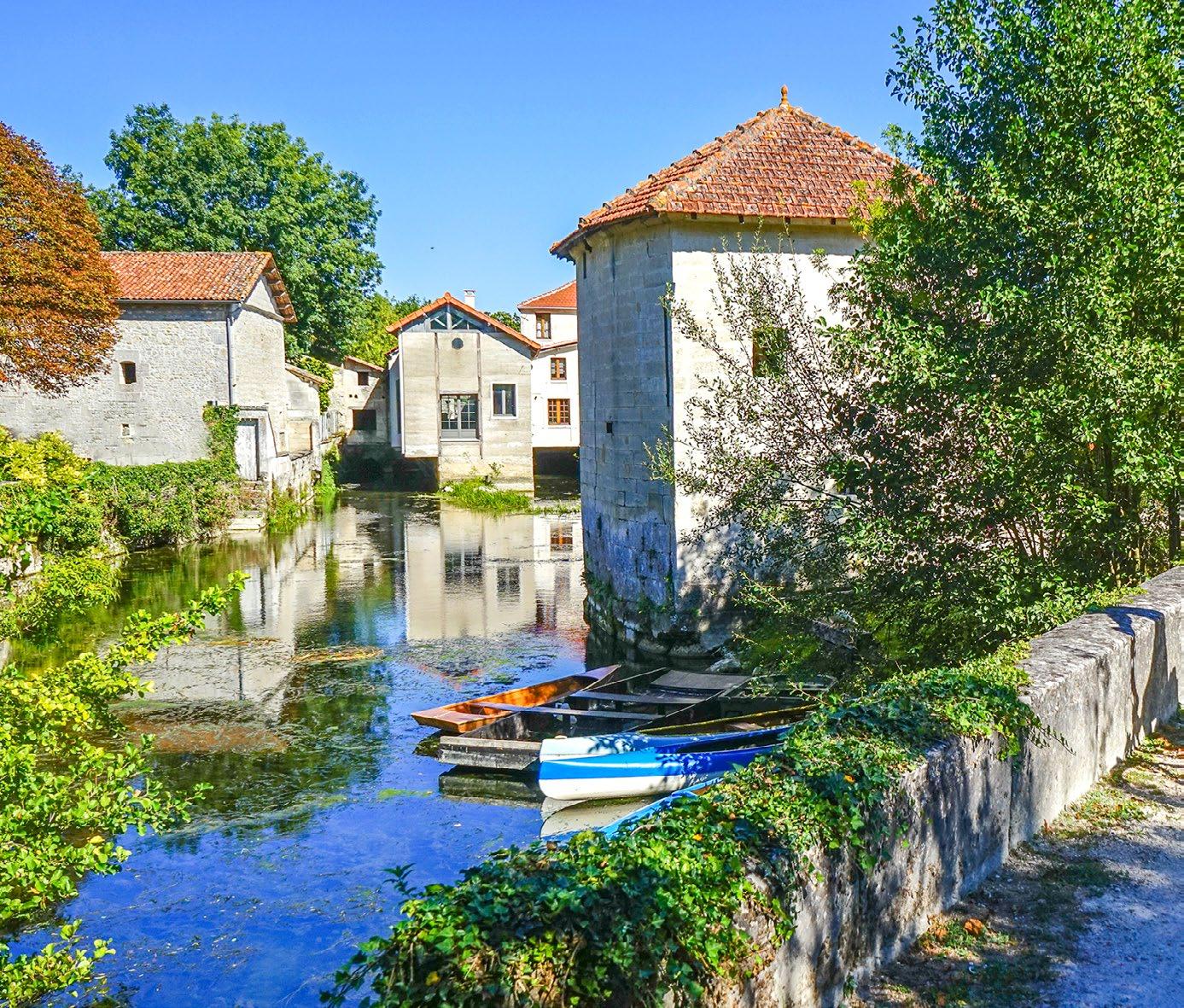
SCENIC COASTAL RIDES
Cycling with the seashore for company is the kind of magical experience you’ll never forget, and there are lots of opportunities along the sunny Atlantic Coast, starting in the north beside the baie de l’Aiguillon (a National Nature Reserve). Just below it is bikefriendly La Rochelle, where you can hire one of the famous yellow bikes and explore 160km of cycle routes at your own pace. Further south you can ride along the promenades of Châtelaillon Plage and Royan, or around the peninsula of Fouras-les-Bains.

www.livingmagazine.fr Living Magazine Summer Guide 2023
Wherever you are, hop on a bike and you’ll see things differently – and you’ll actually see and hear different things, in places where a car can’t take you.
AROUND THE ISLANDS
Both the Île de Ré and the Île d’Oléron are great for bikes, with extensive networks of clearly-signed dedicated cycle routes –follow them through colourful villages, around the coastline, among pine forests and even past vineyards. In fact, if you decide to camp you can spend a whole week or more on two wheels, with no car parking spaces to find before you can relax on the beach. For a heightened taste of island escapism take a boat ride from Rochefort, La Rochelle, La Tremblade or the neighbouring islands to the smaller Île d’Aix – you can hire a bike on the quayside and head off to find a hidden beach or a perfect picnic spot.
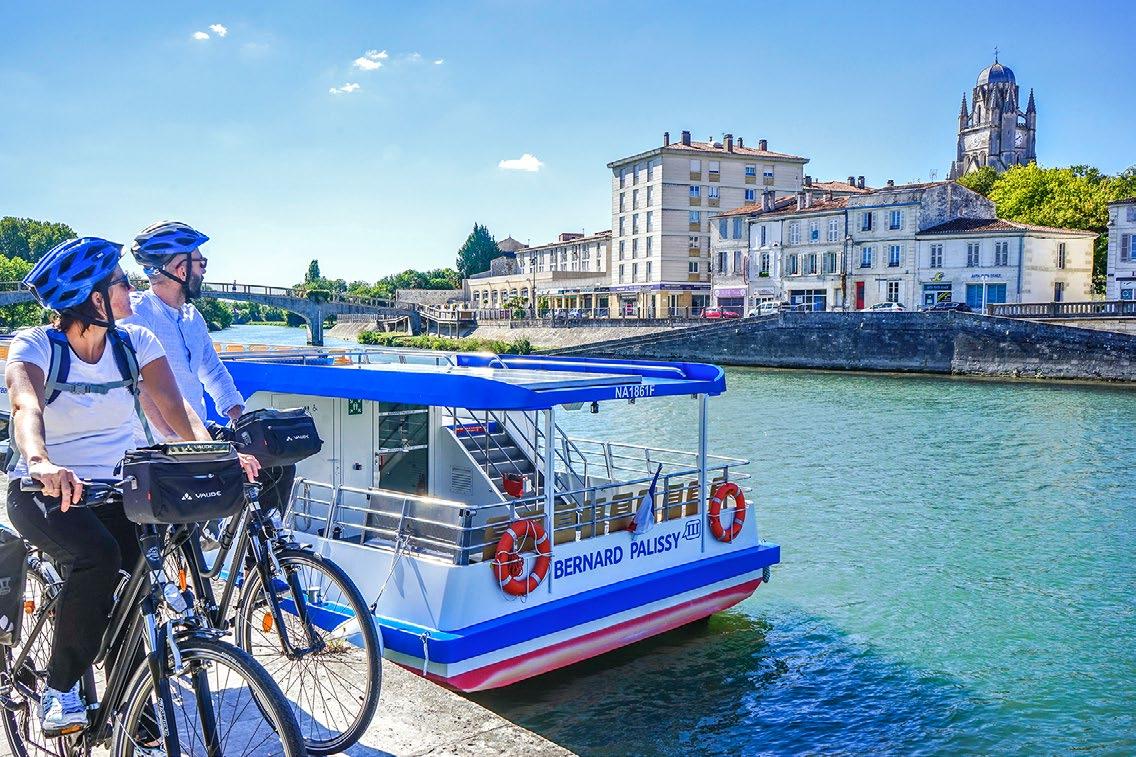

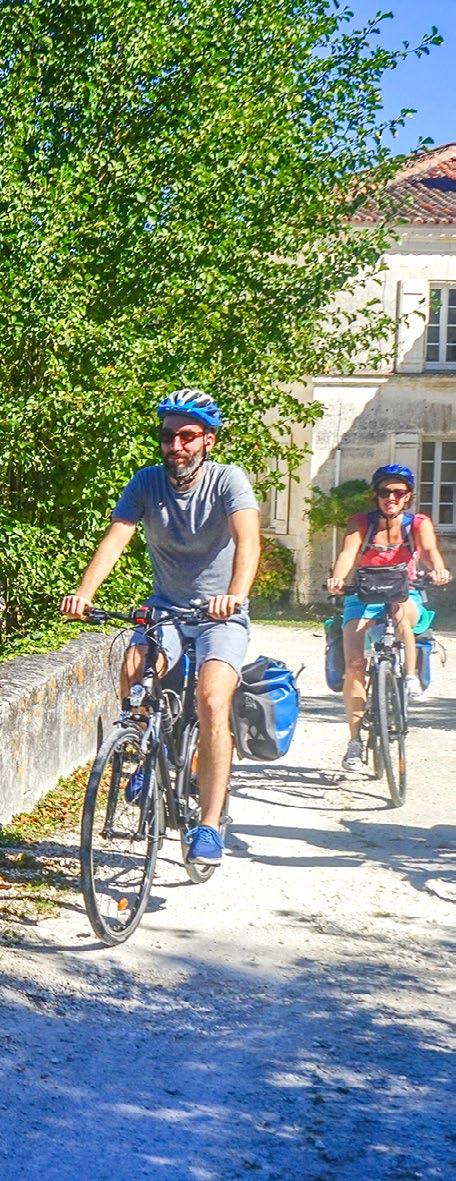
WANT MORE MILEAGE?
If you really want to spread your wings and see even more sights, La Flow Vélo is a new national ‘slow tourism’ cycle route running for almost 290km from Thiviers (Dordogne) to the Île d’Aix. En-route there are connections to onward longdistance EuroVelo cycle routes all the way to Trondheim (Norway) and Saint-Jacques de Compostéla (Spain), not to mention the famous Vélodyssée linking the UK with the Basque Coast. Of course, if you really fall in love with the sense of away-from-it-all escapism which cycling brings, why not plan a return visit to experience your favourite rides when the summer crowds have gone? Chances are you’ll have the marked trails all to yourself, apart from a few local riders making the most of the perfect peace and quiet. Magical!
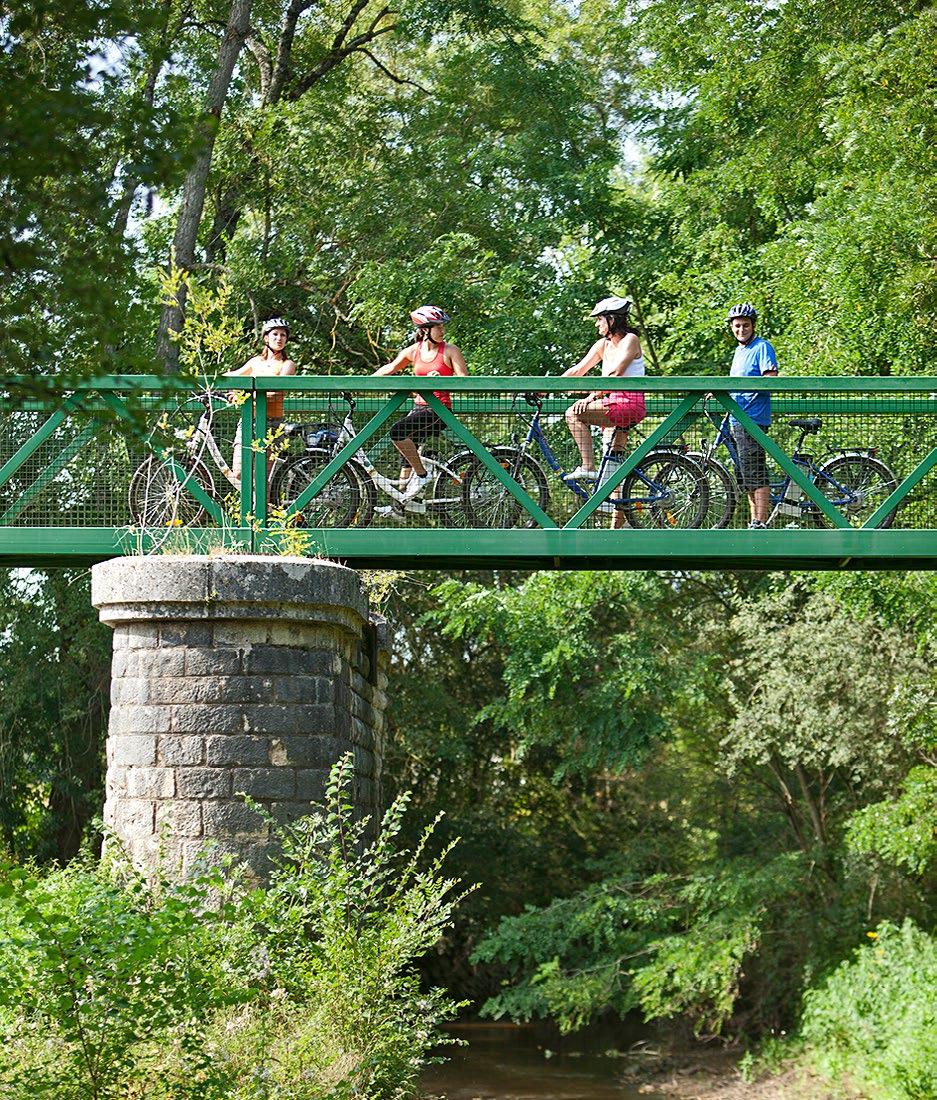
| Page 55
© AURELIESTAPF-PORTEURDESONGE-COM
RIVERS & STREAMS FOLLOW GENTLE
Enjoy your voyage of discovery on the roads, lanes and footpaths which often follow long stretches of our waterways – should you ever part company with the flow for a while, you’ll still have deepest, greenest France all around you.

OUR NORTHERN RIVERS
In the northwest are two rivers which give the département of Deux-Sèvres its name. The Sèvre Nantaise trickles into life near Parthenay (whose Thouet River valley is a peaceful haven for walkers and cyclists) before flowing towards Nantes and the Loire. Further south the Sèvre Niortaise visits Niort, the Marais Poitevin and the pleasure port of Marans, before joining the Vendée and reaching the Atlantic at the Point de l’Aiguillon in the Aunis above La Rochelle. The river attracts countless bird species. In the
northeast are three more rivers to explore. The Gartempe flows calmly through the Vienne département via Montmorillon, SaintSavin (whose huge abbey is a UNESCO World Heritage Site) and spa town La Roche-Posay. The mood changes among the rugged Portes d’Enfer (Gates of Hell), a remote spot 15km southeast of Montmorillon and popular with advanced kayakers. Soon the Gartempe joins the mighty Vienne river, which looks a picture at Chabanais, Confolens and further north at L’Isle-Jourdain, Lussacles-Châteaux, Chauvigny and Châtellerault. You can even rent a cabin on a lake for the complete on-water experience - just remember to bring your mosquito repellant!
IN DEUX-SEVRES & CHARENTE-MARITIME



Our star river is the 380km-long Charente, whose attractive, lesserknown tributary the Boutonne begins in Chef Boutonne near the elegant Château de Javarzay, lovingly restored and open to visitors. Just downstream is Brioux-sur-Boutonne, an ancient river crossing on a Roman road used by pilgrims bound for Santiago de Compostela. In a peaceful spot nearby is Dampierre-sur-Boutonne’s moated Renaissance chateau, which welcomes visitors (its formal gardens include a large, labyrinth-style maze).
Ahead lies medieval Saint-Jeand’Angély, which has canoes and kayaks for hire beside the River Boutonne. Beyond Tonnay Boutonne the river enters coastal wetlands and flows into the Charente between SaintSavinien and Rochefort.
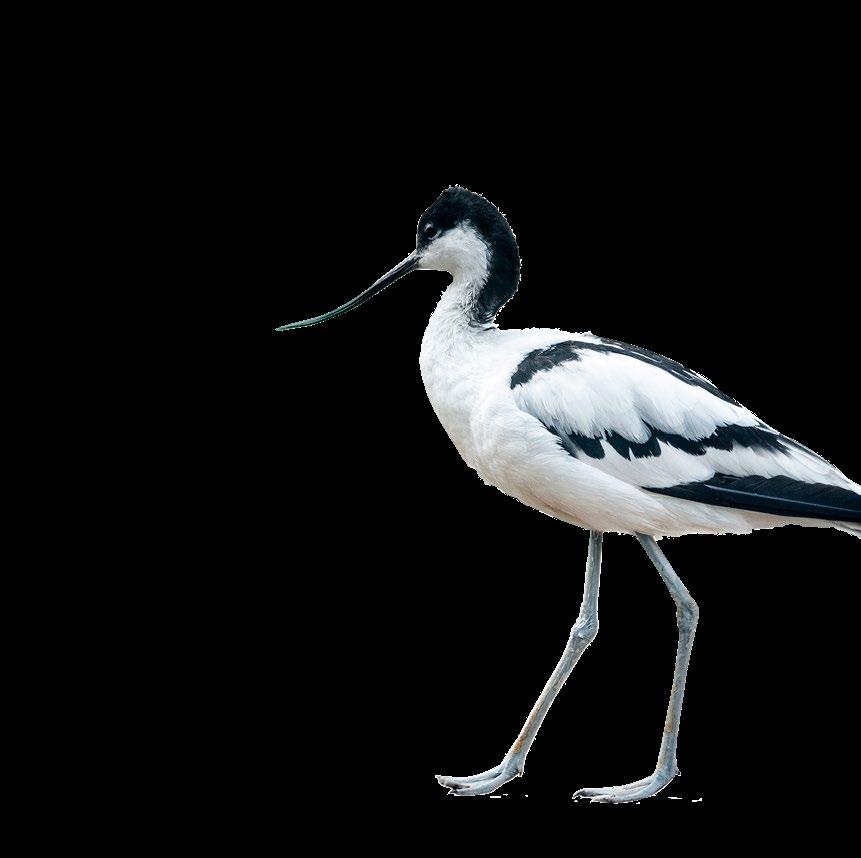
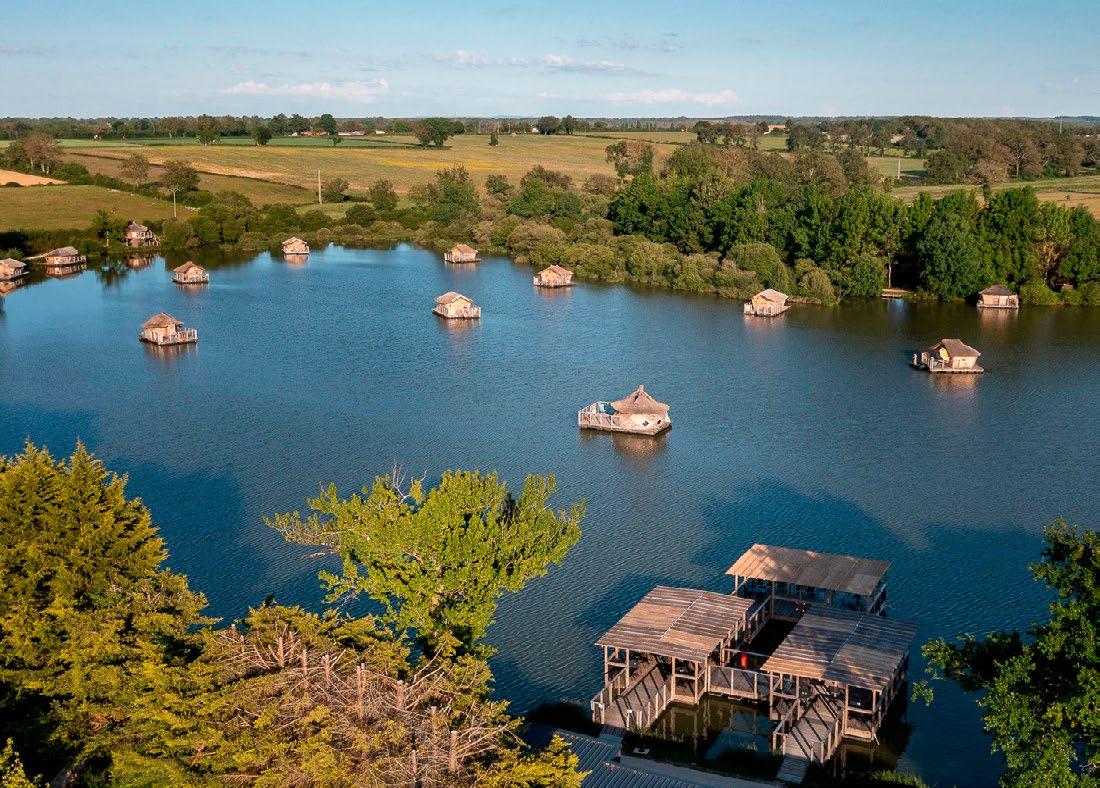
www.livingmagazine.fr Living Magazine Summer Guide 2023
Follow the course of a river and you’ll see remarkable places and lots of wildlife you’d otherwise miss. Drive, cycle, walk, hire a boat or just relax...
BESIDE LA CHARENTE

The River Charente surfaces in neighbouring Limousin and enters our region near the Lacs de Haute Charente, a beautiful setting for sailing, fishing, cycling, walking, birdwatching or a shaded picnic (or on a sandy beach). In nearby Massignac is a family adventure park. The river flows all the way to the Atlantic coast, with many surprises along the way. At Charroux there’s a 16th century market hall, a vast 11th century tower (la Tour Charlemagne) and romantic abbey ruins. Nearby Civray’s Romanesque church overlooks a market square (markets Tuesday and Friday mornings) and further on lie tranquil, Turneresque landscapes around Voulême.

Downstream at Verteuil-sur-Charente a fairytale chateau overlooks the riverbanks, while for city buzz and some boutique browsing just follow the river south to Angoulême. The historic quarter sits on a plateau high above the river, which powered the mills that made the city a renowned paper producer. Hire a houseboat from nearby Intercroisières (no permit required) and take your time exploring the river. You can enjoy also a cruise in a replica sailing barge at the old port of Saint-Simon, or continue to Jarnac, home of world-famous cognac producers and birthplace of former French President François Mitterrand.
Next come Cognac, Saintes (a gracious town with important Roman remains), the Château de Taillebourg and one of Europe’s oldest suspension bridges, offering walkers and cyclists panoramic views of the port of Tonnay-Charente.

The river’s final surprise is Rochefort, once France’s greatest naval dockyard, and home port of a full-size replica of La Fayette’s 18th century frigate Hermione, plus France’s very last transporter bridge. This historic monument is currently being painstakingly restored, but its story is told at the Maison du Transbordeur on the riverbank.
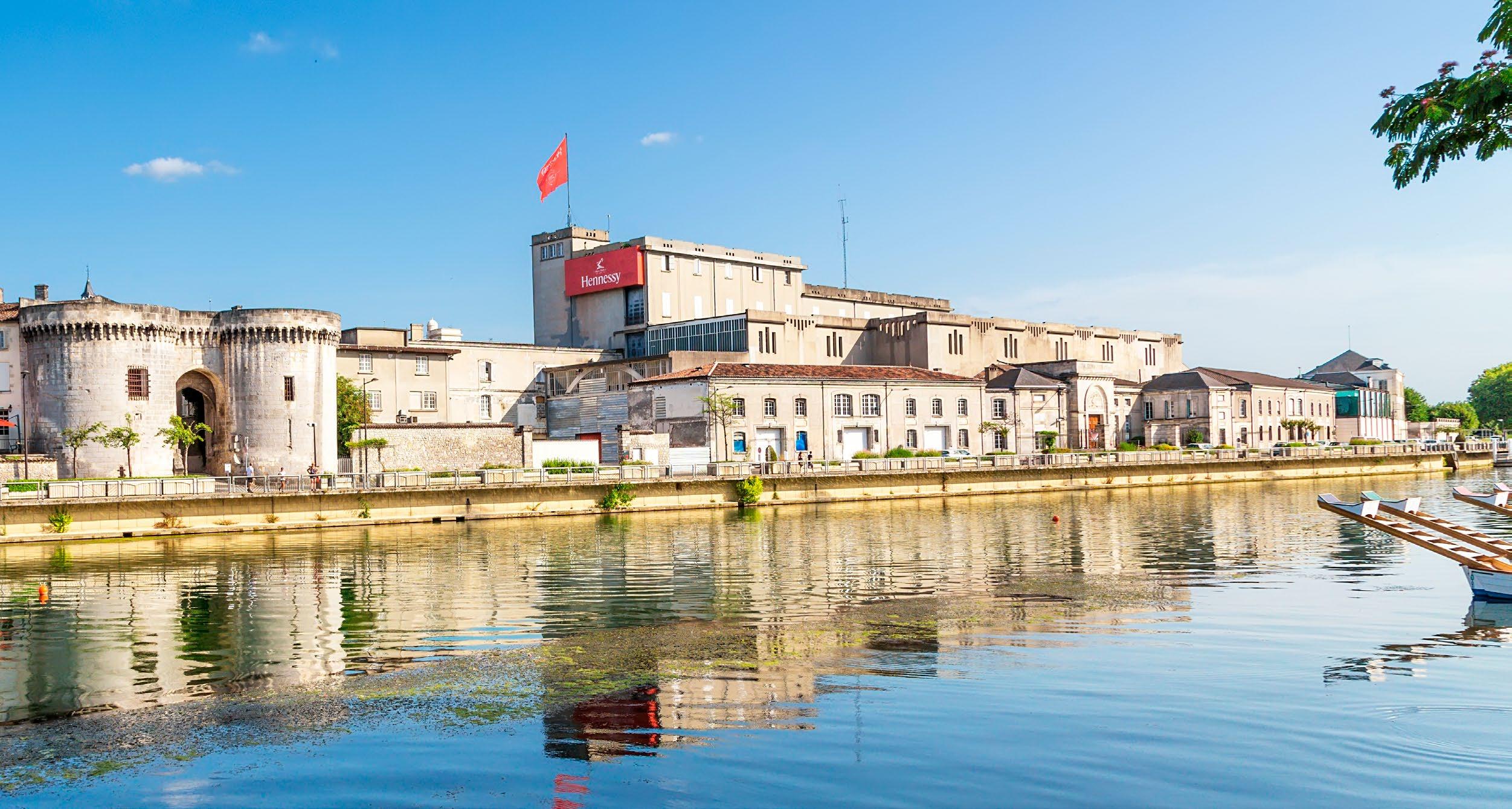
| Page 57
Cognac’s quayside is an important part of the cognac story
All aboard Charente’s La Demoiselle
...or explore the Marais Poitevin at your own pace
À BIENTÔT!



We’re just scratching the surface here! Our region’s got a treasure trove of history and jaw-dropping sights we’re itching to share with you. We hope you’ve loved our 2023 Summer Guide - don’t be shy, we’d love to hear your thoughts on our social media platforms. Every two months, we roll out a new edition of Living Magazine, packed with deep dives into the region and spectacular photography. Want a regular supply of Poitou-Charentes goodness and history lessons? Just hit the subscribe button on our website: www.livingmagazine.fr

Got a business or a tourist spot you’d like to get in the limelight, particularly for our English-speaking friends? Don’t hesitate to reach out. We keep this guide fresh throughout the summer, so there’s always room for more. Click a link below to get the ball rolling. We always welcome any feedback you have, just email editorial (at) livingmagazine.fr or visit our website and use our ‘Contact Us’ form.

Living Magazine Summer Guide 2023
www.livingmagazine.fr EVERY ISSUE IS FILLED WITH SUNSHINE READ ONLINE, PICK UP A COPY OR SUBSCRIBE TODAY YOU WON'T WANT TO MISS AN ISSUE! www.livingmagazine. fr




















































































 Saint-Savinien on the River Charente
Saint-Savinien on the River Charente











 Cycling over the Charente near Jarnac
Cycling over the Charente near Jarnac
 Château de La Rochefoucauld
Château de La Rochefoucauld








 Stop for a photo at beautiful Angles sur Anglin
Stop for a photo at beautiful Angles sur Anglin





































